Welcome to the Provenance Researchers of the Prussian Cultural Heritage Foundation!
Every object has its own history, which begins long before it arrives in a library or museum, often along a winding path. Previous owners, changes of location and different collection contexts can leave many traces - not least on the objects themselves. But often the events worth telling about a provenance receive little attention and are forgotten over the years.
The task and goal of provenance research at museums, libraries and archives is to bring these past, hidden and sometimes deliberately concealed stages in the biography of books, works of art and everyday objects, their history and stories back to light and to make visible not only the things themselves but also the places and people associated with them. Layer by layer, the provenance researchers work their way through the ages, moving along main and side paths, landing at dead ends and discovering many exciting, sometimes cruel and often touching episodes.
The cosmos of objects gathered under the umbrella of the Stiftung Preußischer Kulturbesitz, and thus, the diversity of the stories interwoven with them is unique worldwide.
With this virtual exhibition, we invite you to discover with us the paths and fates of the objects, to illuminate the people and places intertwined with them, and to look over our shoulders as we interpret often inconspicuous traces.
Join the Berlin provenance researchers at the Staatliche Museen and the Staatsbibliothek in their work!
Spotlight on the Object
PERSON, PLACE or THING
Staatsbibliothek zu Berlin – Preußischer Kulturbesitz
01
PERSON
Letter from Douwe Remmerssen to Paul Ortwin Rave
March 31, 1939
Aus der Sammlung von
Staatliche Museen zu Berlin, Zentralarchiv
Wie darf ich das Objekt nutzen?
Quelle
© Staatliche Museen zu Berlin, Zentralarchiv
Who was Douwe Remmersen?
In 1939, the Nationalgalerie acquired a drawing by Jakob Philipp Hackert for the "Sammlung der Zeichnungen" (Collection of Drawings). Its seller was a lawyer from Riga named Douwe Remmerssen – a man who, as a Nazi functionary and persecuted person, knew two sides of fascist despotism.
Landschaft mit Felsgrotte (Das Ohr des Dionysos) bei Syrakus
(Landscape with Rock Grotto (The Ear of Dionysus) near Syracuse)
Jakob Philipp Hackert, 1777
Aus der Sammlung von
Staatliche Museen zu Berlin - Kupferstichkabinett
Wie darf ich das Objekt nutzen?
Quelle
© Staatliche Museen zu Berlin - Kupferstichkabinett / Photo: Reinhard Saczewski.
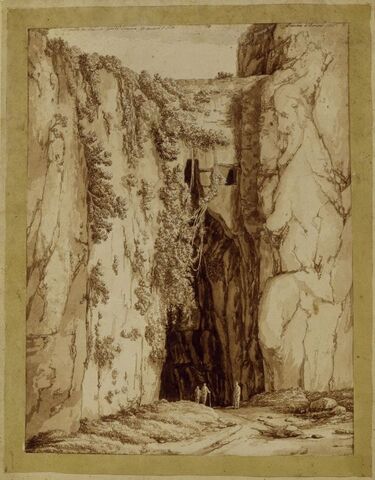
A Drawing from the Baltic States for Berlin
In early 1939, Paul Ortwin Rave, the director of the Nationalgalerie Berlin, received a visit from a gentleman from Riga. He introduced himself as Douwe Remmerssen and offered to sell him a drawing by Jakob Philipp Hackert, a painter of German classicism. He had acquired it from "gräflich Manteuffelschem Besitz" in Estonia. Rave wanted the drawing, although this meant for him having to overcome some bureaucratic hurdles at customs. This is how the Landscape with Rock Grotto (The Ear of Dionysus) near Syracuse ended up in the "Sammlung der Zeichnungen," which at the time belonged to the Nationalgalerie.
Paul Ortwin Rave
June 1949
Aus der Sammlung von
Staatliche Museen zu Berlin, Zentralarchiv, Fotosammlung.
Wie darf ich das Objekt nutzen?
Quelle
© Staatliche Museen zu Berlin, Zentralarchiv
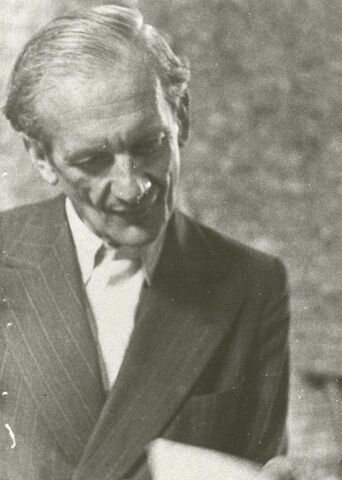
The "Sammlung der Zeichnungen" under Paul Ortwin Rave
Paul Ortwin Rave had been director of the Nationalgalerie since 1937. Thus, the "Sammlung der Zeichnungen" was also under his care. This collection of oil sketches, watercolors and drawings from the predominantly 19th and early 20th centuries was established as a separate department of the Nationalgalerie in 1878 due to a transfer from the former Königliches Kupferstichkabinett. Only in 1992 did this collection rejoin the Kupferstichkabinett. During the Nazi era, around 1,300 works were acquired for the "Sammlung der Zeichnungen".
Steinbrücke im Schweizer Hochgebirge (Stone Bridge in Swiss High Mountains)
Jakob Philipp Hackert, 1778
Aus der Sammlung von
Staatliche Museen zu Berlin, Kupferstichkabinett
Wie darf ich das Objekt nutzen?
Quelle
© Staatliche Museen zu Berlin, Kupferstichkabinett
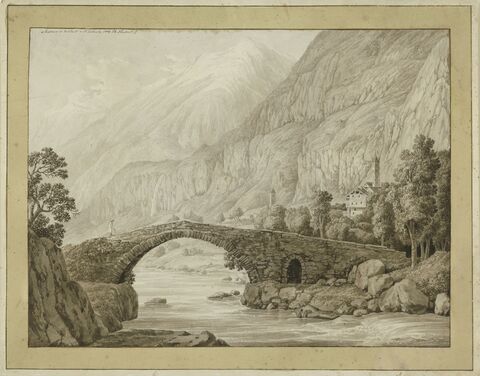
A second Offer
A few weeks after acquiring the Landscape with Rock Grotto, Remmerssen wrote Rave a letter from his hometown of Riga; he had another Hackert sheet that he could offer him. Although Rave found this drawing even better than the first, he regretfully declined. Customs clearance had been a bit too complicated for him the last time. At the end of the year, however, Rave was able to have the Stone Bridge in the Swiss High Mountains entered in the inventory book as a new acquisition. Remmerssen had moved to Berlin with the drawing. His address was now: "Berlin, Foreign Office".
Passport photo Douwe Remmerssen
around 1939
Aus der Sammlung von
Political Archive of the Federal Office of Foreign Affairs, Berlin
Wie darf ich das Objekt nutzen?
Quelle
© Politisches Archiv des Auswärtigen Amts, Berlin/ Photo: Staatliche Museen zu Berlin
Kurzbeschreibung

Douwe Remmerssen
Remmerssen was born in Moscow on October 27, 1904. His German-Baltic parents had him baptized as a Protestant. As a teenager he moved with them to Riga. After studying law at various European universities, he opened his own law office in Riga. In 1939 he toyed with the idea of moving to Germany. He travelled to Berlin several times – one of these stops took him to Rave's museum office – to sound out the situation. He finally decided in November 1939 to pack his bags and move to the German capital.
Berlin, Foreign Office
around 1935, Berlin
Aus der Sammlung von
Wie darf ich das Objekt nutzen?
Quelle
Bundesarchiv Fotograf: o.Ang.

Career under National Socialism
As a "Baltic repatriate", Remmerssen quickly and easily obtained German citizenship. He immediately applied for admission to the NSDAP. As a Baltic lawyer, he was not allowed to establish his own law firm. He would have been allowed to become a judge with retraining, but found a better-paid job as an interpreter at the Foreign Office because of his impressive knowledge of foreign languages.
Always a cosmopolitan, Remmerssen made many business trips on behalf of the Foreign Office starting in 1940. First he accompanied a delegation of the Reichspostministerium to Moscow. From September 1940 to January 1941, he was back in his old home town of Riga as a translator for a German-Soviet government delegation. In 1941 he was appointed to the "Sonderkommando Künsberg" - a brigade that carried out raids in the Eastern territories on behalf of the Reich. In 1943, he took over the leadership of the interpreter department of the Waffen-SS and in 1944 worked at the "Hauptamt Volksdeutsche Mittelstelle" in the German consulate in Marseille.
View over the moat and the electric fence to the barracks of Dachau concentration camp
Date of recording: April 29/30, 1945, Dachau Bavaria
Aus der Sammlung von
Wie darf ich das Objekt nutzen?
Quelle
©bpk-Bildagentur

The Turnaround
Remmerssen's life took a drastic turn in the summer of 1944. He was denounced for "homosexual activity" and "statements subversive to military morale". He was immediately dismissed from the party. The Gestapo arrested him in Marseille, took him to Paris and sentenced him to ten years in prison. He served his sentence in the SS penal camp Dachau.
In the Spruchkammer proceedings for the "denazification" of Germany, he was classified as a "blind follower". He was ordered to pay an "expiatory sum" of 300 marks into a reparation fund. He appealed against this verdict with reference to his imprisonment in Dachau. The proceedings were reopened and discontinued in 1951.
The artworks were examined in the project "Die Erwerbungen der ‚Sammlung der Zeichnungen‘ (ehem. Nationalgalerie) im Zeitraum 1933 bis 1945“ (The Acquisitions of the 'Collection of Drawings' (formerly part of the Nationalgalerie) in the Period 1933 to 1945) by Hanna Strzoda at the Kupferstichkabinett, Staatliche Museen zu Berlin.
The acquisition of these two Hackert drawings initially raised a lot of questions: Why did Remmerssen move to Berlin and what was he doing at the Foreign Office? Wasn't this office also involved in the National Socialist art theft, and was Remmerssen acting in accordance with his commission in this sale? In the end, research invalidated this concern. Remmerssen moved to Berlin voluntarily as a German-Baltic, long before the German occupation of Latvia. It was only some time after the sale of the drawings that he became a well-paid employee of German authorities, a participant in the Nazi art theft, and a few years later a persecuted person himself. Thus, in 1939, it was hardly out of existential need that he parted with the works of art that he himself had acquired from old Estonian aristocratic property.
Pierre Merrick - descendant of the American ethnologist Francis La Flesche close
Aus der Sammlung von
Wie darf ich das Objekt nutzen?
Quelle
© Christoph Mack
Francis la Flesche
In 1894, the Königliches Museum für Völkerkunde in Berlin commissioned the Indigenous ethnologist Francis La Flesche to assemble a collection that best represented his own culture, that of the North American Umóⁿhoⁿ.
Four years later, La Flesche sent 60 objects to Berlin. Along with extensive documentation in the form of a catalog.
Francis La Flesche
Aus der Sammlung von
National Anthropological Archives, Smithsonian Institution
Wie darf ich das Objekt nutzen?
Quelle
©National Anthropological Archives, Smithsonian Institution
Kurzbeschreibung
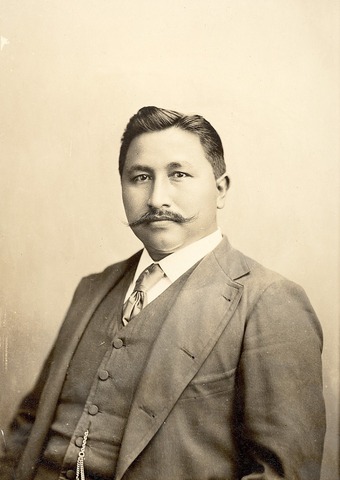
Francis La Flesche (1857–1932) is today considered North America's first Indigenous ethnologist. Raised on the Omaha Reservation, La Flesche attended Presbyterian boarding school, following his father's wishes. After successfully completing his law degree in Washington, D. C., Francis La Flesche assisted Ponca Chief Standing Bear in his fight for recognition of civil rights for all Native Americans in the United States. This experience shaped his later work as a scholar and political activist. In the 1880s, Francis La Flesche met ethnologist Alice Fletcher, who encouraged him to study Ethnology. Together they wrote the book "The Omaha Tribe," which is still considered a standard ethnological work on the Umóⁿhoⁿ.
Catalog by Francis La Flesche.
Aus der Sammlung von
Staatliche Museen zu Berlin - Ethnologisches Museum
Wie darf ich das Objekt nutzen?
Quelle
© Staatliche Museen zu Berlin, Ethnologisches Museum
Francis La Flesche is not without controversy to this day. Through his role as an ethnologist and community insider, he had access to many culturally sensitive areas and data that he made available to science and museums. Did he do the right thing by keeping the objects safe for later generations, or did he betray his community by taking the objects to a museum for his own benefit?
The Feathered Headdress of the Umóⁿhoⁿ in the repository of the Ethnologisches Museum
Francis La Flesche , Collector
Omaha ( Ethny), (1857 - 1932)
Aus der Sammlung von
Wie darf ich das Objekt nutzen?
Quelle
© Christoph Mack
Kurzbeschreibung
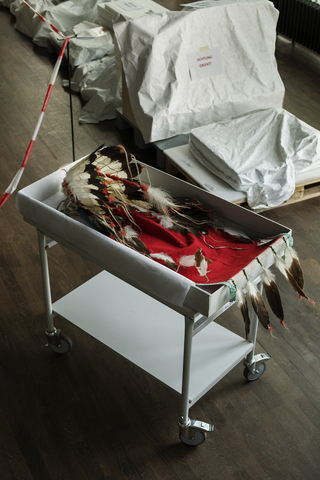
Mon-'shon-pa-gdhon (feathered headdress) of the Umóⁿhoⁿ
The feather headdress, which must have been of particular importance to La Flesche, is mentioned right away as the first object in his catalog:
“The articles collected to illustrate as far as possible the life and customs of the Omaha Tribe of North American Indians and have all been gathered from the Indians themselves, or made by them after the ancient customs of the people. The Eagle Feather War-bonnet was made by a number of old Indian warriors in the ceremonial manner, War Honors were counted upon each feather and the ritual songs sung.”
Pierre Merrick - descendant of the American ethnologist Francis La Flesche close
Aus der Sammlung von
Wie darf ich das Objekt nutzen?
Quelle
© Christoph Mack

After Francis La Flesche sent the collection to Berlin in the 19th century, Pierre Merrick is the first Umoⁿhoⁿ to touch the objects in more than a hundred years.
“The man that wore that must have been a kind of man that we don’t have in our tribe today. Because of the deeds that he had to do to be recognized as a chief, as a leader, it takes a lot of sacrifice to get to that point. Many of the objects, for example the feather headdress, that used to belong to a chief, don’t exist anymore at home. The only place you can find them is here in Berlin.”
Representatives of the Umóⁿhoⁿ in the depot rooms of the Ethnological Museum of the National Museums in Berlin/ Dahlem
Aus der Sammlung von
Ethnologischen Museum der Staatlichen Museen
Wie darf ich das Objekt nutzen?
Quelle
© SHF
Kurzbeschreibung
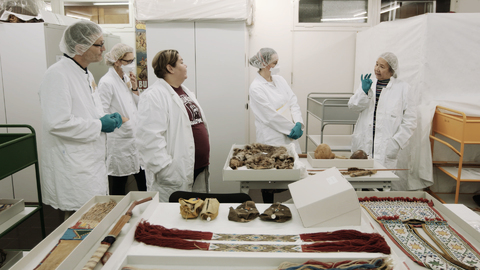
Past, Present, and Future of the Umóⁿhoⁿ Community
The experiences of racism, violence, and land loss continue to shape the Umóⁿhoⁿ community today. In this context, the Berlin collection is of particular importance because it bears witness to resistance against colonization. It offers people the opportunity to reconnect with their ancestors and ways of life and to look with pride at their own history.
The collaboration between the Ethnologisches Museum and the Nebraska Indian Community College shows how forward-looking provenance research on ethnological collections can be, and how collections can thereby be reactivated to conduct collaborative research on the objects and the themes that surround them.
Ilja Labischinski works as a provenance researcher at the Zentralarchiv der Staatlichen Museen zu Berlin on the collections of the Ethnologisches Museum and is curator of the exhibition "Francis La Flesche," which will open at the Humboldt Forum in 2022.
Achille Le Roy, Le droit au bonheur. Droit au repos, Paris: Librairie socialiste internationale, 1908
Aus der Sammlung von
Wie darf ich das Objekt nutzen?
Quelle
SBB
Bruno Kaiser and the Socialistica from the Institut für Sozialforschung
In the German Democratic Republic (GDR), the literary scholar, Marxist and librarian Bruno Kaiser (1911-1982) built up a library specialized in the History of Socialism and the Labor Movement at the Central Committee of the Sozialistische Einheitspartei Deutschlands (SED – Socialist Unity Party of Germany). In the process, socialistica holdings from libraries confiscated under the Nazi regime suddenly became a focus of interest.
Bruno Kaiser
Aus der Sammlung von
Manfred Krause
Wie darf ich das Objekt nutzen?
Quelle
Foto: Manfred Krause
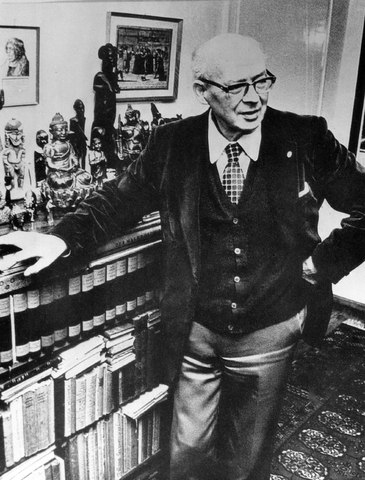
Bruno Kaiser - Literary Scholar, Marxist, Librarian and Bibliophile
Both personally and professionally, Bruno Kaiser was driven by the urge and passion to collect books. Already in his youth he began to build up a private library. Due to his involvement in the anti-fascist resistance and the distribution of illegal leaflets, as well as his Jewish origin, he was compelled to emigrate to Switzerland after being arrested, tortured and interned under the Nazi regime. He engaged in scientific research on socialism and was later recognized in the GDR for his Marx-Engels research.
Bruno Kaiser returned to Germany in 1947. In his position as department director of the Öffentliche Wissenschaftliche Bibliothek (Public Research Library), the successor institution to the Preußische Staatsbibliothek (Prussian State Library) in East Berlin, he cared for the unprocessed holdings.
In 1949, he took over the establishment and management of the new specialized research library, which was founded at the Berlin Institut für Marxism-Leninism by a decision of the SED party leadership. In order to quickly build up the new library from scratch, recourse was made to the unprocessed holdings in the cellars of the former Preußische Staatsbibliothek – including part of the library of the Institut für Sozialforschung in Frankfurt am Main and thus Nazi-looted books.
Platon Michajlovič Keržencev , Čemu učit Lenin (=What Lenin teaches us), Leningrad u.a.: Gosizdat, 1925
Aus der Sammlung von
Wie darf ich das Objekt nutzen?
Quelle
SBB
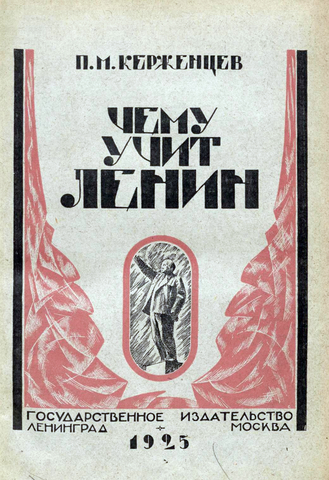
Socialistica under new Signs in the GDR
Large specialized scientific libraries, such as those of the Institut für Sozialforschung in Frankfurt am Main, and also the libraries of politically persecuted parties, trade unions and workers' organizations fell victim to confiscation under the Nazi regime. Various Nazi institutions were also interested in the Socialistica, using the holdings as research sources for intelligence purposes. The collections were therefore frequently broken up and redistributed.
In the GDR, Socialistica were finally evaluated in a new light. The scientific study of socialism and the workers' movement was politically encouraged. The Socialistica holdings of confiscated and dispersed libraries were used to build up new libraries. Even though other distribution mechanisms took effect than under the Nazi regime, the collections remained shattered after 1945.
Stamp of the library of the Instituts für Sozialforschung in Frankfurts a. M. (=Institute for Social Research in Frankfurt a. M.)
Aus der Sammlung von
Wie darf ich das Objekt nutzen?
Quelle
SBB
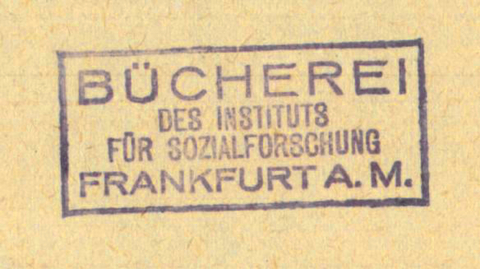
Confiscation and Destruction of the Library of the Institut für Sozialforschung in Frankfurt am Main in 1933
The Institut für Sozialforschung was founded in 1923 and was dedicated to the theory and history of socialism, Marxism and the labor movement. A library focussed on socialism and communism was built up, and its holdings grew to as many as 40,000 volumes by 1933. Under the Nazi regime, the Institute was dissolved in 1933 and the library was confiscated because it contained „subversive materials”.
While the institute continued its work abroad, the library was dismantled. About 20,000 volumes of "anti-state and subversive" literature were given to the Preußische Staatsbibliothek as the central receiving and distributing institution of literature confiscated in Prussia. The "unobjectionable" remaining stock was taken over by Frankfurt institute and seminar libraries.
Although the Preußische Staatsbibliothek began to incorporate the acquired books and exchanged duplicates with the Reichssicherheitshauptamt (Reich Security Main Office), most of them were stored unprocessed in the cellars of the Staatsbibliothek zu Berlin during World War II.
N. Bervi-Flerovskij, Zapiski revoljucioneramečtatelja (= Records of a revolutionary hobbyist), Moskau: Molodaja Gvardija, 1929
Aus der Sammlung von
Wie darf ich das Objekt nutzen?
Quelle
SBB
Kurzbeschreibung
After 1945, the holdings of the Institut für Sozialforschung, which had been taken over by the Preußische Staatsbibliothek, were further torn apart. Volumes that had been displaced due to the war were destroyed or taken away to Polish and Soviet institutions. Books exchanged with the Reichssicherheitshauptamt ended up in the redistribution processes initiated by the Bergungsstelle für wissenschaftliche Bibliotheken (Salvage Office for Academic Libraries) and later by the Zentralstelle für wissenschaftliche Altbestände (Central Exchange Office for Academic and Research Libraries). A large number of volumes were handed over to the new SED library. Only a fraction of the volumes were incorporated before and after 1945 and remained in the Staatsbibliothek itself.
The whereabouts of the library of the Institut für Sozialforschung has not been fully clarified to this day. The extent to which volumes of the Institut für Sozialforschung were transferred from the Preußische Staatsbibliothek to the new library of the Institut für Marxism-Leninism and are therefore now in the library of the Stiftung Archiv der Parteien und Massenorganisationen der DDR (SAPMO – Foundation Archives of Political Parties and Mass Organizations of the GDR) in the Federal Archives still needs to be explored in more detail. Bruno Kaiser's role in the redistribution also requires further investigation.
The Staatsbibliothek zu Berlin, as the successor institution to the Preußische Staatsbibliothek, has been assigned the volumes remaining in the collection from the Institut für Sozialforschung and pursued them as part of the research project "Transparenz schaffen: Recherche, Erschließung und überregionaler Nachweis von NS-Raubgut im Druckschriftenbestand der Staatsbibliothek zu Berlin“ (Creating Transparency. Identification and Indexing of NS-Looted Books in the Collection of Printed Books of the Staatsbibliothek zu Berlin).
Under difficult conditions - the accession journal has unfortunately not survived - particularly suspicious accessions were examined. In the process, in August 2018, 536 volumes from the library of the Institut für Sozialforschung, which was confiscated in 1933, were identified and restituted to the institute, which returned to Frankfurt in 1951.
The author Friederike Willasch is a research assistant in the Abteilung Historische Drucke (Department of Early Printed Books) at the Staatsbibliothek zu Berlin.
Queen Olugondo of Ondonga, Okadina
Hermann Tönjes (Collector), 1909
Aus der Sammlung von
Staatlichen Museen zu Berlin – Ethnologisches Museum
Wie darf ich das Objekt nutzen?
Quelle
Staatlichen Museen zu Berlin – Ethnologisches Museum / Photo: Claudia Obrocki
Queen Olugondo of Ondonga
What forms of contact were women able to make during the colonial period? Queen Olugondo of Ondonga, a kingdom in the north of present-day Namibia, and Anna Rautanen, daughter of a Finnish missionary, shared an extraordinary friendship. An intricately crafted doll in the collection of the Ethnologisches Museum Berlin provides insight into their relationship.
Chief Kambonde II von Ondonga
Aus der Sammlung von
Verlag von Martin Warneck
Wie darf ich das Objekt nutzen?
Quelle
Photo: Tönjes, Hermann
Kurzbeschreibung
(Land. People. Mission)

The Gift of a Queen
Queen Olugondo was the principal wife of King Kambonde (II) kaMpingana, who ascended the throne of Ondonga in 1884. Unlike the rulers in the neighboring Ovambo kingdoms, he supported the Finnish missionaries who had been trying to convert the population to Christianity since 1870. Hence, Queen Olugondo and Anna Rautanen knew each other since Anna’s childhood days, which she spent in the kingdom as the daughter of the missionary Martin Rautanen.
With the help of Nehoa Kautondowka, Chief Education Officer for Culture at the Namibia Commission for UNESCO and visiting scholar at the Ethnologisches Museum Berlin, we were able to retrace the relationship between the two women: As a child, Anna owned a European doll. When she returned to the Kindgom of Ondonga after a school stay in Finland, she had left the doll there, as adult women in Europe no longer played with dolls. In the Kingdom of Ondonga, however, they were much more than toys. They were an important part of a woman's growing up. Girls received dolls as gifts from their parents. At the engagement, the groom gave his future wife's doll a name to be given to the couple's first child. Now, in 1900, Anna was about to marry the German missionary Hermann Tönjes in the Kindgom of Ondonga. But was Anna to marry without an "Okana" (child), the Oshidonga name for such dolls?
Queen Olungondo made (or had made) an “Okanda” for Anna after the latest fashion of the kingdom and gave the doll her name. Thus, the queen and the doll became "Okadina" or namesakes. Queen Olugondo and Anna had thus established a relationship that would endure through Anna's marriage and departure from the kingdom.
Queen Olugondo of Ondonga, Okadina,
Hermann Tönjes (Collector), 1909
Aus der Sammlung von
Ethnologisches Museum der Staatlichen Museen zu Berlin - Preußischer Kulturbesitz
Wie darf ich das Objekt nutzen?
Quelle
Ethnologisches Museum der Staatlichen Museen zu Berlin - Preußischer Kulturbesitz Fotograf/in: Claudia Obrocki

Okadina - Expression of Royal Fashion
The Okadina doll was not only the sign of a long-standing friendship between two women. It was also an expression of the fashion and prestige of the royal court of Ondonga. Hertha Bukassa, cultural officer at the Ministry of Education, Arts and Culture of the Republic of Namibia and visiting scholar at the Ethnologisches Museum in Berlin, explains the significance of the individual fashion elements:
Onjeva was and is an adornment made of ostrich eggshells that young girls wear around on their hips; oshilanda, valued dark blue glass beads, adorn her upper body; a number of large buttons imported from Europe serve as surrogates for the precious and scarce omba, a jewelry made of ivory or shell.
Queen Olugondo thus processed only the most precious materials to express her appreciation for Anna.
Press conference September 18, 2019, Foyer of the Museum Dahlem
Golda Ha-Eiros, Curator for Liberation Heritage under the Office of Vice-President: Veterans Affairs, September 18, 2019, Foyer of the Museum in Berlin Dahlem
Aus der Sammlung von
Staatliche Museen zu Berlin - Ethnologisches Museum
Wie darf ich das Objekt nutzen?
Quelle
© SPK/photothek.net/Florian Gärtner
Kurzbeschreibung
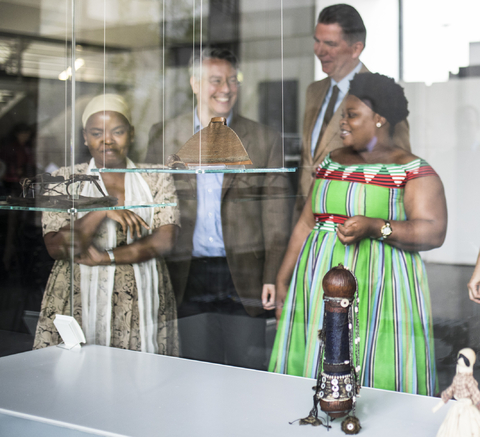
Okadina can be considered an archive of Namibian fashion. The clothing, with some modifications, is still worn by women in the Ondonga Kingdom today, linking the past with the present.
Statement by Nehoa Hilma Kautondokwa, Museum Development Manager of the Museums Association of Namibia and visiting scholar at the Ethnologisches Museum in Berlin.
Nehoa Hilma Kautondokwa, Cynthia Schimming and Julia Binter with Okadina in the depositories of the Staatliche Museen zu Berlin – Ethnologisches Museum
2019, Berlin
Aus der Sammlung von
Staatliche Museen zu Berlin – Ethnologisches Museum
Wie darf ich das Objekt nutzen?
Quelle
Filmstill from Tracing Namibian-German. Photo: Moritz Fehr
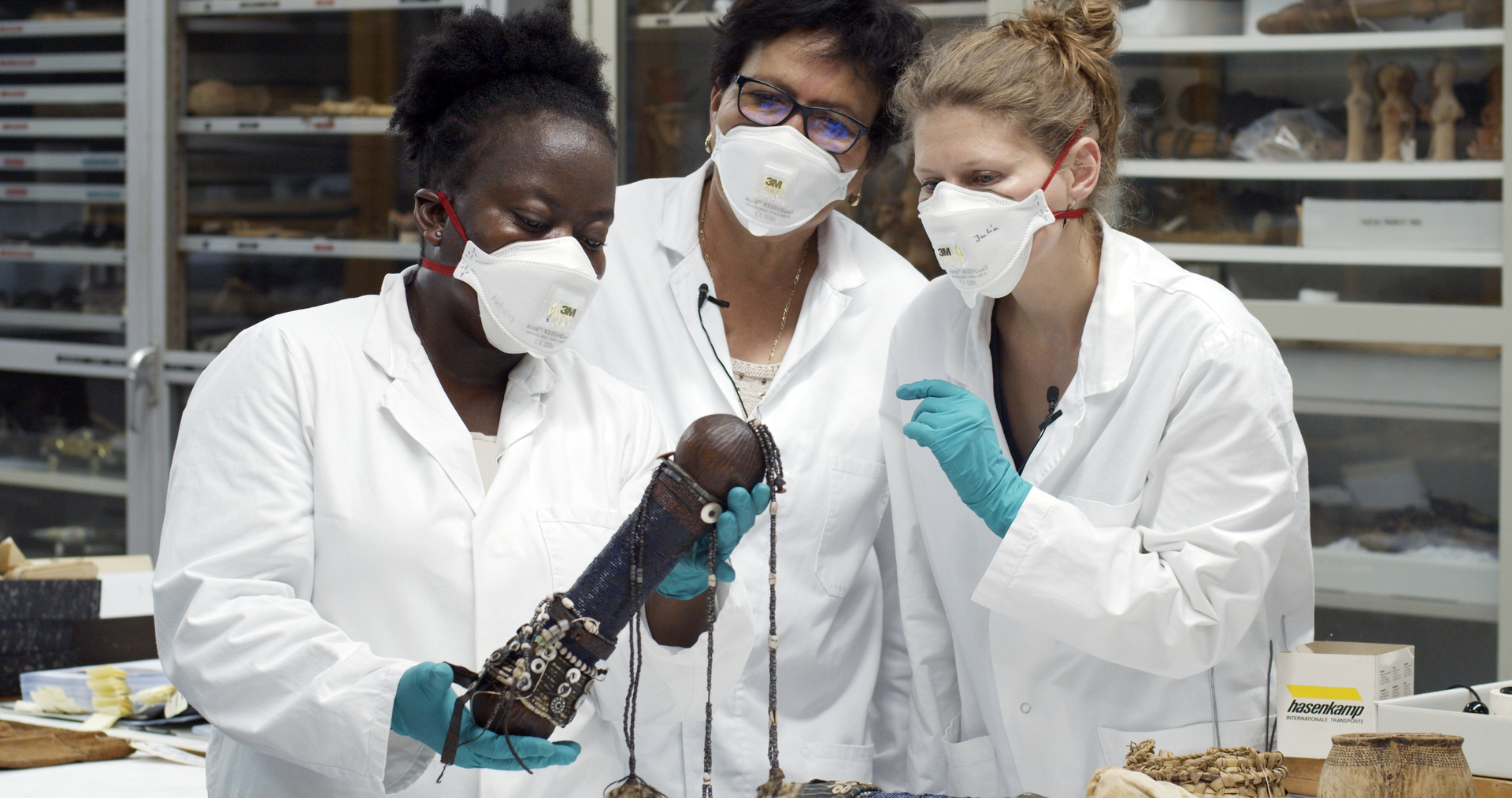
We were only able to reconstruct Okadina's multi-layered meanings thanks to the collaborative research with experts from Namibia, who visited Berlin in 2019 as part of a cooperation between the Ethnologisches Museum Berlin and the Museums Association of Namibia. Our collaborative research has shown that Okadina was much more than a doll that Anna's husband, Hermann Tönjes, sold to the Königlichen Museum für Völkerkunde (now Ethnologisches Museum zu Berlin) in 1909. It tells of the friendship of two women, their coming of age, and the fashions of their time.
Julia Binter works as a provenance researcher at the Zentralarchiv der Staatlichen Museen zu Berlin where she is currently leading the cooperative project on the collections from Namibia at the Ethnologisches Museum.
Alfred Flechtheim
1928
Aus der Sammlung von
Museum für Kunst und Gewerbe Hamburg
Wie darf ich das Objekt nutzen?
Quelle
© Museum für Kunst und Gewerbe Hamburg / Photo: Hugo Erfurth
Alfred Flechtheim and Paul Klee's Gingerbread Picture
The passionate modernist art dealer and owner of popular galleries in Düsseldorf and Berlin was confronted by the National Socialists at an early stage. In addition to his commitment to artists such as Picasso, Grosz and Kandinsky, he was also targeted because of his Jewish origin. In 1934, persecution forced him into emigration. He reached London via Paris. Impoverished and separated from his wife in Berlin, and without legal residence status, Alfred Flechtheim died there in 1937 at the age of 59 as the result of an accident.
Paul Klee - Gingerbread picture back
Aus der Sammlung von
Staatliche Museen zu Berlin – Nationalgalerie, Museum Berggruen
Wie darf ich das Objekt nutzen?
Quelle
© Staatliche Museen zu Berlin, Nationalgalerie / Photo: Andres Kilger
Paul Klee's Gingerbread Picture
Today the works of art that Alfred Flechtheim traded and owned still bring his tragic fate to mind and keep the memory of the influential gallery owner alive. Provenance research has a special task in this regard: in order to locate cultural property seized as a result of persecution, it is obliged to clarify the exact circumstances under which these works of art that passed through Flechtheim's hands were traded.
One of these works is Paul Klee's 1925 Gingerbread Picture from the holdings of Museum Berggruen, as attested by a sticker from his gallery on the back of the painting.
Paul Klee's gingerbread picture
Aus der Sammlung von
Staatliche Museen zu Berlin – Nationalgalerie, Museum Berggruen
Wie darf ich das Objekt nutzen?
Quelle
© Staatliche Museen zu Berlin – Nationalgalerie / Photo: Andres Kilger
Kurzbeschreibung

Before 1945, the Gingerbread Picture had travelled a lot. Klee owed this above all to Flechtheim's commitment, as he represented the artist as a dealer.
At the Große Kunstausstellung in Düsseldorf in 1925, he presented Klee's picture to the public for the first time. In 1926, exhibitions followed in Dresden, Wiesbaden and Zurich, the following year again in Düsseldorf, this time in his own gallery, as well as in Mannheim and Paris. Further shows were mounted in Berlin, Brussels and Antwerp. The back of the small oil-collage also documents presentations in 1930 at the Museum of Modern Art in New York and after 1945 in Milan and Bern.
Excerpt from MoMA Catalog
1930
Aus der Sammlung von
Staatliche Museen zu Berlin – Kunstbibliothek
Wie darf ich das Objekt nutzen?
Quelle
© Staatliche Museen zu Berlin – Kunstbibliothek
Kurzbeschreibung
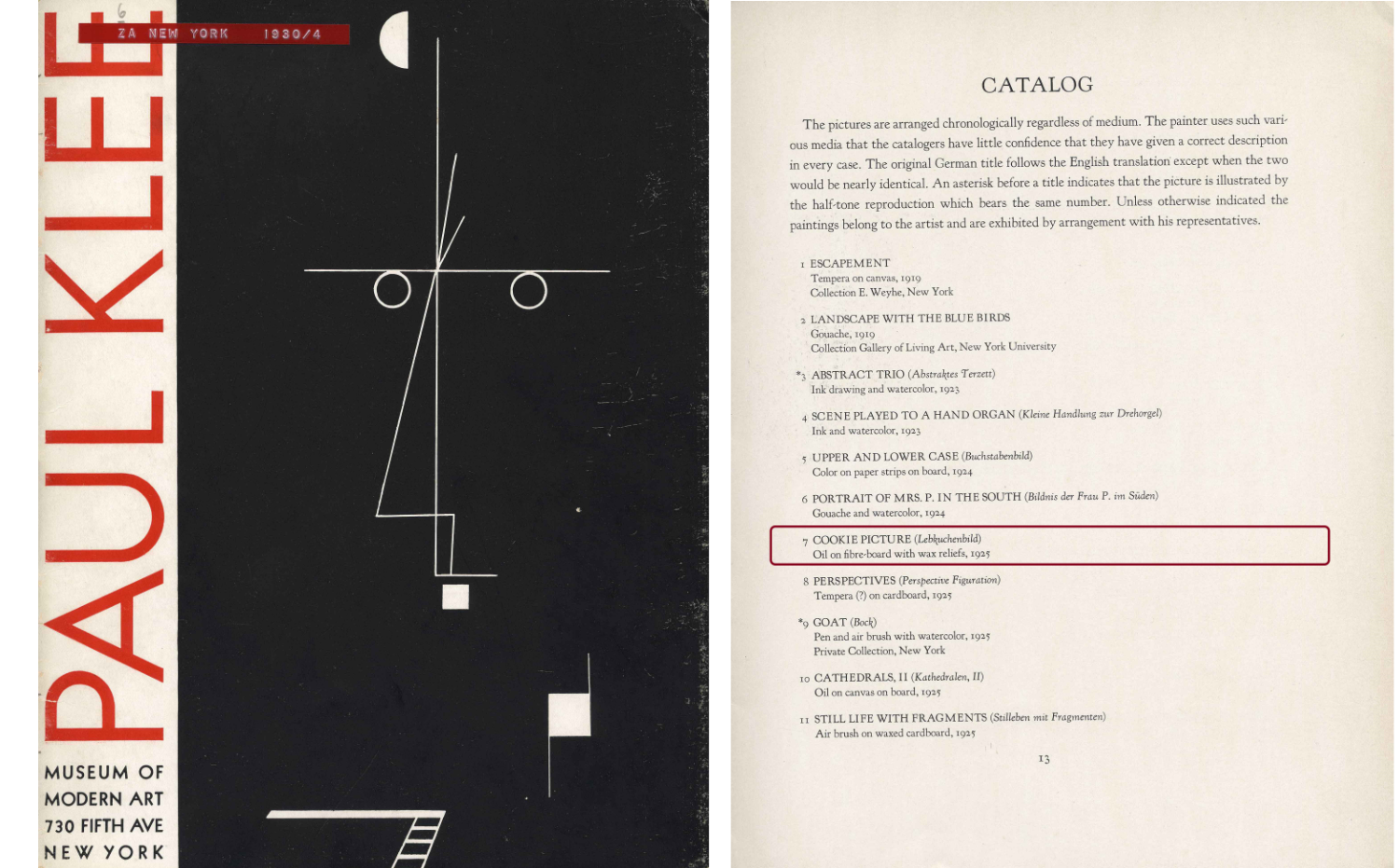
File
Aus der Sammlung von
Staatliche Museen zu Berlin – Zentralarchiv
Wie darf ich das Objekt nutzen?
Quelle
© Staatliche Museen zu Berlin – Zentralarchiv
Kurzbeschreibung
Inspector Bähr
Please send the four pictures to Paul Klee
"Picture with the cock and the grenadier" 1919
"The Fool" 1927
"Gingerbread picture" 1925
"Letter image" 1924
To Prof. Paul Klee, Düsseldorf, Heinrichstr. 36
to send
September 20, 1933
Hentzen
3/10.33 The above-mentioned paintings
are sent back to the owner today.
Bähr
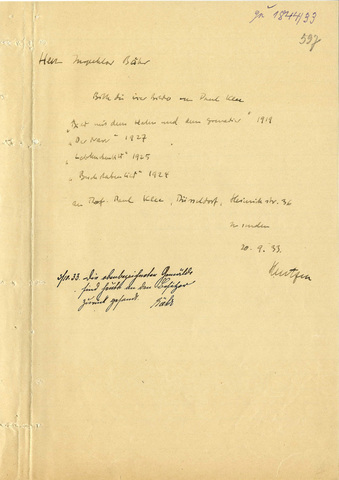
To the question of whether the work has a problematic provenance, a document in the Zentralarchiv der Staatlichen Museen zu Berlin (Central Archive of the National Museums in Berlin) provides a clear answer: The Berlin Nationalgalerie also exhibited the painting. In 1933, the year the National Socialists seized power, it was returned directly to Paul Klee on September 20, probably also to prevent the confiscation of the now outlawed art. In the letter, the curator Alfred Hentzen asked that the painting be returned along with three other loans, which the depot administrator Bähr confirmed with a note at the bottom of the document. To that date, Flechtheim held the painting on consignment and was trying to sell it on behalf of the artist and owner Paul Klee.
At this time, Klee had already been dismissed from his professorship at the Düsseldorf Art Academy and moved to Switzerland with his wife. The Gingerbread Picture accompanied them and remained in the family until after World War II. Its varied exhibition history with 15 presentations in eight years, decisively set in motion by Flechtheim, was over for the time being. The fact that he managed to arrange the loan to the Nationalgalerie, but was unable to conclude it, illustrates the abrupt and bitter end of his work, which without provenance research as such would probably be forgotten today.
Paul Klee, Three times Three crosses
Aus der Sammlung von
Staatliche Museen zu Berlin – Nationalgalerie, Museum Berggruen
Wie darf ich das Objekt nutzen?
Quelle
Staatliche Museen zu Berlin – Nationalgalerie / Photo: Andres Kilger
Known and unknown provenances
As in the case of the Gingerbread Picture, it is not always possible to establish a continuous chain of provenance for researched artworks. Gaps often remain because not all of the previous owners can be determined.
An example of these remaining gaps is Paul Klee's painting Three times Three Crosses in the Museum Berggruen. This painting also has a Flechtheim provenance and its circumstances are still unclear even after extensive research.
Since an initial suspicion could not be dispelled, the work was reported in the Lost Art database.
Gingerbread Picture: 1925 to 1940 Paul Klee, Düsseldorf, Bern | latest 1927 to 1932 Galerie Alfred Flechtheim, Düsseldorf, Berlin (on consignment) | 1930 J. B. Neumann, New York (on consignment) | 1940 to 1946 Lily Klee, Bern | 1946 to 1947 Klee Society, Bern | 1947 Karl Nierendorf, Berlin, New York | to 1954 Carlo Frua de Angeli, Milan | 1954 to 1957 Galerie Feilchenfeldt, Zurich | since 1957 Werner Josten, New York | Eugene Victor Thaw & Co, New York | 1989 David Carritt Ltd., London | Acquavella Galleries, New York | Stephen Mazoh & Co., Rhinebeck | 1988 to 1990 Heinz Berggruen, Paris | 1990 to 1998 BIGI Co., LTD., Tokyo | 1998 to 2000 Heinz Berggruen
Three times three Crosses: 1925 to 1929 Paul Klee, Weimar and Dessau | 1927 Galerie Alfred Flechtheim, Düsseldorf (on consignment) | 1927 to 1928 Rudolf Probst/Galerie Neue Kunst Fides, Dresden | 1928 to 1929 Galerie Alfred Flechtheim, Berlin (on consignment) | 1929 to no date Alfred Flechtheim, Berlin | until 1935 Dr. Bernatti | 1935 until no date. The Mayor Gallery, London | at least since 1941 Leicester Galleries, London | at least since 1946 The London Gallery, London | at least since 1951 until 1955 Curt Valentin Gallery, New York | 1955 until 1965 G. David Thompson, Pittsburgh | 1965 to 1966 G. David Thompson, Pittsburgh | Harry Torczyner, New York | until 1998 Marcelle Torczyner, New York | 1998 until 2000 Heinz Bergguen
Both artworks have been part of the Nationalgalerie’s holdings at Museum Berggruen since 2000.
The former collection of Heinz Berggruen was examined for its provenances from 2014 to 2018 as part of a project by Sven Haase and Doris Kachel. The results were presented in the exhibition The Lives of Images. Provenances at Museum Berggruen The Lives of Images. Provenances at Museum Berggruen Picasso – Klee – Braque – Matisse
Sven Haase, the author of this article is a provenance researcher of Europeen Fine Arts at the Zentralarchiv der Staatlichen Museen zu Berlin.
Mangi Marealle
Repro Digitalisat, Digitale Aufnahme, 1887
Aus der Sammlung von
SLUB / Deutsche Fotothek
Wie darf ich das Objekt nutzen?
Quelle
SLUB / Deutsche Fotothek / Meyer, Hans
Kurzbeschreibung
mangi Marealle of Marangu
In this photo from 1887, we see a young man sitting on a deck chair. He looks seriously and critically into the camera and remains at a dignified distance. His name is Melyari or Marealle, the "tireless one". Since about 1880 Marealle has been the ruler (mangi) of Marangu, which will become one of the most powerful empires in the Kilimanjaro region (in present-day Tanzania) during German colonial rule. Particularly striking in the photograph is the jewelry worn in the left ear. This or a similar one was entered in 1897 as a "wooden ring" under the number III E 4815 in the main catalog of the Königliches Museum für Völkerkunde Berlin.
Work Photo III E 4815
Aus der Sammlung von
Staatliche Museen zu Berlin – Ethnologisches Museum
Wie darf ich das Objekt nutzen?
Quelle
©Staatliche Museen zu Berlin – Ethnologisches Museum / Photo: Anna-Isabel Frank
Kurzbeschreibung
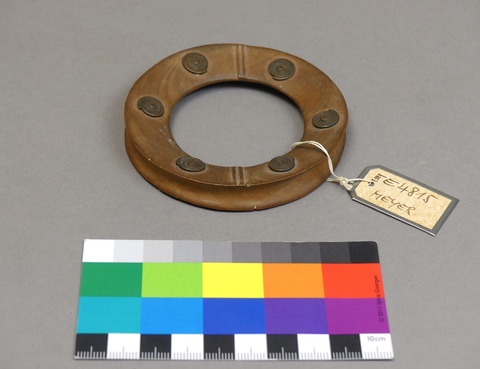
How exactly the ear jewelry, inventoried in the main catalog as a "wooden ring" came into the possession of the wealthy Leipzig publisher, geographer, historian, explorer, and later colonial politician Hans Meyer (1858-1929) cannot be proven on the basis of the sources reviewed so far. What was the significance and function of this object for Marealle and to what extent was it related to his position as mangi? Without answers to these questions, it is also impossible to clarify whether the object was considered alienable at all. The fact that Marealle handed over the jewelry could indicate how important he valued the relationship with Meyer, especially against the backdrop of the political power competition in the region.
Entry "Holzring“ (Wooden Ring III E 4815)
Aus der Sammlung von
Staatliche Museen zu Berlin – Ethnologisches Museum Berlin
Wie darf ich das Objekt nutzen?
Quelle
©Staatliche Museen zu Berlin – Ethnologisches Museum Berlin
Kurzbeschreibung
"Wooden ring decorated with small copper spirals, formerly worn by Chief Mareale of Marangu in the left earlobe. 8.9 cm diameter: Dschagga".

In the historical main catalog of the Ethnologisches Museum Berlin, Hans Meyer is noted as the donor. Marealle is named in the object description as the previous owner of the earring. Names are rarely mentioned among the more than 8,000 objects from mainland Tanzania that were appropriated during German and also British colonial rule. Most of the previous owners, users and producers of the objects remain anonymous. German or European "collectors" usually only mentioned East African dignitaries and related them to the objects. Some of these objects had trophy status for the colonizers. Women in positions of political power are generally rare in the colonial archives; they usually remain nameless or are absent altogether.
Book cover of Hans Meyer's "Zum Schneedom des Kilimandscharo", 1888
Aus der Sammlung von
Staatsbibliothek zu Berlin
Wie darf ich das Objekt nutzen?
Quelle
©Staatsbibliothek zu Berlin
Kurzbeschreibung
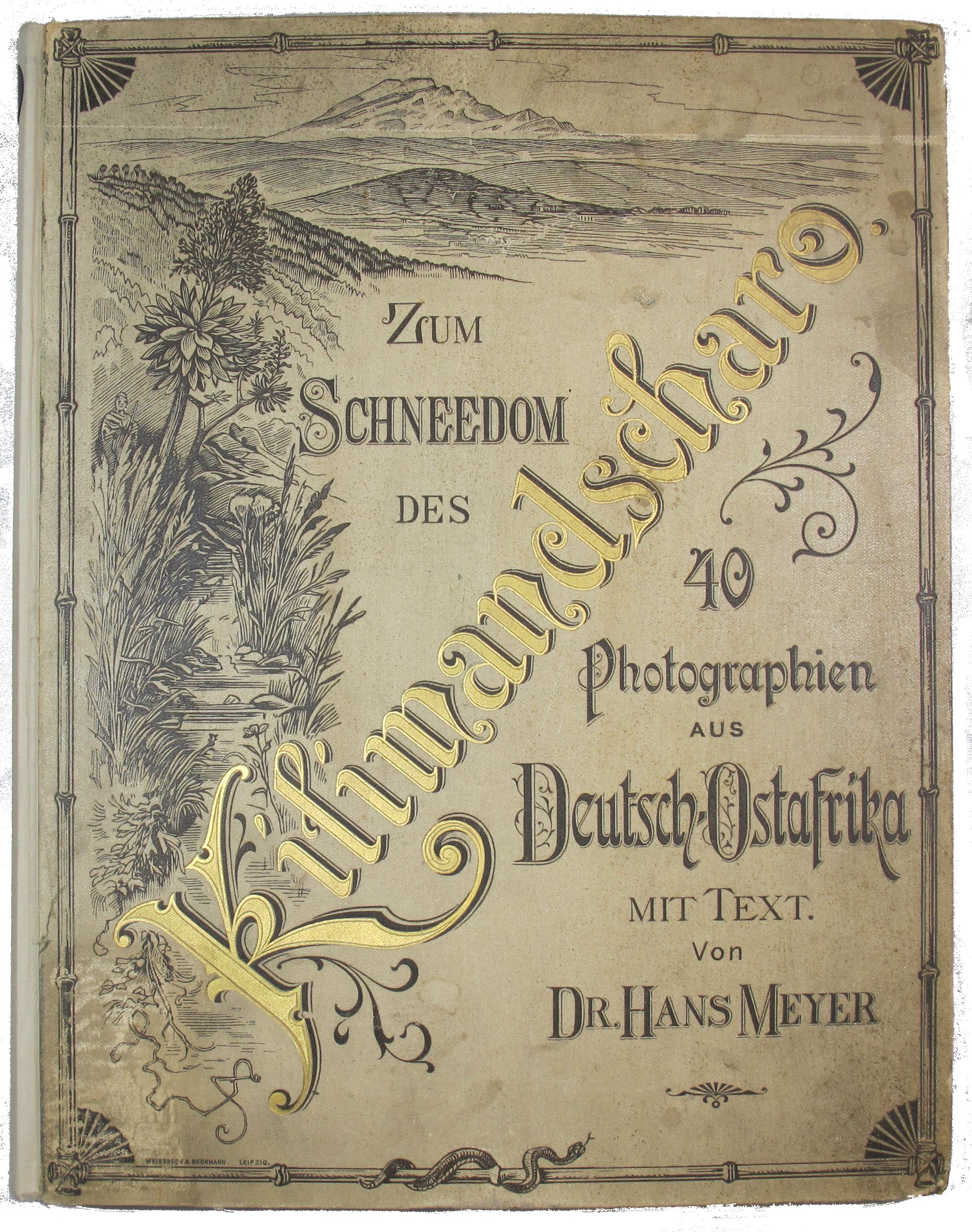
Who was Marealle? At the present stage of research, this question can only be answered in fragments and from a very Eurocentric perspective. The starting point is initially the "colonial archives," the acquisition files of the Ethnologisches Museum, travel descriptions such as the one published by Hans Meyer in 1888, and historical literature. When Marealle was installed as ruler of Marangu in about 1880, he was still penniless and Marangu as a political entity was without significance. Through a skilful marriage policy, he consolidated his position among the strongly competing rulers of the relatively densely populated Kilimanjaro region. He increasingly succeeded in this by welcoming Arab and Swahili traders as well as European and American travelers to Marangu and establishing relations with them.
"Meeting in Marangu"
Hans Meyer (photo), probably 1898, Marangu
Aus der Sammlung von
Wie darf ich das Objekt nutzen?
Quelle
Deutsche Fotothek
Kurzbeschreibung
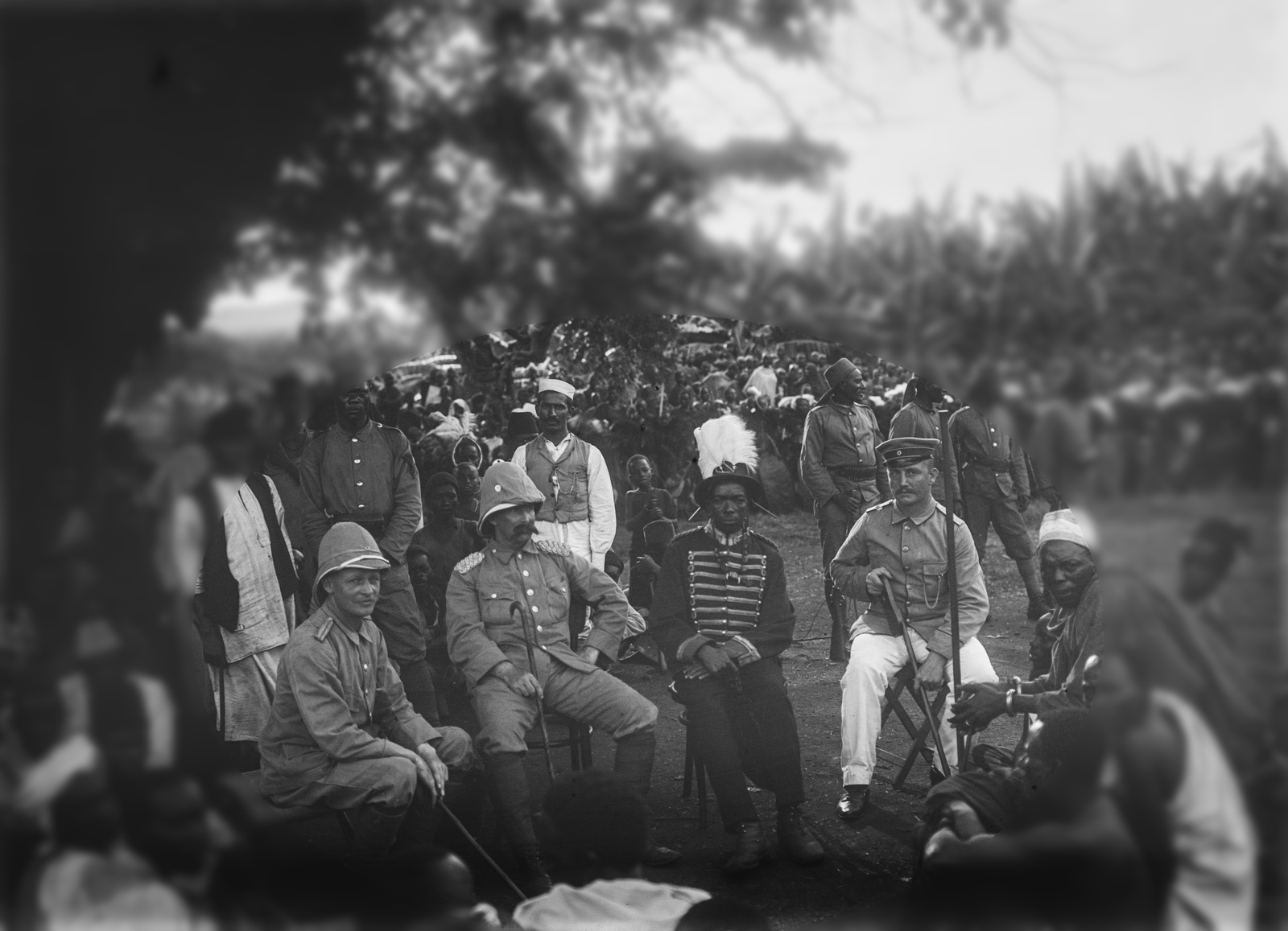
From the early 1890s, Marealle used his contacts with representatives of the colonial state to instrumentalize them in the interests of his power-political agenda. He discredited his rivals vis-à-vis the German colonizers and thus increasingly consolidated his position in the colonial ruling structure. Thus, in the 1890s, he finally advanced to become the most powerful mangi of the eastern Kilimanjaro region: He controlled 27 of the 44 small states of the Chagga living on Kilimanjaro and was given the name Kilamia, "the conqueror." But his position was also fragile, as he was dependent on the goodwill of the respective German station chiefs in Moshi. War campaigns against supposedly non-cooperating mangi as well as executions by the Germans were integral parts of colonial rule practices. Marealle finally abdicated in 1912.
List of gifts for mangi Marealle
Aus der Sammlung von
Staatsbibliothek zu Berlin
Wie darf ich das Objekt nutzen?
Quelle
©Staatsbibliothek zu Berlin
Kurzbeschreibung
The ear jewelry most likely came into Meyer's possession during his first stay on Kilimanjaro in 1887. He stayed with his caravan of about a hundred people for several weeks at Marealle's residence in Manrangu. Meyer depended on Marealle's support in his exploration of Kilimanjaro. He presented Marealle with gifts, including barter goods common in the area: Cloth, beads, and wire, as well as weapons and ammunition, knives, snuff, harmonicas, and champagne. In return, he received permission to climb Kilimanjaro as well as food to feed the expedition members. According to Meyer, Marealle gave him three spears as a gift; an ear ornament is not mentioned in the sources we have seen so far.
Expedition participants and members of the Maasai in front of a station building of the German East African Association (DOAG) in Moshi
Hans Meyer (photo), 1887, Moshi
Aus der Sammlung von
Wie darf ich das Objekt nutzen?
Quelle
SLUB/ Deutsche Fotothek

In 1889, during his second visit to Marangu, Meyer again emphasized his friendly and personal relationship with Marealle. He did so, however, in an arrogantly benevolent, colonial ideologically pejorative manner. Meyer saw himself as a representative of the German Reich and was probably perceived as such. Representatives of the German East African Association (DOAG) accompanied him on his first trip. The idea was to make territorial claims to the area. A dubious, so-called protection contract of the DOAG with the mangi Rindi of Moshi served as its basis. When Meyer toured the Kilimanjaro area and came into possession of the earring, the German presence was still fleeting and the DOAG station, established in 1887, was only sporadically manned. Meyer, supposed explorers, European missionaries and traders, and DOAG representatives were dependent on the goodwill and support of the mangi in the second half of the 1880s.
Kristin Weber-Sinn works as a provenance researcher at the Zentralarchiv der Staatlichen Museen zu Berlin on the collections of the Ethnologisches Museum.
Among other things, she is conducting research with colleagues from the National Museum of Tanzania and the University of Dar es Salaam on selected object holdings from Tanzania that are housed in the Ethnologisches Museum Berlin and the National Museum and House of Culture in Dar es Salaam (funded by the Gerda Henkel Foundation, in cooperation with the Humboldt-Universität zu Berlin).
The previous perspectives and results of provenance research, based on the "colonial archives," will not only be expanded through the cooperative research, but critically questioned.
02
PLACE
Floor plan Carinhall
1945
Aus der Sammlung von
Deutsches Historisches Museum
Wie darf ich das Objekt nutzen?
Quelle
©Deutsches Historisches Museum / Photo: S. Ahlers
Kurzbeschreibung
A Hunting Lodge in the Schorfheide
Where is Carinhall located? What works of art were housed there?
Before the end of the Second World War, Hermann Göring (1893–1946) ordered his residence Carinhall demolished with explosives. Abandoned art objects remained on site.
The Antikensammlung of the Staatlichen Museen zu Berlin contains several works of art from Carinhall. They are on loan from the Federal Republic of Germany.
Roman Lion Sarcophagus
250-300 AD
Aus der Sammlung von
Staatliche Museen zu Berlin - Antikensammlung
Wie darf ich das Objekt nutzen?
Quelle
©Staatliche Museen zu Berlin - Antikensammlung/ Photo: G. Geng
Kurzbeschreibung
In the Neues Museum you can admire an impressive marble sarcophagus, which displays on both sides a striding lion.
The piece comes from the collection of the Nazi functionary Hermann Göring in Carinhall and is on permanent loan from the Bundesrepublik Deutschland (Federal Republic of Germany) to the Antikensammlung der Staatlichen Museen zu Berlin (Collection of Classical Antiquities).
Carinhall, Courtyard with Bronze Stag
1937
Aus der Sammlung von
bpk-Bildagentur
Wie darf ich das Objekt nutzen?
Quelle
©bpk-Bildagentur
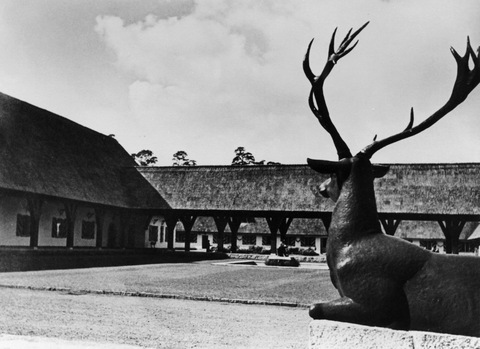
Carinhall
In Carinhall, situated on the idyllic Großer Döllnsee in the Schorfheide close to Berlin, Göring had a hunting lodge built in 1933 which, after substantial extensions in the years 1936-1937, became Göring's prestigious residence. It also housed his numerous works of art, which he had collected since the early 1930s. Göring profited in the compilation of his collection, among other things, from confiscations in the territories occupied by German troops. Among his works of art were also objects of Jewish ownership.
Letter to Hermann Göring
Aus der Sammlung von
Fold3 - Historical military records
Wie darf ich das Objekt nutzen?
Quelle
Fold3 - Historical military records
Kurzbeschreibung
Subject Files, compiled 1944 - 1946, documenting the period 1940 - 1946. Contini - Bonacossi - Goering. National Archives Catalog id 1537311, NARA M1944, roll 0088, page 43, retrieved Febuary 26, 2021

Lions and Art
The lion sarcophagus was purchased in 1942 by the art dealer Andreas Hofer (since 1941 "Director of the Art Collection of the Reichmarschall") from the Italian art dealer Ugo Jandolo in Rome.
In a letter to Göring dated October 14, 1942, Hofer reported:
Jandolo, Rome. After protracted negotiations I acquired the magnificent Roman sarcophagus with the two great lions in half relief... The owner of the sarcophagus had meanwhile learned from the dealer who had the sarcophagus on consignment that the piece was intended for you & suddenly no longer wanted to sell! Of course, this should serve the crook only as a pretext to induce me to offer a much higher price. After days of negotiations, I acquired both objects at the original price of L. 100.000.- for the sarcophagus....., plus 10% agreed brokerage fee. The sarcophagus is far more beautiful & important than the one you purchased from Brasini in the spring, in addition, except for unimportant trifles, preserved flawlessly, it will give you great pleasure.
Hermann Göring with his wife Emmy and his young lion in Carinhall
Date of Record: July 28, 1936
Aus der Sammlung von
Wie darf ich das Objekt nutzen?
Quelle
bpk-Bildagentur, Fotograf: Heinrich Hoffmann
Kurzbeschreibung
History / Germany / 20th c. / National Socialist era / Domestic policy / Goering / Carinhall
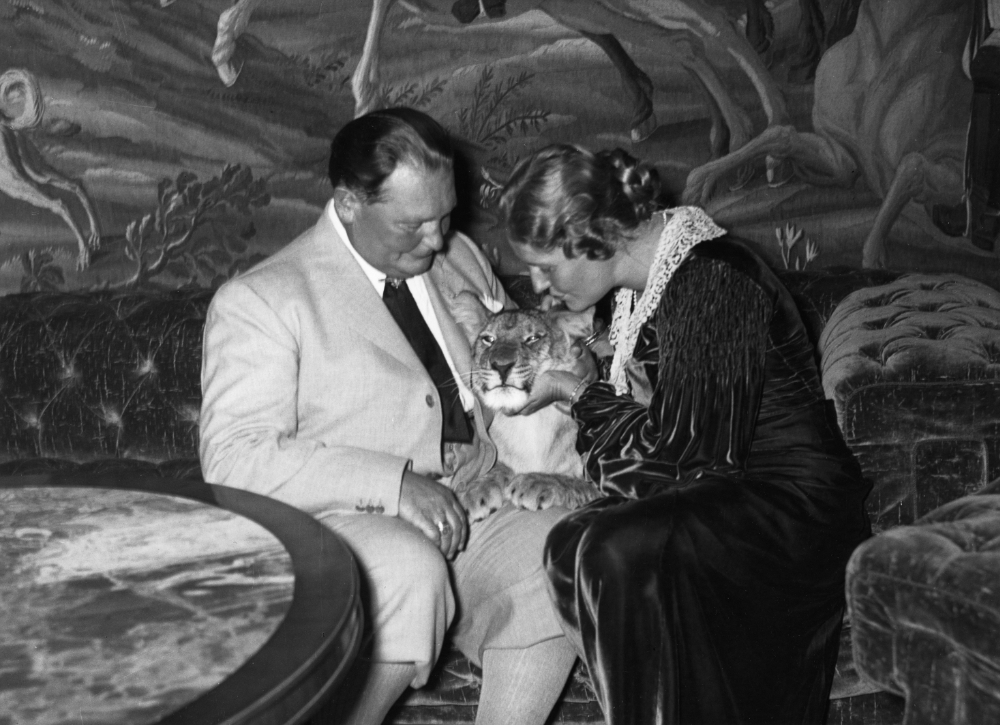
Ruins of Carinhall, Schorfheide in Brandenburg
Date: May 16, 1948, Carinhall
Aus der Sammlung von
Wie darf ich das Objekt nutzen?
Quelle
bpk/ Herbert Hensky

The End of Göring's Hunting Lodge
The estate was destroyed in April 1945 on Göring's orders to prevent its capture by Soviet troops. Although preparations had already been made since February to transport the most valuable works of art to Veldenstein Castle, where Göring had had a bunker built to secure his collection, numerous objects still remained at Carinhall. No official records are known from the time of the capture of Carinhall by the Red Army.
And what did Carinhall look like when the Central Office began salvaging it after the Russians withdrew in June 1946? A pile of rubble.
So reports Kurt Reutti, head of the salvage office of the Magistrate of Greater Berlin ("Zentralstelle zur Erfassung und Pflege von Kunstwerken").
And yet there were still numerous works of art:
partly lying in the open, partly in the blasted bunkers and bunker corridors....
Among these works of art was also the lion sarcophagus - it had remained in Carinhall.
Lion Sarcophagus on the Museum Island
Aus der Sammlung von
Staatliche Museen zu Berlin - Zentralarchiv
Wie darf ich das Objekt nutzen?
Quelle
©Staatliche Museen zu Berlin - Zentralarchiv
Kurzbeschreibung

The Sarcophagus on Museum Island
The sarcophagus was recovered in Carinhall after the war and transferred to the Berliner Antikensammlung (Collection of Classical Antiquities). The photo shows it being cleaned by female staff after being transported to Museum Island. The photograph can be dated to the time immediately after the transfer from the "Zentralstelle" (around 1947).
Between 2013 and 2016 the Lion Sarcophagus - like other objects from the Federal Republic of Germany - was examined by Laura Puritani as part of a research project of the Antikensammlung der Staatlichen Museen zu Berlin (Collection of Classical Antiquities).
Research into the provenance of archaeological objects is carried out from several points of view: Even if they were not seized due to persecution in the period from 1933 to 1945, it must be verified whether they belong in foreign ownership (Fremdbesitz) or were illegally excavated or traded.
Itinerary of Johan Adrian Jacobsen
Overview map of the voyage of Captain J. A. Jacobsen
L. von der Vecht, 1881-1883, Leipzig
Aus der Sammlung von
Ethnologisches Museum SMB und Staatsbibliothek zu Berlin
Wie darf ich das Objekt nutzen?
Quelle
Verlag Max Spohr, Leipzig
Chenega Island: Travelled on behalf of the Royal Königlichen Museums für Völkerkunde
On behalf of the then Königlichen Museums für Völkerkunde, Norwegian sailor Johan Adrian Jacobsen travelled the American Northwest Coast and Alaska between 1881 and 1883. On Chenega and Nuchek Islands he acquired large collections of ethnographic objects. On Chenega Island he gathered almost 200 items, including a striking hat.
Hunting Hat of the Chugach
Aus der Sammlung von
Staatliche Museen zu Berlin – Ethnologisches Museum
Wie darf ich das Objekt nutzen?
Quelle
©Staatliche Museen zu Berlin – Ethnologisches Museum / Photo: Martin Franken
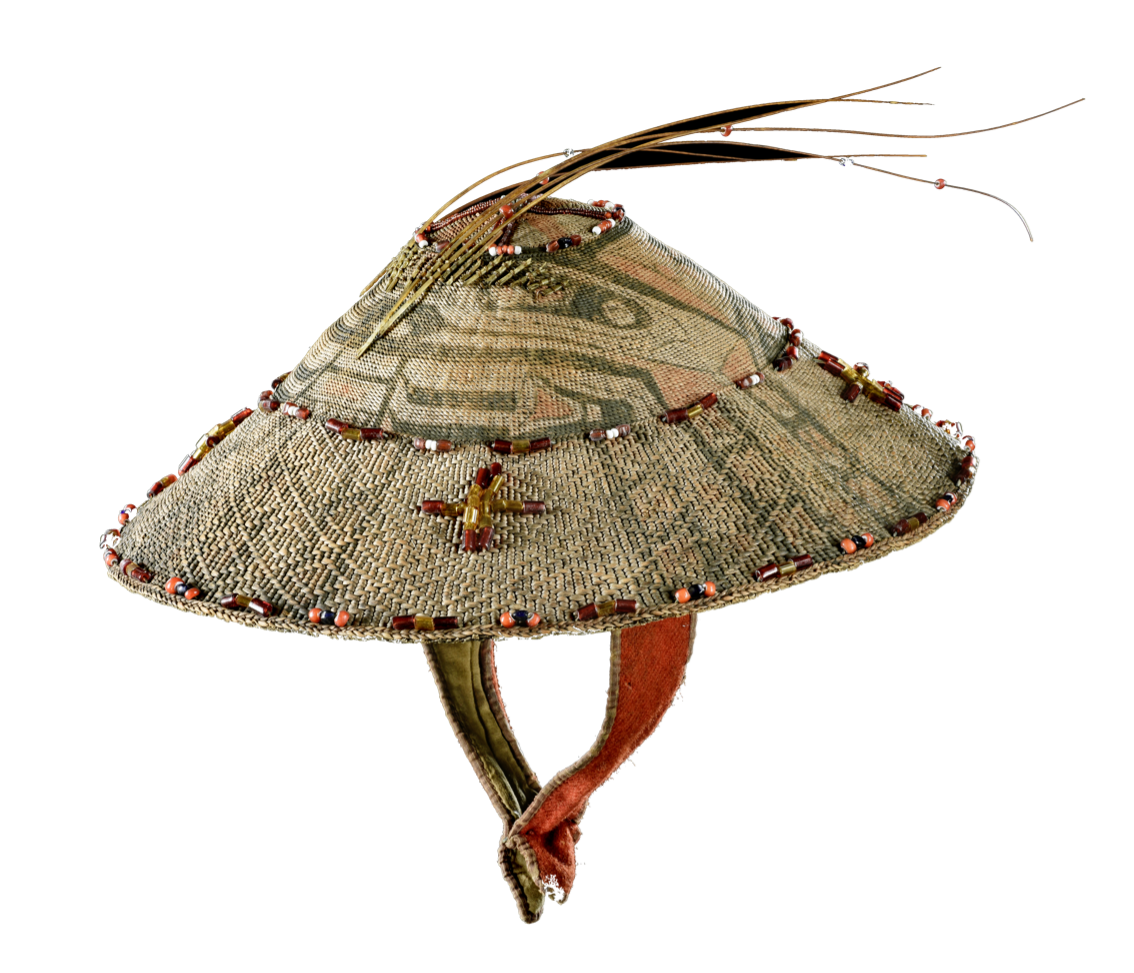
Chugach Hunting Hat
This hat, woven from spruce, is probably a headdress for hunting. The outstanding design is reminiscent of American Northwest Coast motifs. It is decorated with numerous colorful beads and long whiskers of a sea lion. The red and black color of the hat is now slightly faded and hints at how colorful it must have once been. Such a hat was worn by the men at sea during the hunt. On the one hand, it protected them from rain and water, on the other hand, it served as camouflage.
Chugach Alaska
Aus der Sammlung von
Wie darf ich das Objekt nutzen?
Quelle
Photo: Diego Delso
In the mid-18th century, Russian fur traders settled in the region and colonized southern Alaska. The settlers kidnapped Native women and children, the men were forced to do hard labor, and disease spread so rapidly that many people died. In the early 20th century, a smallpox epidemic drastically decimated the population, and an earthquake followed by a tsunami destroyed most of the buildings in many towns. In 1989, the oil tanker Exxon Valdez caused a serious accident that contaminated the entire coast.
The political situation of Alaska's Indigenous population changed in 1971, when the U.S. government enacted the Alaska Native Claims Settlement Act (ANCSA), as a result of which the Chugach Alaska Corporation was founded. It now has self-determination over its land and its resources and since then has been committed to preserving its cultural heritage.
Museum für Völkerkunde - View into the Hall of the Northwest American Collections
Aus der Sammlung von
Staatliche Museen zu Berlin – Ethnologisches Museum
Wie darf ich das Objekt nutzen?
Quelle
©Staatliche Museen zu Berlin – Ethnologisches Museum

From Alaska to Berlin
In the late 19th century, explorers and travelers shipped thousands of objects from southern Alaska to European and American museums.
Johan Adrian Jacobsen alone sent over 3,000 objects from Alaska to Berlin, including numerous human remains from graves.
His view of the Indigenous people shows the arrogance with which Europeans believed that these cultures would adapt to Western civilization.
Johan Adrian Jacobsen
Aus der Sammlung von
Staatliche Museen zu Berlin – Ethnologisches Museum
Wie darf ich das Objekt nutzen?
Quelle
© Staatliche Museen zu Berlin – Ethnologisches Museum

Return to Berlin
In November 1883, Jacobsen returned to Berlin. There he unpacked and catalogued his collections, which had already arrived at the museum. During this time, with the help of a journalist, he prepared his diaries for publication, which appeared in 1884 under the title "Capitain Jacobsen's Reise an der Nordwestküste Amerikas 1881-1883: zum Zweck ethnologischer Sammlungen und Erkundigungen nebst Beschreibung persönlicher Erlebnisse". (Capitain Jacobsen's voyage on the northwest coast of America 1881-1883: for the purpose of ethnological collections and inquiries, together with a description of personal experiences)
"Captain Jacobsen's Journey on the Northwest Coast of America 1881-1883: for the purpose of ethnological collections and inquiries along with descriptions of personal experiences".
Aus der Sammlung von
Wie darf ich das Objekt nutzen?
Quelle
©Verlag Max Spohr
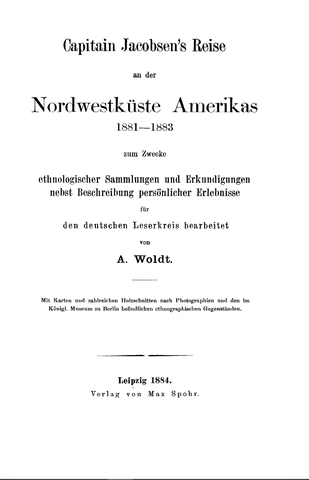
Jacobsen's Travelogue
In his travelogue (1881-1883) Jacobsen mentioned the objects of Chenega Island only once:
In the evening we returned to the village, where I bought all the ethnographic objects that were available. [...] The ethnographic objects that I bought here consisted of stone axes, wooden plates with inlaid beadwork, large stone lamps, beadwork, jackets made of eagle skins, and more.
In the travelogue the hat is not mentioned at all, but is probably among the objects Jacobsen acquired on Chenega Island. Such hats were valuable family heirlooms. Why was this striking and important object not mentioned?
As with many other objects in the collections of the Ethnologisches Museum, the exact circumstances of the acquisition of the Hunting Hat from southern Alaska are and remain unknown.
Visit of a Delegation of Chugach in November 2019
Aus der Sammlung von
Staatliche Museen zu Berlin – Ethnologisches Museum
Wie darf ich das Objekt nutzen?
Quelle
©Staatliche Museen zu Berlin – Ethnologisches Museum, Photo: Timo Weißberg.
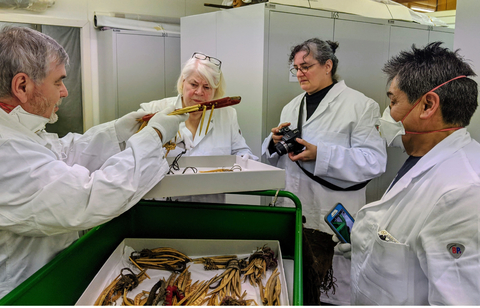
"What happened to our Ancestors?"
In the fall of 2015, a delegation from the Native Alaskan cultural organization, Chugachmiut, travelled to Berlin with the goal of establishing cooperation for a virtual collection of all Chugach objects worldwide. In the depot of the Ethnologisches Museum, an emotional moment occurred when John Johnson, vice president of the Chugach Alaska Corporation, read from the travelogue of Johan Adrian Jacobsen. In it, Jacobsen describes removing human remains from graves, including a woman and child whose bones decayed in Jacobsen's hands.
What happened to our ancestors?
John Johnson wants to know today.
Hermann Parzinger, President of the Prussian Cultural Heritage Foundation, and John Johnson, Vice-President of the Alaska Chugach Corporation, at the presentation of the grave goods
Aus der Sammlung von
Staatliche Museen zu Berlin – Ethnologisches Museum
Wie darf ich das Objekt nutzen?
Quelle
© SPK/photothek.net/Felix Zahn

Restitution and the Future
In 2018, the Stiftung Preußischer Kulturbesitz returned nine objects to the Chugach Alaska Corporation, that Jacobsen had stolen from graves. The whereabouts of the human remains could not be determined and are being investigated cooperatively as part of provenance research.
Approximately 200 objects from the region remained in the Ethnologisches Museum's collections and are now part of collaborative research. For this purpose, a delegation of representatives of the Chugach visited the Ethnologisches Museum again in 2019.
As a provenance researcher at the Zentralarchiv der Staatlichen Museen zu Berlin, Ilja Labischinski works together with colleagues from the Ethnologisches Museum and representatives of the Chugach on projects concerning the provenance, education, and exhibition of objects and the knowledge associated with them.
Mosse Palais Berlin Site Plan
Hans Strauch
Aus der Sammlung von
Wie darf ich das Objekt nutzen?
Quelle
HDS Architecture
Palais Mosse - Leipziger Platz 15/ Voßstraße 22
Immediately after the end of the Second World War, an impressive lion made of limestone could be found in a garden on Voßstraße.
A short time later, it turned up on Museum Island. But who did it belong to?
Reclining Lion
August Gaul
Aus der Sammlung von
Alte Nationalgalerie, Staatliche Museen zu Berlin
Wie darf ich das Objekt nutzen?
Quelle
Alte Nationalgalerie, Staatliche Museen zu Berlin – Stiftung Preußischer Kulturbesitz
Kurzbeschreibung
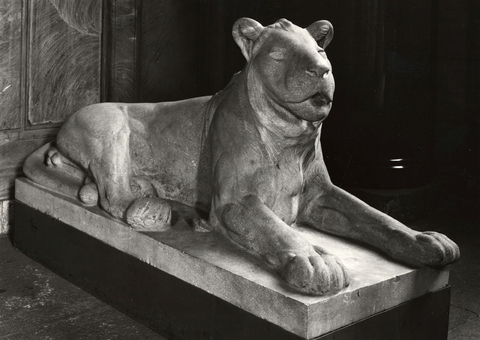
Kurt Reutti, employee of the Berlin magistrate, stated in an internal report:
Large reclining panther, marble. Recovered from a garden on Voßstraße
View from the courtyard of the palace of Rudolf Mosse Voßstraße 22
Aus der Sammlung von
Staatliche Museen zu Berlin, Kunstbibliothek
Wie darf ich das Objekt nutzen?
Quelle
© Staatliche Museen zu Berlin, Kunstbibliothek, Photothek Willy Römer / Willy Römer
Panther or Lion?
In 1949, the sculpture came to Museum Island, It was handed over by Kurt Reutti, an employee of the Berlin magistrate: He was fully committed to taking care of works of art that were lying around unprotected on streets, squares, in parks and gardens in destroyed Berlin. He had reported the discovery of a marble panther. It was not a panther, but a lion and not made of marble, but of limestone. The reported location of the finding, "Voßstraße" promised a possible link to the former owner.
Rudolf Mosse around 1910
Aus der Sammlung von
Wie darf ich das Objekt nutzen?
Quelle
bpk
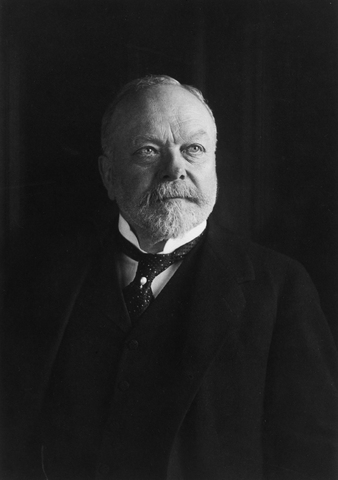
The Man who introduced Advertising to the Newspapers
The German-Jewish publisher Rudolf Mosse (1843−1920) lived in a prestigious palace between Leipziger Platz and Voßstrasse. In 1867, he opened the "Rudolf Mosse Zeitungs-Annoncen-Expedition" (Rudolf Mosse Newspaper Advertising Expedition) at Friedrichstrasse 60 with borrowed start-up capital, thus putting a bold idea into practice: He was one of the first publishers to lease entire pages in newspapers, which he then sold to advertisers for ads. In doing so, Mosse struck a chord with the times, as the rapidly developing press market with increasing circulations also raised production costs. Selling space for advertisements was thus a welcome means of increasing newspaper revenues.
Just five years later, the company had more than 250 branches in Germany and abroad and advertised confidently with "Inseraten-Annahme für sämmtl. existirende Zeitungen der Welt" (Accepting advertisement orders for all existing newspapers in the world). Beginning in 1871 Mosse published the high-circulation daily “Berliner Tageblatt”, which by 1933 had become the largest liberal daily newspaper in Germany and one of the most widely read German papers abroad.
Rudolf Mosse Palace
Voßstraße 22, Berlin
1935
Aus der Sammlung von
Wie darf ich das Objekt nutzen?
Quelle
© bpk / Atelier Bieber/Nather
Kurzbeschreibung

Mosse also used his extensive private fortune as a promoter and patron, donating large sums to Jewish organizations as well as to vacation colonies, workers' country homes and destitute sick people, founding, among other things, an educational home for orphans and a pension fund for his employees. He also generously supported the Berlin museums; in 1891 he provided 30,000 marks for the purchase of Egyptian antiquities. One year later, more than 600 objects came to the Egyptian Museum as a "donation by Rudolf Mosse."
In the 1880s, Rudolf Mosse had the new city residence on Leipziger Platz built. He furnished it with works of art and a library. The surviving catalogs show an exquisite collection along with the Lion. Mosse was considered a great lover of sculpture and had commissioned August Gaul in 1902 to create a lion in stone for his new palace.
After his death in 1920, his palace became a gallery open to the public, and the publishing house was continued by his son-in-law Hans Lachmann-Mosse.
Soviet occupation soldiers posing at the lion
August Gaul, 1945, Berlin
Aus der Sammlung von
Wie darf ich das Objekt nutzen?
Quelle
© bpk / Friedrich Seidenstücker

The seizure of power by the National Socialists in January 1933 finally made the economic survival of the already struggling Jewish publishing house and Germany's leading liberal newspaper completely impossible. Rudolf Mosse's heirs, his adopted daughter Felicia Lachmann-Mosse with her husband and three children, managed to emigrate to Switzerland in March 1933. All their private assets, the real estate and the art collection were confiscated, the publishing group was aryanized. In 1934, the art collection was offered at the Rudolph Lepke auction house in Berlin. From this sale, further objects entered the Staatliche Museen zu Berlin, albeit through very different channels and until the 1970s. No object was acquired by the museums directly at the auction.
The Nazis also appropriated the Palais on Leipziger Platz; the NS-Akademie für Deutsches Recht (Nazi Academy of German Law) moved in here under its president Hans Frank, later Governor General of Poland. The Lion was not offered at the auction of Mosse's art collection in 1934, it remained on site until the end of the war, when Kurt Reutti finally discovered it in the garden of the property on Voßstraße and had it salvaged.
Reclining Lion in the foyer of the James Simon Gallery
August Gaul
Aus der Sammlung von
https://www.smb.museum/museen-einrichtungen/alte-nationalgalerie/home/
Wie darf ich das Objekt nutzen?
Quelle
Staatliche Museen zu Berlin, Foto: Dirk von Becker

The knowledge of the history of the Lion formed the starting point for the further search for works from the Mosse Collection in the Staatlichen Museen zu Berlin. Nine works in four different houses came to light. Almost every object has its own exciting story from its creation to its place in the art collection of Rudolf Mosse and its acquisition by the museums. All nine works were restituted to the Mosse family heirs in 2015/2016. Three important works have been repurchased and are still on Museum Island today: a Roman sarcophagus with depictions of eroticism from the Antikensammlung (Collection of Classical Antiquities) is on display in the Neues Museum. The marble sculpture Susanna by Reinhold Begas can be seen in the Alte Nationalgalerie.
And the Lion by August Gaul has been enthroned in stately fashion in the upper foyer of the James Simon Gallery on Museum Island since summer 2019, welcoming visitors here as it once did in Rudolf Mosse's palace.
Petra Winter begun an investigation into the "Lion" as part of the provenance research project on the "Galerie des 20. Jahrhunderts“ (Gallery of the 20th Century) which was extended to other works from the Mosse Collection in the Staatliche Museen zu Berlin from 2012 to 2014.
For many years, a declared goal of the Staatliche Museen zu Berlin has been the proactive examination and tracing of works of art that were seized during the Nazi-looting of cultural property.
Goethe's garden house and bookplate Erich Schmidt (collage)
Aus der Sammlung von
Staatsbibliothek zu Berlin, Wikimedia Commons
Wie darf ich das Objekt nutzen?
Quelle
Wikicommons und Staatsbibliothek/ Image editing: Doris Antonides-Heidelmeyer
How did Goethe's Garden House become looted property?
In the course of provenance research at the Staatsbibliothek zu Berlin, books with a bookplate depicting Goethe's Garden House in Weimar were repeatedly identified. Further study put provenance researchers on the track of a prominent loot of Jewish property, which took place in Berlin during the Nazi-era.
Exlibris Erich Schmidt
Aus der Sammlung von
Wie darf ich das Objekt nutzen?
Quelle
©Staatsbibliothek zu Berlin

In a neo-Rococo cartouche, the unmistakable view of the garden house on the edge of the park on the Ilm river, and above it, to remove any doubt, the bust of the great poet - the connection to Goethe and Weimar Classicism cannot be evoked more clearly. This place of pilgrimage for lovers of literature was used to mark the “Library of Erich Schmidt” – according to the inscribed plaque. The signature "G. Otto 96." reveals that this small print is one of the numerous ex libris designs by the graphic artist George Eugène Otto, who was initially trained in his father's store on Unter den Linden street in Berlin, and which he produced as a student of Emil Doepler from 1889 onwards.
Erich Schmidt
Aus der Sammlung von
Library of Congress
Wie darf ich das Objekt nutzen?
Quelle
©George Grantham Bain Collection
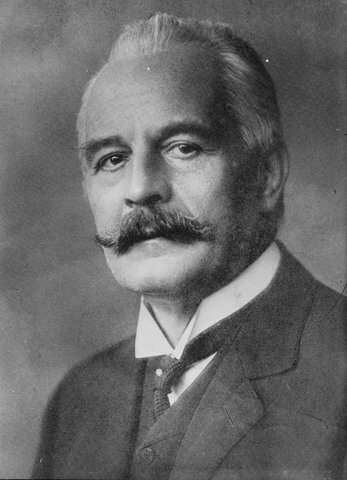
Thanks to this concise bookplate, the "Erich Schmidt" named on it can be immediately recognized as the well-known Lessing and Goethe scholar of this name, which is otherwise difficult to individualize due to its frequency.
After graduating from school in Schulpforta, Erich Schmidt (1853-1913) studied classical philology in Graz, Jena and Strasbourg and in 1874 earned his doctorate degree of modern German literary history with Wilhelm Scherer. A year later he received a post-doctorate degree in Würzburg which qualified him to succeed Professor Scherer in Strasbourg in 1877. In 1880 Schmidt went to Vienna as professor and in 1885 became director of the newly founded Goethe Archive in Weimar. In 1887 he again succeeded Scherer as professor of modern German literary history at Friedrich Wilhelm University in Berlin, became founding director of the German Department, and was rector of the university from 1909 to 1910. From 1906 until his death he was president of the Goethe Society in Weimar, and as early as 1895 he was accepted as a full member of the Prussian Academy of Sciences.
Schmidt was at home in the literary salons of Vienna and Berlin and was widely engaged as a university lecturer and science administrator.
Collective volume "Maler Müller"
Aus der Sammlung von
Staatsbibliothek zu Berlin
Wie darf ich das Objekt nutzen?
Quelle
©Staatsbibliothek zu Berlin
Kurzbeschreibung

"Die Bibliothek eines grossen und gelehrten Mannes ist mehrenteils ein charakteristischer Beitrag zur Denkweise und Biographie desselben.“ (Typically the library of a great and learned man contributes to his way of thinking and is a representation of his biography.)
From the often quoted preface to the auction catalog of Johann Gottfried Herder's library published in 1804
Erich Schmidt owned a large library of around 10,000 volumes with a strong background in German Literature Studies, which also included many bibliophile items such as first editions and dedication copies. His collection focused particularly on works by and about Goethe, but also Lessing and Kleist. At the same time, as a patron of modern literature from the post-classical period to naturalism, Schmidt received numerous dedication and review copies of contemporary authors. In addition to the bookplate and a stamp from his Viennese period, Erich Schmidt often left handwritten annotations and his signature in the books, so that there are usually clearly recognizable traces of provenance.
To the digital copy
Voßstr.22 Mosse Palais
Aus der Sammlung von
Wie darf ich das Objekt nutzen?
Quelle
©Atelier Christoph Neubauer
Kurzbeschreibung

After Erich Schmidt's death on April 29, 1913, the Berlin publisher Rudolf Mosse purchased the collector's complete library, prior to a planned auction from the Berlin antiquarian bookseller Martin Breslauer, thus saving it from destruction. However, Schmidt's autograph collection items were separated, and were offered and sold individually by Breslauer in 1914.
Rudolf Mosse had the library placed on the ground floor of the palace at Leipziger Platz 15 / Voßstraße 22, which had been built for him in the neo-baroque style and was splendidly furnished. From March 1914 he made it accessible to the public for two hours each day of the week. He hired Hans von Müller as librarian. Whether the four-volume, typewritten and alphabetically arranged "Verzeichnis der Büchersammlung Rudolf Mosse <formerly Univ.-Prof. Erich Schmidt>" dates from this time or was only created during the later sale of the collection is still unclear.
Congratulations page from Emilie Mosse
Aus der Sammlung von
Wie darf ich das Objekt nutzen?
Quelle
Staatsbibliothek zu Berlin
Kurzbeschreibung

Surprisingly, the Erich Schmidt library, acquired by Rudolf Mosse in his seventieth year and thus saved from destruction, remains to this day one of the few verifiable possession of a book of this professional bookseller and internationally active publisher.
There is one exception that could not be more personal: The congratulatory album compiled as a gift for Rudolf Mosse on the occasion of his 70th birthday on May 8, 1913, gathered 302 contributions, of which 263 are still preserved today.
The print edition published in parallel by the editors of the album contains the texts as well as notes on the illustrations and thus gives an impression of the congratulations missing today in the original as well as of the condition of the original binding.
To the digitized version of the Mosse album
To the digitized print edition
Drawn Congratulation by Caricaturist Hermann Wilke from Mosse Album
Hermann Wilke
Aus der Sammlung von
Wie darf ich das Objekt nutzen?
Quelle
Staatsbibliothek zu Berlin

This congratulatory page, designed by Brunswick caricaturist Hermann Wilke (1876-1950), cleverly combines a drawing with his own portrait photograph. As a permanent contributor to the satirical weekly magazine Ulk, Wilke dedicates an illustration titled, "View of his father city" to his employer. Inspired by the Mosse newspaper publications, he drew an elderly couple placed downstairs in front of their house. She is engrossed in the illustrated Welt-Spiegel and he in the Berliner Tageblatt.
Two other scenes of the drawing show a well-situated chubby reader of the Volks-Zeitung on the first floor and on the second floor, a laughing young man reading the Ulk. At that time, Ulk was a circulation-boosting free supplement for several newspapers of the Mosse publishing house.
Dedication Paul Lindau to Mrs. Mosse
Aus der Sammlung von
Staatsbibliothek zu Berlin
Wie darf ich das Objekt nutzen?
Quelle
Staatsbibliothek zu Berlin
Another of the few examples with personal provenance traces that point to Mosse, is a book given to Mosse’s wife Emilie for Christmas. On December 23, 1889, the journalist, dramaturge, and writer Paul Lindau dedicated his freshly published novella Im Fieber "Seiner liebenswürdigen Freundin Frau Rudolf Mosse in freundschaftlicher Verehrung" (To his kind friend Mrs. Rudolf Mosse in friendly reverence).
Traces left by Rudolf Mosse himself - be it handwritten notes, at least a name or an acquisition date, even a bookplate commissioned by him - could not be discovered in any of the volumes examined so far. In terms of books, Mosse can be seen primarily as a businessman and patron, not as a reader.
Congratulations sheet from Raffael Schuster-Woldan
Aus der Sammlung von
Staatsbibliothek zu Berlin
Wie darf ich das Objekt nutzen?
Quelle
©Staatsbibliothek zu Berlin / Image editing: Doris Antonides-Heidelmeyer
Kurzbeschreibung
The sale records of the remaining holdings from the antiquarian bookshop Straub, held by the Berlin-Brandenburgische Akademie der Wissenschaften (Academy of Sciences)document that in 1952, "242 photographs from the Rudolf Mosse Collection (autographs)" reached the "Öffentliche Wissenschaftliche Bibliothek" (Public Scientific Library – a predecessor institution of today's Staatsbibliothek). In 1966 they were finally incorporated into the Handschriftenabteilung (Manuscripts Department) under the call number Alb. amic. 141.
Thanks to the unsold sheet with a red chalk drawing by Raffael Schuster-Woldan and the pencil note "112/393" in the lower right corner with the price 30.- [RM], the antiquarian bookshop Agnes Straub can be determined as the seller of individual sheets of the album. The traces of the antiquarian bookshop, which have been documented many times through provenance research, enable a clear assignment and the resolution of the inconspicuous note as a reference to the offer number 393 in the Straub catalog no. 112 (ca. 1940).

For the National Socialists, the Mosse family was a symbol of the hated "Jewish press". It was persecuted immediately after the seizure of power because of its Jewish faith and also because of its political stance. Rudolf Mosse's adopted daughter and heiress Felicia and her husband Hans Lachmann-Mosse emigrated to the United States via Switzerland and France in the first half of 1933.
The Mosse Group was forced into insolvency proceedings. The Lachmann-Mosse property was then "administered" and "utilized" by Mosse-Treuhandverwaltungs-GmbH, the real estate was transferred by the Nazi state to its own institutions such as Hans Frank's Akademie für Deutsches Recht (Academy of German Law), and the valuable art holdings were auctioned off in 1934.
After the confiscation of the private property of the Mosse family, the sale of the library from the Mosse-Palais also began in 1934 via several antiquarian bookstores, with the provenance of Erich Schmidt being placed in the spotlight. The bookstore of Sophie Szczepanski in Berlin-Charlottenburg was involve from the beginning as it had a business relationship with the Staatsbibliothek at that time. Also still in 1934, a catalog of the Berlin Wertheim Antiquarian Bookshop "together with antiquarian Friedrich Korn" was published, followed by catalog offers from the Berlin antiquarian bookshops Agnes Straub and Der Bücherwurm.
ZwA Documents
Aus der Sammlung von
Wie darf ich das Objekt nutzen?
Quelle
©Staatsbibliothek zu Berlin / Photo: Michaela Scheibe / Image editing: Doris Antonides-Heidelmeyer
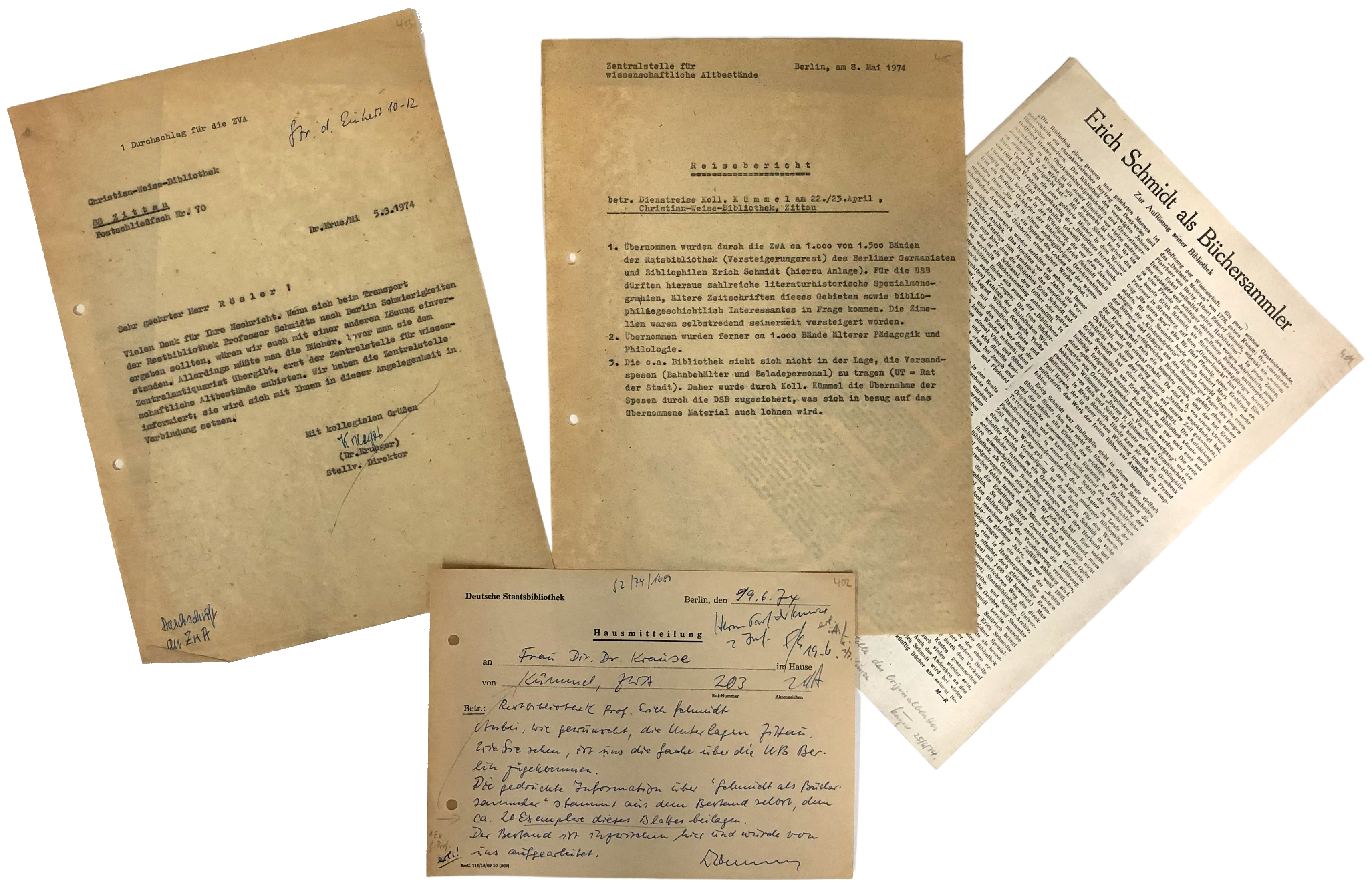
Redistribution in the GDR: The Role of the "Zentralstelle für wissenschaftliche Altbestände"
The surviving files of the Zentralstelle für wissenschaftliche Altbestände - ZwA (Central Exchange Office for Academic and Research Libraries) show that in 1974 the ZwA took over and redistributed 1,000 volumes from the library of Erich Schmidt, which had come to the Christian Weise Bibliothek Zittau by unexplained means as unsold auction items. At this late date, a few more volumes from the Schmidt-Mosse provenance were taken over into the holdings of the Staatsbibliothek zu Berlin.
To the index of the
Zentralstelle für wissenschaftliche Altbestände (ZwA) - File Inventory
After years of investigation by the provenance research team of the Staatsbibliothek zu Berlin it was possible to identify 44 volumes from the Erich Schmidt library and Paul Lindau's dedication copy for Emilie Mosse. Finally - through cooperation with the "Mosse Research Initiative" (MARI) - the reconstruction of the Mosse album as looted property of the family, as well as the retracing of the paths of the books to a large extent became feasable. Provenance researcher Hannah Neumann, in particular, has contributed significantly to clarifying this case and correctly classifying the provenance of Erich Schmidt.
In the meantime, Erich Schmidt's garden house bookplate has also become an identifying mark in other libraries for books looted from the Mosse family.
On July 8, 2020, the volumes identified as Nazi-looted property and the two cassettes containing the surviving leaves of the Mosse Album were handed over to the heirs of the Mosse family by the Stiftung Preußischer Kulturbesitz (Prussian Cultural Heritage Foundation).
The author, Michaela Scheibe, is a provenance researcher and deputy provisional head of the Department of Early Printed Books at the Staatsbibliothek zu Berlin. She is also chair of the dbv Commission on Provenance Research and Provenance Cataloguing and a proven expert in the field of Nazi-looted property in libraries.
Plan De Constantinople et Du Bosphore
between 1793 and 1802
Aus der Sammlung von
Wie darf ich das Objekt nutzen?
Quelle
© Staatsbibliothek zu Berlin
Kurzbeschreibung
Royal Prussian Legation in Constantinople
Among the most outstanding treasures of Islamic art are the five so-called Diez'sche Klebealben.
Together with over 17,000 volumes, manuscripts and an extensive coin collection, they form the legacy of the diplomat Heinrich Friedrich von Diez, who began collecting during his stay at the Sublime Porte in Constantinople between 1784 and 1791.
Two Ottoman Men at a Table
Aus der Sammlung von
Wie darf ich das Objekt nutzen?
Quelle
©Staatsbibliothek zu Berlin
Muraqqa' - Scrapbooking in the 18th Century (Die Diez’schen Klebealben )
Pasting albums have a long tradition in numerous oriental cultures. They were used in courtly circles for aesthetic enlightenment, but were also used as pattern books for transferring to other materials such as textiles in workshops. The word muraqqa', borrowed from Arabic, was used in the context of patchwork clothing or patchwork. Just as a patchwork is composed of different pieces of fabric and patterns, the individual album pages consist of images of different origins and formats. The arrangements usually do not reveal any reference in terms of content or style. For their part, the albums compiled by the Ottoman sultans have a very convoluted history of their own, and some of them date back to even older albums.
Outside of these rare albums, such materials have generally not survived.
Heinrich Friedrich von Diez
Aus der Sammlung von
Wie darf ich das Objekt nutzen?
Quelle
Staatsbibliothek zu Berlin, Foto: Carola Seifert

Diplomat and Private Scholar
Heinrich Friedrich von Diez was a highly unusual diplomat of the Prussian court. Universally educated and versed in numerous oriental languages, he had a decisive influence on contemporary scholars through his publications on oriental literature and history.
In 1784, he successfully applied for the post of envoy to Constantinople. Frederick II himself sent Diez to Constantinople as Prussian chargé d'affaires to the Sublime Porte, the Sultan's palace in Istanbul.
In 1791 Diez left the diplomatic service and worked first in Kolberg and then in Berlin as a private scholar. Here he devoted himself primarily to the expansion of his extensive universal library.
His stay in Constantinople and his affinity for the Orient shaped Diez throughout his life. In his house in Berlin-Stralau, the bachelor, described by his contemporaries as eccentric, owned a Chinese, a Persian and a Turkish room. He also dressed in oriental style.
Angel Appearance (Engelserscheinung)
Aus der Sammlung von
Wie darf ich das Objekt nutzen?
Quelle
©Staatsbibliothek zu Berlin
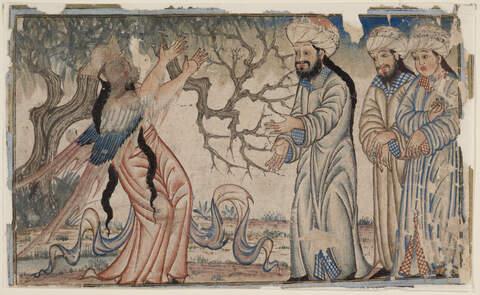
Fragmented Biographies of the Albums
Five pasiting albums form one of the highlights of Diez's library; they provide information about the history of Persian-Central Asian painting. The miniatures were largely created in the 14th and 15th centuries in what is now Iran and Afghanistan.
It is unclear from which sources the more than 450 pictorial works in the albums, which vary considerably in origin, size, execution and quality, originated and under what circumstances they found their way into Diez's collection. That Diez acquired the albums in Constantinople as complete ensembles and only rebound them has since been contradicted. Diez most likely assembled the albums himself according to his taste.
He purchased numerous books at the bazaar, but he also had suppliers who provided him with books, manuscripts, and works of art directly from the Seraglio, the palace of the Ottoman rulers. In 1789 he acquired, among other things, the albums of the harem staff.
Despite their uniqueness, compared to his overwhelming library, Diez's albums fell into oblivion and were rediscovered only in 1956.
Link to the digital copy
Fore-edges of Diez' books
Aus der Sammlung von
Wie darf ich das Objekt nutzen?
Quelle
©Staatsbibliothek zu Berlin / Photo: Thomas Rose
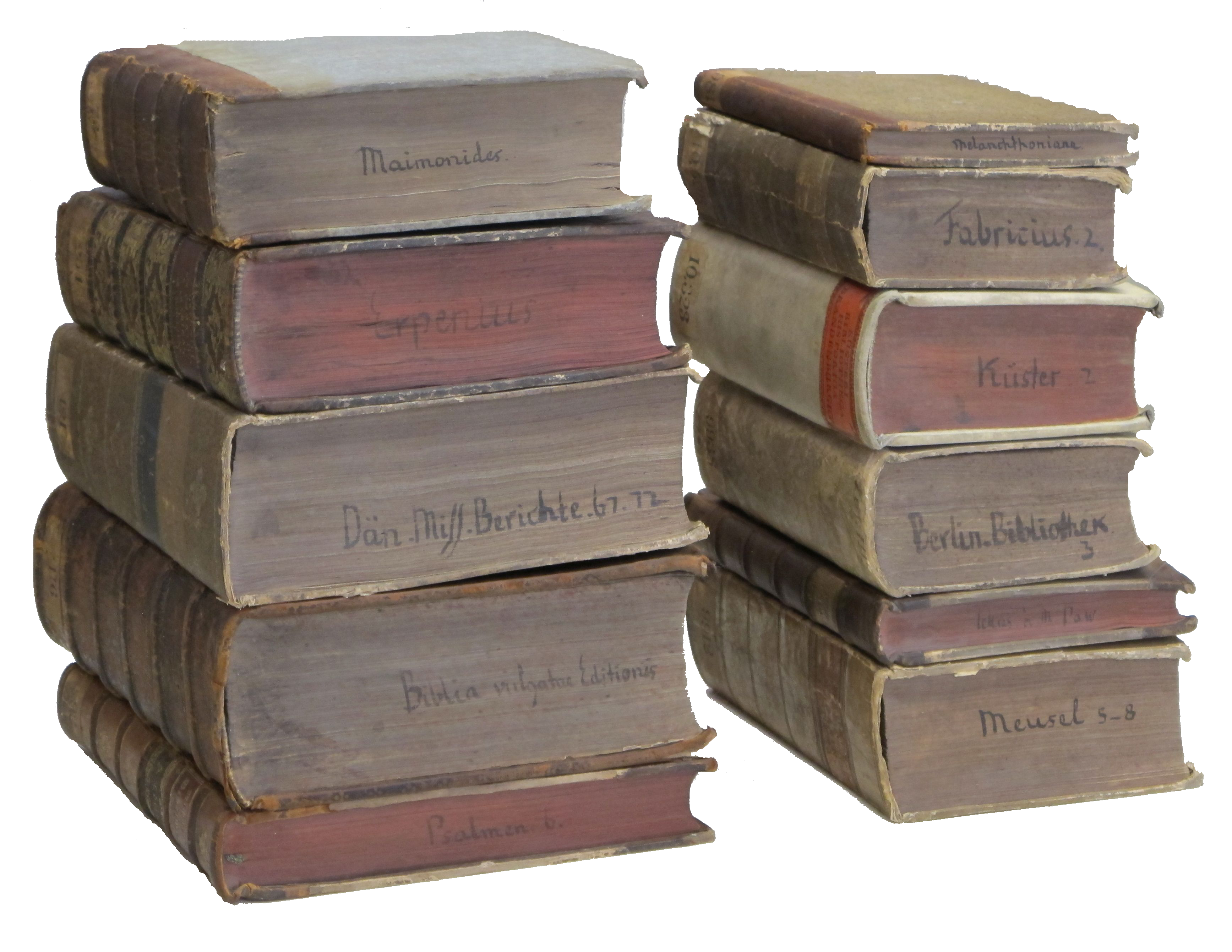
The Diez Collection in the Königlichen Bibliothek in Berlin
Heinrich Friedrich von Diez stipulated in his will that his "collection of books, manuscripts and Oriental paintings" should be given to the then, Königlichen Bibliothek (Royal Library). Diez ordered a separate listing of his books as a closed collection in the order he had specified.
Together with the unique book collection, the pasting albums with Oriental "paintings" arrived at the Berlin Königliche Bibliothek in 1817. They are all digitized and can be found under the call numbers Diez A Fol. 70-74 in the Oriental Department of the Staatsbibliothek zu Berlin.
Index of Oriental and Occidental Manuscripts
Heinrich Friedrich von Diez, 1790
Aus der Sammlung von
Wie darf ich das Objekt nutzen?
Quelle
Staatsbibliothek zu Berlin
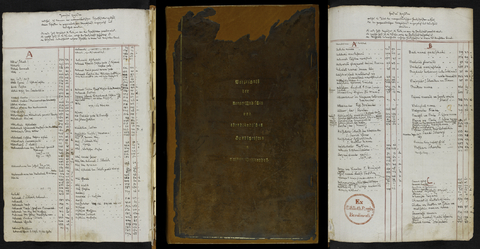
"Verzeichnis der morgenländischen und abendländischen Handschriften in meiner Bibliothek"
(Index of Oriental and Occidental Manuscripts in my Library)
The directories Diez wrote in his own hand reflect his personal interests and the principles of order according by which he collected.
He expanded the term "Orient" beyond geographical boundaries to include not only all of Asia with China and Japan, but also Africa with Egypt. He also included the parts of Europe that belonged to the Turkish Ottoman Empire.
In the prefaces to these catalogs, Diez justifies his line of thought:
The decisive factor was the "Oriental spirit", which differed fundamentally from the Occidental. It is characterized by a far greater permanence of culture and way of life, sciences, arts and philosophy. For generations, the people of the Orient have remained faithful to their traditions in their thoughts and actions as well as in science and the arts, and their views have remained constant. For Diez, the Orient is "a humanity that for millennia has always remained the same, both externally and internally, so that its newest is nothing other than its oldest".
to the digital copy of the directory
Scholarly and bibliophile libraries, such as the Bibliotheca Dieziana, are preserved in the Staatsbibliothek zu Berlin as closed provenances. They are among the library's great treasures and are kept under special conservation conditions.
You can look at, touch and read these volumes in the Rare Books Reading Room of the Staatsbibliothek Unter den Linden.
The project coordinator Doris Antonides-Heidelmeyer, in collaboration with the provenance researchers of the Staatsbibliothek zu Berlin, has prepared this article both visually and in terms of content.
Plan de Paris par Arrondissement
May 1942, Paris
Aus der Sammlung von
A. Leconte, Editeur
Wie darf ich das Objekt nutzen?
Quelle
Image Editing: Doris Antonides-Heidelmeyer
Paris - Square de l'Avenue Foch
In the fall of 1939, just before the German troops invaded Paris in June 1940
Arthur Rubinstein emigrated with his family from France to the USA.
That same year, the "Einsatzstab Reichsleiter Rosenberg" (Reichsleiter Rosenberg Taskforce) confiscated the Paris possessions of the world-famous Jewish pianist and took his private library to the Reichssicherheitshauptamt (Reich Main Security Office) in Berlin.
In 1954, Rubinstein returned to the house in the illustrious Square de l'Avenue Foch. Of his fragmented library, only 137 books have resurfaced by that time.
Joseph Hecht's Elephants - Exlibris and other Etchings
Aus der Sammlung von
Wie darf ich das Objekt nutzen?
Quelle
©Staatsbibliothek zu Berlin / Image Editing: Doris Antonides-Heidelmeyer
Kurzbeschreibung
https://dolanmaxwell.com/publications/21-joseph-hecht/
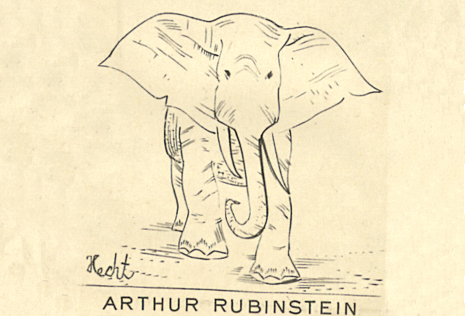
Arthur Rubinstein, Joseph Hecht and the Elephant
The story of the house library of the Polish pianist Arthur Rubinstein (1887-1982) begins in his adopted home of Paris. He had lived there since 1904, and after World War I, the artist and graphic designer Joseph Hecht (1891-1951) also came there. Hecht, like Rubinstein, was born in Łódź, Poland, into a family of Jewish textile industrialists. That this circumstance brought them together is very likely.
Books from Rubinstein's library feature a bookplate designed by Joseph Hecht, which can be traced from the early 1930s. The print shows an elephant drawn with a few confident strokes and the name Arthur Rubinstein in block letters. A handwritten signature, which includes the respective first letter of the author and a consecutive number, completes the bookplate.
It is peculiar to Hecht's work that he cut out individual animal motifs from his printing plates and used them for new compositions.
The elephant is thus possibly not a direct commentary on Rubinstein's person. Hecht rather associated the pachyderm with Paris and depicted it almost identically in various circumstances. Hecht used his frequent visits to the Paris zoo for the artistic development of his characteristic animal studies.
Files Fold3 Ancestry
Aus der Sammlung von
Fold3 - Historical military records, Ardelia Hall Collection
Wie darf ich das Objekt nutzen?
Quelle
©Fold3
Kurzbeschreibung
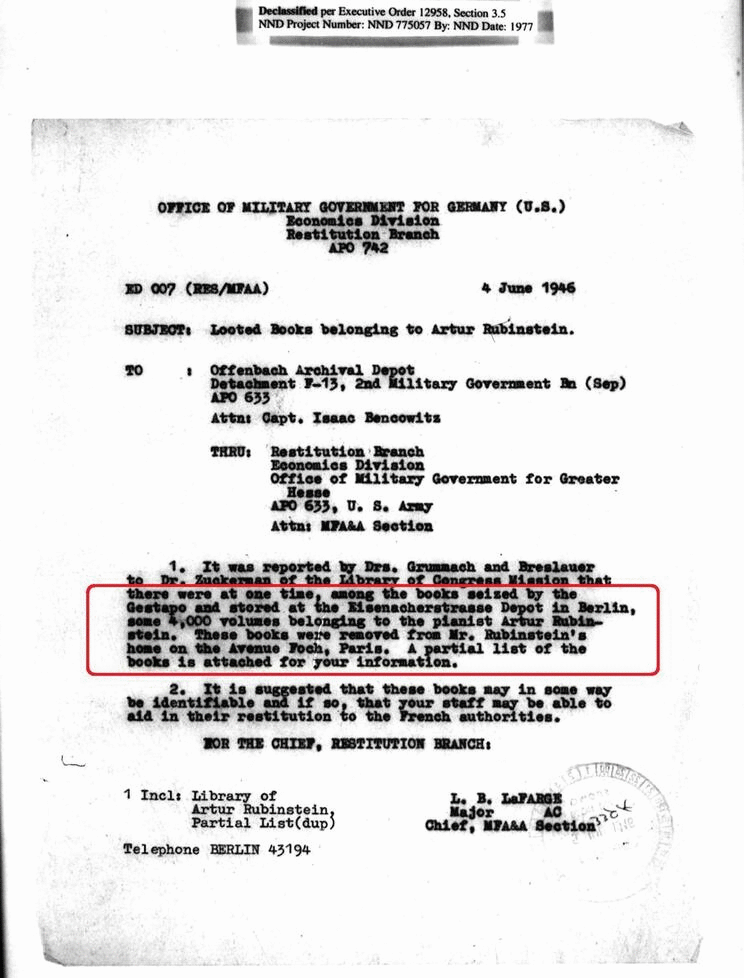
From the Square de l'Avenue Foch to Udmurtia
The Elephant bookplate is an important guide to Arthur Rubinstein's library, which is now completely dispersed.
4,000 volumes and numerous musical items had comprised the collection in his house on Square de l'Avenue Foch before it was confiscated by the German occupiers. Over the decades, thanks to a title list made from memory, some books and sheet music could be identified and restituted.
Some books were transported to the Reichssicherheitshauptamt (Reich Security Main Office) in Berlin, from where they later became part of the Öffentliche Wissenschaftliche Bibliothek (Public Research Library) as "herrenloses Bibliotheksgut“ (ownerless library property).
After the end of the war other copies reached the Soviet Union through Soviet trophy brigades, among them the All-Russian Library of Foreign Literature headed by Margarita Ivanovna Rudomino.
In the course of redistribution campaigns between 1945 and 1961, organized by the Rudomino Library, foreign-language books were also given to the Udmurt Soviet Republic . According to a scholarly review of the holdings of the National Library of Izhevsk published in 2010, its catalog shows a volume of poetry by Jean Cocteau (1889-1963) containing Rubinstein's bookplate. Is Poésie from 1925 one of the books that Rubinstein was particularly fond of and which he put on the list of his stolen books?
Collage Cocteau/ Rubinstein
Aus der Sammlung von
Wikicommons, Instituto Cervantes
Wie darf ich das Objekt nutzen?
Quelle
Wikicommons, Instituto Cervantes/ Photo Rubinstein: Carl von Vechten, Photo Cocteau: Agence de Presse Meurisse/ Collage: Doris Antonides-Heidelmeyer/ Staatsbibliothek zu Berlin
Kurzbeschreibung

Rio de Janeiro 1918
Aus der Sammlung von
Arthur Rubinstein Estate / Renaissance Literary Agency
Wie darf ich das Objekt nutzen?
Quelle
©Arthur Rubinstein Estate
Kurzbeschreibung
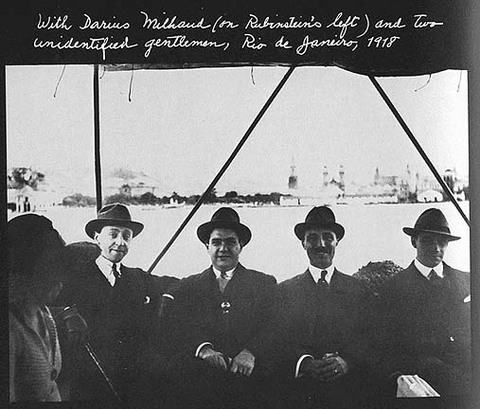
Le Bœuf sur le Toit
Alongside Jean Cocteau, the French poet, writer, painter and filmmaker, Rubinstein met many influential and fascinating personalities during the wild 1920s at the legendary Parisian Bar La Gaya, where jazz was played and Afro-Brazilian sounds inspired them. Rubinstein, too, had a distinct penchant for South American culture.
On a concert tour in Rio de Janeiro in 1918, he met the French composer Darius Milhaud. Back in Paris, memories of Brazil manifested themselves in Milhaud's compositions and in the new name for their favorite popular bar: Le Bœuf sur le Toit.
It was not unusual to hear Milhaud playing here with Rubinstein and Georges Auriac to six hands. Among other things, they also performed the piece about the Ox on the Roof, which takes up the rhythms of a Brazilian folk song and was reworked by Cocteau into a ballet.
During their stay in Rio, Milhaud and Rubinstein also made the acquaintance of Heitor Villa-Lobos, a Brazilian composer unknown in Europe at the time. He owes his first great successes in Paris, where they invited him, primarily to the intensive encouragement of these two.
Rudepoêma 1921-1926
Aus der Sammlung von
Wie darf ich das Objekt nutzen?
Quelle
©Juilliard School, New York
Kurzbeschreibung

Heitor Villa-Lobos, Rudepoêma 1921-1926
Composer Villa-Lobos owed no small debt of gratitude to generous and loyal patron Arthur Rubinstein: he dedicated to him one of the most influential piano pieces of the 20th century, probably the most difficult solo piano piece ever to play: Rudepoêma.
"Rude" in Brazilian stands for "wild" or "raw." Rudepoêma is both, "Rubinstein's Poem" and a "Wild Poem".
The score, with a dedication on the first page, was among the music Rubinstein was forced to leave behind at the Square de l'Avenue Foch in 1939. It was confiscated, as were his books, in 1940.
Only handwritten dedications - the elephant bookplate was not used for sheet music - made it possible to assign the musical materials confiscated in Paris to the pianist's collection. The Rudepoêma and a further five scores by Villa-Lobos lied for a long time in a pile of a total of 71 sheets of music that came from Moscow to the Staatsbibliothek in Berlin-Ost in 1958/59.
Until their restitution to Rubinstein's children in 2006, these sheet music remained unexplored among the holdings of the Music department of the Staatsbibliothek zu Berlin.
The restitution of 71 musical items by the Staatsbibliothek zu Berlin to Rubinstein's heirs in 2006 was the prelude to more extensive provenance research activities at the Staatsbibliothek zu Berlin. Thus, in 2020, together with the Leipzig University Library, six additional books and two scores with personal dedications were restituted to Rubinstein's children.
The first restitution package was donated by Rubinstein's children to the Juilliard School in New York in 2007. As a result, the 71 musical items, some of them digitally, are now accessible to the public, published in the Arthur Rubinstein Music Collection of Juillard School. The Department of Early Printed Books of the Staatsbibliothek zu Berlin documents provenance markings and research results in the ProvenanceWiki, platform for provenance research and provenance indexing. The bookplates and dedications are documented here.
Networking and transparency significantly promote the research of library holdings.
The project coordinator for provenance research at the Stiftung Preußischer Kulturbesitz, Doris Antonides-Heidelmeyer, in collaboration with the provenance researcher of the Staatsbibliothek zu Berlin, Regine Dehnel, prepared content and visuals for the article "Paris - Square de l'Avenue Foch" on Arthur Rubinstein's striking bookplate, the pianist's artist friendships and the musical piece Rudepoêma, which was dedicated to him.
Dresdner Bank
Aus der Sammlung von
Wie darf ich das Objekt nutzen?
Quelle
©Bundesarchiv Berlin / unknown photographer
Kurzbeschreibung
Dresdner Bank - Headquarters Berlin
In August 1935, Dresdner Bank and the Prussian state signed a contract for the sale of around 4,400 works of art. The sales added up to an impressive 7.5 million Reichsmarks. This stock had accumulated over years as collateral for credit transactions in the Berlin headquarters of Dresdner Bank and in the branches throughout Germany.
Purchase agreement between Dresdner Bank and the Prussian State
August 15, 1935
Aus der Sammlung von
Geheimes Staatsarchiv – Preußischer Kulturbesitz
Wie darf ich das Objekt nutzen?
Quelle
Geheimes Staatsarchiv – Preußischer Kulturbesitz

The biggest Art Deal of the Nazi era
From the very beginning, the Staatlichen Museen zu Berlin were involved in the Dresdner Bank's sales negotiations with the responsible ministries. The proceedings lasted almost two years, because as an institution directly subordinate to the state, they were supposed to be the custodians of the works of art. In addition, a museum had the necessary expertise that a bank official did not necessarily possess. Art experts from various fields were in demand, because this state transfer to the museums covered a wide spectrum from sculpture to painting and graphic art to furniture, oriental carpets and Persian ceramics. Actually, the museums were only interested in the top works, but the bank wanted a sale en bloc for economic reasons. In the end, the bank accommodated the Prussian State with the price, and in return the museums took over the entire collection, but were then allowed to sell on what they considered second- and third-class.
Sarah führt Abraham Hagar zu
Mattheus Stom, 1642/ after 1645
Aus der Sammlung von
Wie darf ich das Objekt nutzen?
Quelle
© Staatliche Museen zu Berlin – Gemäldegalerie / Photo: Jörg P. Anders
Kurzbeschreibung
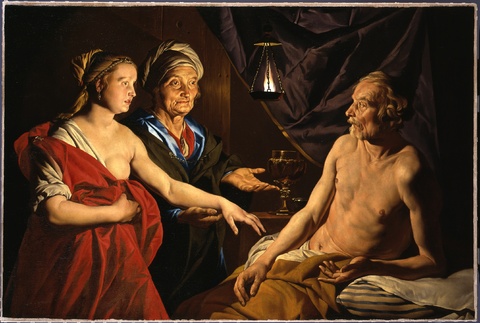
Sarah leads Abraham to Hagar
Among the paintings transferred from the Dresdner Bank holdings to the Gemäldegalerie was one by the painter Mattheus Stom, born around 1600 in Amersfoort, an important representative of the Dutch Caravaggists. This trend in Baroque painting was based on the example of the Italian artist Caravaggio. His style was characterized above all by effective light staging and a particularly expressive sign language.
Historical document: Works of art from the collection of the Dresdner Bank
Aus der Sammlung von
Staatliche Museen zu Berlin – Zentralarchiv
Wie darf ich das Objekt nutzen?
Quelle
©Staatliche Museen zu Berlin – Zentralarchiv
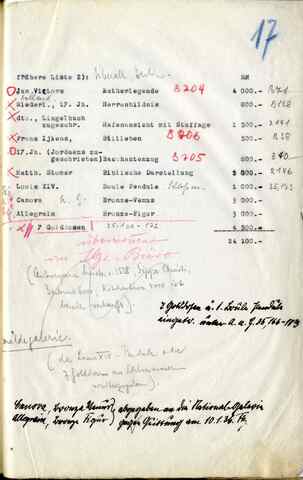
"Überall, Berlin"
The transfer of this painting from the Dresdner Bank to the Staatlichen Museen zu Berlin was documented on List 17. In sixth place is "Matt. Stomer / Biblische Darstellung“ (Biblical Depiction), with an estimated price of 5.000 Reichsmarks. Together with the nine other items on this sheet, it came from the previous possession of the Jewish art dealer Heinrich Ueberall. He had used the artworks as collateral for a loan he had taken out with the Dresdner Bank before 1932. The origin of his collection was known to the museums through previous correspondence with the contracting parties. Thus, one museum employee, probably while unpacking the works, wrote in pencil across the list, "Überall, Berlin." Most of the other notes on the document concern the museum-internal distribution of the artworks among the individual collections of the Staatliche Museen zu Berlin.
Advertisement of the art dealer Heinrich Ueberall in the "Weltkunst"
July 22, 1934
Aus der Sammlung von
Universitätsbibliothek Heidelberg
Wie darf ich das Objekt nutzen?
Quelle
©Universitätsbibliothek Heidelberg
Kurzbeschreibung

The Art Dealer Heinrich Ueberall
Heinrich Ueberall was born in Yaroslavl, Galicia, on December 20, 1869. In 1899, he moved with his wife Rebeka and two children to Berlin and opened an art and antiques shop. The business quickly became one of Berlin's leading art firms. When the National Socialists took power in 1933, he came under increasing pressure as a Jewish merchant. Between 1936 and 1938, he was forced to give up his business. In 1939 he successfully applied for a British entry visa for himself and his wife. However, the outbreak of war prevented the trip. Thus, in September 1939, Ueberall was deported to the Sachsenhausen concentration camp. He died there in the same month. His widow committed suicide in 1942 after receiving a deportation notice. The daughter had already emigrated to the USA with her family in 1938, the son to London in 1939.
Dresdner Bank letterhead
1935, Berlin
Aus der Sammlung von
Geheimes Staatsarchiv – Preußischer Kulturbesitz
Wie darf ich das Objekt nutzen?
Quelle
©Geheimes Staatsarchiv – Preußischer Kulturbesitz
Debts to the Dresdner Bank
Before 1932, Heinrich Ueberall had taken out a loan of around 43,000 Reichsmarks at a Berlin branch of the Dresdner Bank, "Depka 50". He was probably trying to bridge a financial bottleneck that had arisen during the Great Depression. In 1934, the Berlin headquarters of the Dresdner Bank took over the loan commitment, as the branch was only allowed to handle simple business transactions. However, the realization of loans secured by works of art was anything but an easy task. The "Industry Office" department was entrusted to manage this centrally. Although Ueberall had succeeded in reducing his debts somewhat, he was unable to redeem his deposited collateral in full, because his business was already doing poorly in 1935. He had lost important customers who did not tolerate him as a Jewish art dealer. There is no evidence that circumstances other than his persecution by the Nazi regime prevented him from financially rehabilitating himself and selling his art to the state.
after Canova: Venus (around 1845/64)
Aus der Sammlung von
Formerly Staatliche Museen zu Berlin - Nationalgalerie, restituted to the heirs of Heinrich Ueberall in 2019
Wie darf ich das Objekt nutzen?
Quelle
Staatliche Museen zu Berlin – Nationalgalerie
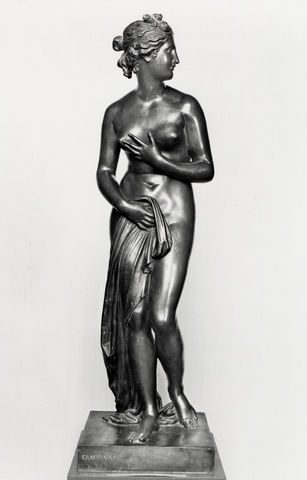
Restitution and Reacquisition
In 2019, Stom's painting Sarah Leads Abraham to Hagar was restituted to the heirs of Heinrich Ueberall, along with two other paintings from the Gemäldegalerie and two sculptures from the Alte Nationalgalerie. Originally, three additional paintings, a Boule-Pendule clock, and seven gold boxes from Ueberall's estate had been taken over with the Dresdner Bank inventories. These works, however, are considered war losses or were resold in an auction at Julius Böhler in Munich in 1937, so they had not been in the museums' possession for decades. The painting by Mattheus Stom returned to the Gemäldegalerie in 2020 thanks to the Kaiser Friedrich Museumsverein and with the support of the Friede Springer Foundation. After restitution, it could be reacquired.
Since 2018, Hanna Strzoda has been investigating at the Zentralarchiv whether the art works taken over by Dresdner Bank in 1935 were cultural assets seized as a result of Nazi persecution.
In addition to Heinrich Ueberall, other Jewish businessmen were among the borrowers whose works of art that had been transferred as collateral and were later sold to the state. Since the individual loan transactions were very different in their arrangements, each case is examined individually in order to find just and fair solutions in the sense of the Washington Principles together with the heirs if a context of seizure is established.
03
THING
Exlibris Hedwig Hesse
Adolf Behrmann, May 1918, Berlin
Aus der Sammlung von
Staatsbibliothek zu Berlin Preußischer Kulturbesitz
Wie darf ich das Objekt nutzen?
Kurzbeschreibung
With Knife and Fork – How to read Books differently
An unusual bookplate as a unique clue. The owl eating books with oversized cutlery points the way to the remains of a looted private Jewish-owned library. Without this striking mark, signed and dated by the artist, Hedwig Hesse's books would probably have remained undiscovered.
Exlibris Hedwig Hesse
Adolf Behrmann, May 1918, Berlin
Aus der Sammlung von
Staatsbibliothek zu Berlin Preußischer Kulturbesitz
Wie darf ich das Objekt nutzen?
Kurzbeschreibung
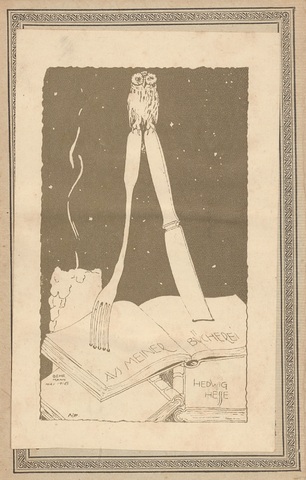
The owl as a symbol of wisdom, often combined with an open book, is common as an exlibris motif. Knife and fork to eat the food of knowledge, however, can be considered an individual and unusual interpretation of the subject, and not least the unequal proportions between owl and cutlery are evidence of the humor of the commissioner.
In May 1918 the product designer and commercial artist Adolf Behrmann, who lived in Eisenacher Strasse in Berlin-Schöneberg from 1903 to 1933, created this bookplate for Hedwig Hesse, who lived with her husband in Charlottenburg. The couple's personal acquaintance with the artist may be assumed due to Max Hesse's professional position as owner of an industrial printing company.
The bookplate also seems to have been intended for an extensive and well-organized book collection: it exists in a smaller and a larger version so that it fits varying book formats. It shows a pre-printed "N°...", as if the owner of the books had wanted to enter a handwritten numbering here at the bottom margin. As far as we know, however, this possibility remained unused.
Peter Hesse with his parents Hedwig and Max in Berlin
around 1930, Berlin
Aus der Sammlung von
Hesse Family
Wie darf ich das Objekt nutzen?
Quelle
Photo: courtesy-Hesse family property
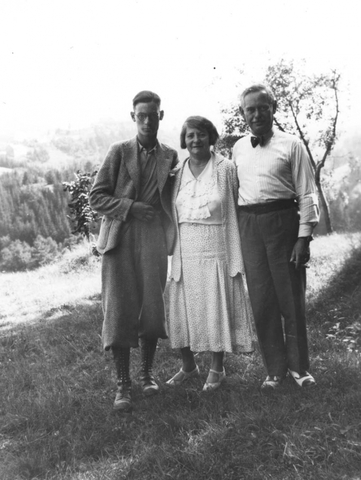
Hedwig Bachur was born in Berlin on May 8, 1880. She was the daughter of Siegfried Bachur and his wife Fanny, née Levy. She married Max Guido Hesse, owner of a publishing house for industrial printing, on April 1, 1905. Max Hesse was born in Leipzig on July 30, 1880. The couple had three children: Peter, Susi and Walter. The family lived at Helmstedter Strasse 5 in Berlin. As Jews, the Hesses were persecuted in Germany. The children were able to emigrate in time to South Africa and the USA respectively.
Hedwig and Max Hesse were deported as a couple to Riga (concentration camp) on January 19, 1942 and were murdered there.
Barnes von New York : Roman in zwei Bänden (Barnes of New York : novel in two volumes)
Author: Gunter, Archibald Clavering
Year of publication: 1889, Verlag: Engelhorn,
Ort: Stuttgart
Aus der Sammlung von
Staatsbibliothek zu Berlin Preußischer Kulturbesitz
Wie darf ich das Objekt nutzen?
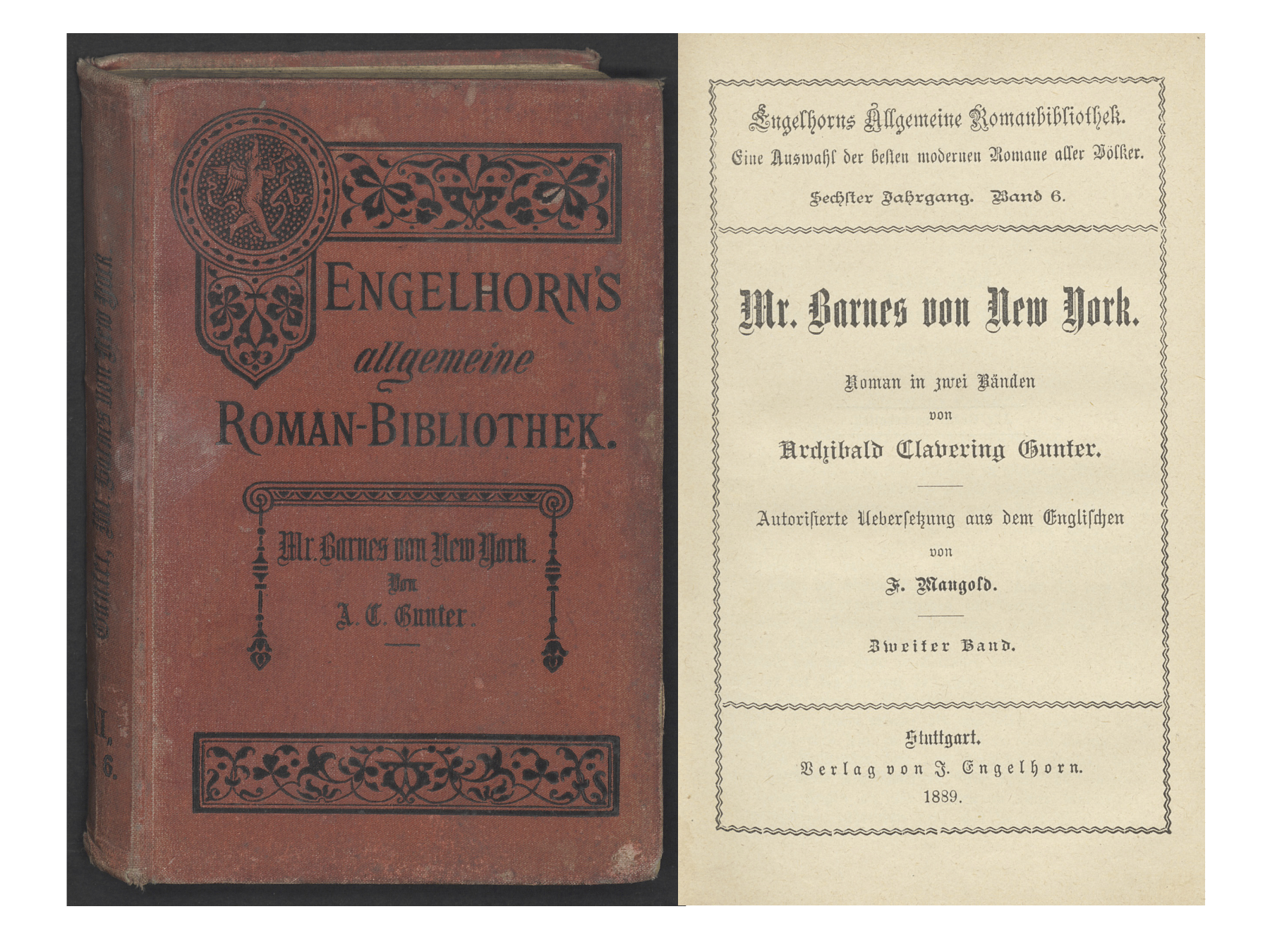
Private book collections from middle-class households usually do not include rare books or even bibliophilic treasures. Rather, they contain popular literature such as the volumes with Hedwig Hesse's bookplate. Three volumes of the series "Allgemeine Roman-Bibliothek" by the Stuttgart publisher Engelhorn were found in the Staatsbibliothek. In the Universitätsbibliothek Rostock the novella Das Skelet im Hause (The Skeleton in the House) was detected. Of course Hedwig Hesse also owned classics of German literature such as Goethe's works. On the basis of the bookplate several volumes have been identified in the Berliner Zentral- und Landesbibliothek.
Such popular works, which were also widely distributed in German-Jewish households and published in large editions, make it almost impossible for provenance researchers to trace the paths of stolen books without clear traces of their former owners. In the case of Hedwig Hesse's "Bücherei", however, the books, which were printed as mass-produced items, have become unique through their unmistakable bookplates and could thus be easily identified.
Link to the digital copy from the Staatsbibliothek zu Berlin
Stamp of the Berliner Stadtbibliothek
Aus der Sammlung von
Wie darf ich das Objekt nutzen?
Quelle
Staatsbibliothek zu Berlin
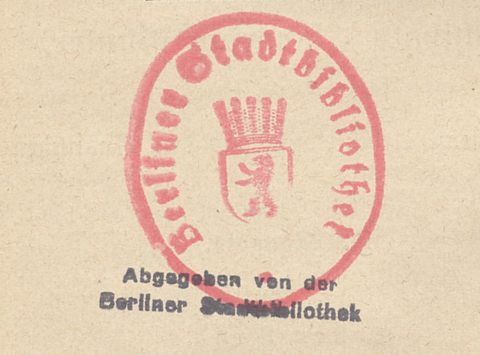
In the course of the Nazis' policy of persecution, expropriation and exploitation, Hedwig Hesse's books made their way from her apartment in Charlottenburg via intermediate stations into the hands of various libraries or other new owners. They exemplify the path taken by numerous books belonging to Jews in Berlin: In 1943, the Berliner Stadtbibliothek purchased approximately 40,000 books from the Städtische Pfandleihanstalt (Municipal pawnshop), which had come from the apartments of deported Jews. In addition, in 1951, the library acquired over 1,000 books from the "Verwaltungsstelle Sondervermögen" (Special Assets Administration Office) in the Abteilung Finanzen des Berliner Magistrats (Finance Department of the Berlin Magistrate), which were also partly confiscated Jewish property.
The Stadtbibliothek later passed on a number of volumes to other libraries. In this way, Hedwig Hesse's few books known today eventually reached Rostock and Dresden.
The Zentral- und Landesbibliothek Berlin identified 42 books in its holdings that belonged to Hedwig Hesse and restituted them to her heirs. In 2017, a volume from the Universitätsbibliothek Rostock followed, and in 2018, the Sächsische Landesbibliothek – Staats- und Universitätsbibliothek Dresden and the Staatsbibliothek zu Berlin together were able to hand over four more volumes to the family.
Even today, books with Hedwig Hesse's distinctive owl bookplate may turn up in antiquarian bookshops or be found in other library collections - but they will always remain scattered remnants of her "library."
Michaela Scheibe, provenance researcher and deputy provisional head of the Department of Early Printed Books of the Staatsbibliothek zu Berlin, is also chair of the dbv Commission on Provenance Research and Provenance Cataloguing and a proven expert in the field of Nazi -looted property in libraries.
Eisenwalzwerk (Moderne Cyklopen)
(Steel Rolling Mill (Modern Cyclops))
Adolph Menzel, 1872-1875
Aus der Sammlung von
Staatliche Museen zu Berlin, Nationalgalerie
Wie darf ich das Objekt nutzen?
Quelle
© Staatliche Museen zu Berlin, Nationalgalerie / Andres Kilger.
1:222 – A Barter with the German Reich
In March 1942, the Nationalgalerie received a transfer from the Reichsministerium für Volksaufklärung und Propaganda (Reich Ministry of Public Enlightenment and Propaganda) in the form of a study on the Eisenwalzwerk (Iron Rolling Mill) by Adolph Menzel. The Ministry had previously exchanged it with the Berlin art dealer Ferdinand Möller for 222 prints of "degenerate art." Such a barter transaction in the ratio of 1:222 was only possible in the course of the repressive art policy of the 1930s and the ideological devaluation of modernism.
Worker with rod in several studies. Study of the "Steel Rolling Mill"
Adolph Menzel, 1872-1875
Aus der Sammlung von
Staatliche Museen zu Berlin - Kupferstichkabinett
Wie darf ich das Objekt nutzen?
Quelle
© Staatliche Museen zu Berlin - Kupferstichkabinett / Photo: Dietmar Katz.
Kurzbeschreibung
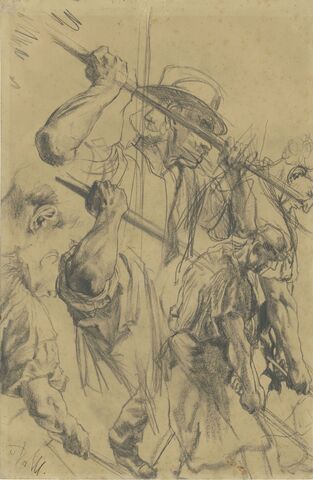
Menzel versus Modernism
During the Nazi era, the Nationalgalerie acquired for its Sammlung der Zeichnungen (Collection of Drawings) a study by Adolph Menzel of the famous Iron Rolling Mill. The museum had already owned this picture for decades when the pencil drawing was added in 1942. Regarding the origin of the drawing, the inventory indicates:
Traded by the Reichsministerium für Volksaufklärung und Propaganda for confiscated objects of "Degenerate Art" and transferred to the Nationalgalerie.
The Reich Ministry traded the Menzel study to the Berlin art dealer Ferdinand Möller. In return, Möller received 222 modern prints from the "Degenerate Art" confiscation campaign: In 1937, a commission headed by Adolf Ziegler, the president of the Reichskammer der Bildenden Künste (Reich Chamber of Fine Arts), went through about 100 museums and confiscated more than 20,000 works of modern art. Since they did not correspond to the reactionary view of art of the National Socialists, the works were summarily degraded to "signs of decay".
Contract between Ferdinand Möller and the German Reich
January 2, 1940
Aus der Sammlung von
Berlinische Galerie, Künstler*innen-Archive
Wie darf ich das Objekt nutzen?
Quelle
© Berlinische Galerie, Künstler*innen-Archive.
Kurzbeschreibung
The exchange was contractually sealed on January 2, 1940. The ministry's business partner was Ferdinand Möller. The contract which is kept in the Ferdinand Möller Archive in the Berlinische Galerie says:
The price for the aforementioned objects amounts to RM 3,000.00 each.
The Menzel drawing has been duly handed over by Mr. Ferdinand Möller to the Reichsministerium für Volksaufklärung und Propaganda and has become Reich property with the handover.
Repository Niederschönhausen Palace
1937, Berlin Niederschönhausen
Aus der Sammlung von
Staatliche Museen zu Berlin - Zentralarchiv, V/Sammlung zur „entarteten Kunst“
Wie darf ich das Objekt nutzen?
Quelle
© Staatliche Museen zu Berlin - Zentralarchiv
Kurzbeschreibung

The Storage of "Degenerate Art"
The exchange agreement between Ferdinand Möller and the Reichsministerium für Volksaufklärung und Propaganda of January 2, 1940 proves that the 222 works of defamed modern art "from the holdings in Schloss Niederschönhausen" had been taken over into the art trade. In this castle, located in the Berlin district of Pankow, the Reichskammer der Bildenden Künste bunkered the art confiscated in 1937 until opportunities for exploitation arose. A photo from the Schloss Niederschönhausen repository shows on the right edge the graphics cabinet in which the graphics exchanged for the Menzel sheet are likely to have been stored.
Untitled (Portrait Ferdinand Möller)
Heinrich Götz, 1917
Aus der Sammlung von
Berlinische Galerie, Künstler*innen-Archive
Wie darf ich das Objekt nutzen?
Quelle
© Berlinische Galerie, Künstler*innen-Archive
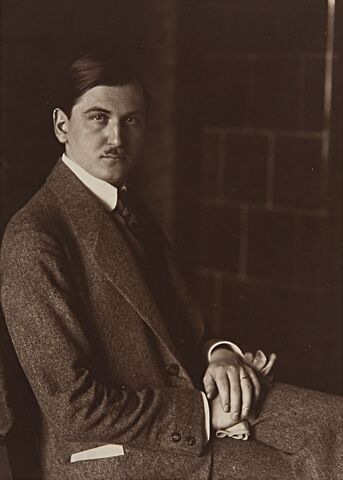
Ferdinand Möller
Ferdinand Möller (1882-1956) had been an art dealer in Berlin since 1918. As a gallery owner, he represented precisely that avant-garde that was later considered "degenerate" during the Nazi era. Above all, the Expressionists and the Bauhaus artists were among his favorites. Therefore he was an absolute specialist in contemporary art. From the point of view of the National Socialists, this also qualified him for the exploitation of unwanted modern art. He was one of four art dealers who, with official authorization, were allowed to sell "Degenerate Art" – but only abroad, because "Decayed Art" was to disappear from the German Reich. The other three "exploiters" were Hildebrand Gurlitt from Hamburg, Bernhard A. Böhmer from Güstrow and Karl Buchholz from Berlin.
Incoming goods ledger
1935-1939
Aus der Sammlung von
Berlinische Galerie
Wie darf ich das Objekt nutzen?
Quelle
Copyright © Berlinische Galerie, Künstler*innen-Archive

The Business Ledger
An infinite amount could be told about the topic of "Degenerate Art", about the "exploiters", and about the art trade during the Nazi era, but our focus is on the provenance of the Menzel study. Where did Ferdinand Möller get this drawing, for which he received 222 modern prints in exchange? In his business ledger, preserved in the Ferdinand Möller Archive in the Berlinische Galerie, the art dealer actually noted its source: he bought the drawing from fellow art dealer Otto Feindt (1892-1944), owner of the Berlin art gallery Victor Rheins. Möller recorded the work in his incoming goods ledger on June 2, 1939, with the serial number 2038. "V. Rheins, Berlin", can be deciphered here, pragmatically abbreviated the painting title "Menzel, Walzwerk“, purchased at a price of 1,500 Reichsmarks.
German hand drawings of the Romantic period. German graphic art of the early XIX century. Old drawings of different schools.
April 28, 1939
Aus der Sammlung von
Universitätsbibliothek Heidelberg
Wie darf ich das Objekt nutzen?
Quelle
Universitätsbibliothek Heidelberg
Kurzbeschreibung
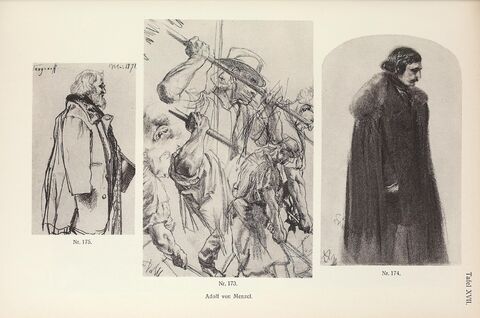
Menzel under the Hammer
The art dealer Otto Feindt owned the Menzel drawing for only two months. He had bought it in April 1939 at the C. G. Boerner auction house in Leipzig. "German Hand Drawings of the Romantic Period. German graphic art of the early XIX century. Old drawings of various schools" was the title of the catalog for the auction on April 28, 1939. Under lot number 173, a "Study sheet with motion studies for the men at the furnace in the painting The Iron Rolling Mill in the Nationalgalerie in Berlin" fell under the hammer. A confusion with a similar sheet is impossible, because the drawing, which is now in the Kupferstichkabinett, is reproduced in the catalog.
German hand drawings of the Romantic period. German graphic art of the early XIX century. Old drawings of different schools.
28. April 1939,
Aus der Sammlung von
Universitätsbibliothek Heidelberg
Wie darf ich das Objekt nutzen?
Quelle
Universitätsbibliothek Heidelberg
Kurzbeschreibung
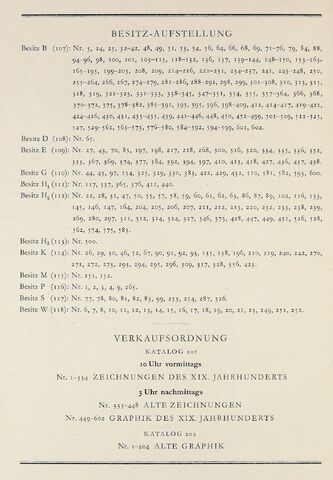
The Code "Besitz B (107)“
The Menzel drawing with lot number 173 is assigned to the code "Besitz B (107)" in the "List of Possessions" of the auction catalog. Such consignment lists became obligatory with the introduction of the "Gesetz über das Versteigerergewerbe" (Law regarding the Auction Sector) in October 1934. The coding system chosen by C. G. Boerner does not reveal anything about the identity of the previous owner. Other auction houses used, for example, initials and location of the owner. In the archives of the art dealer C. G. Boerner, a surprising note was found: the consignor was C. G. Boerner himself. The Menzel sheet thus came into the sale from the auction house's own stock. The auctioneer often stored works for years in order to include them in later auctions and thus to fill qualitative or quantitative gaps. There are no documents regarding the origin of these pieces of art.
The artwork was examined in the project „Die Erwerbungen der ‚Sammlung der Zeichnungen‘ (ehem. Nationalgalerie) im Zeitraum 1933 bis 1945“ (The Acquisitions of the 'Collection of Drawings' (formerly Nationalgalerie) in the Period 1933 to 1945) by Hanna Strzoda at the Kupferstichkabinett der Staatlichen Museen zu Berlin.
The aim of the project was to locate cultural assets in this collection that had been seized as a result of Nazi persecution. The Menzel study turned out to be the object of a truly bizarre barter deal with the Berlin art dealer Ferdinand Möller. In total, this drawing passed through the hands of three art dealers within only one year. Although the research provided an intriguing insight into the art trade network during the Nazi -Era, it left the key question unanswered due to a lack of records: Who owned the artwork between 1933 and 1939?
Marks by Alfred Kantorowicz
Jean-Jacques Rousseau, Jean-Jacques Rousseau’s Bekenntnisse, hrsg. von Otto Fischer, München : Mörike 1912.
Aus der Sammlung von
Wie darf ich das Objekt nutzen?
Quelle
Staatsbiblitohek zu Berlin
Notes with a System - The Berlin Library of Alfred Kantorowicz
If large quantities of handwritten notes in books can be clearly assigned to a reader, valuable insights can be gained for research. This is also true of the library of Alfred Kantorowicz. The literary scholar, who was dispossessed in the GDR, left numerous traces of reading and work in his books, which make his engagement with the text comprehensible to us.
Alfred Kantorowicz' Notes and Memos on Willi Bredel's "Die Enkel" (The Grandchildren)
Aus der Sammlung von
Wie darf ich das Objekt nutzen?
Quelle
Staatsbibliothek zu Berlin
Kurzbeschreibung
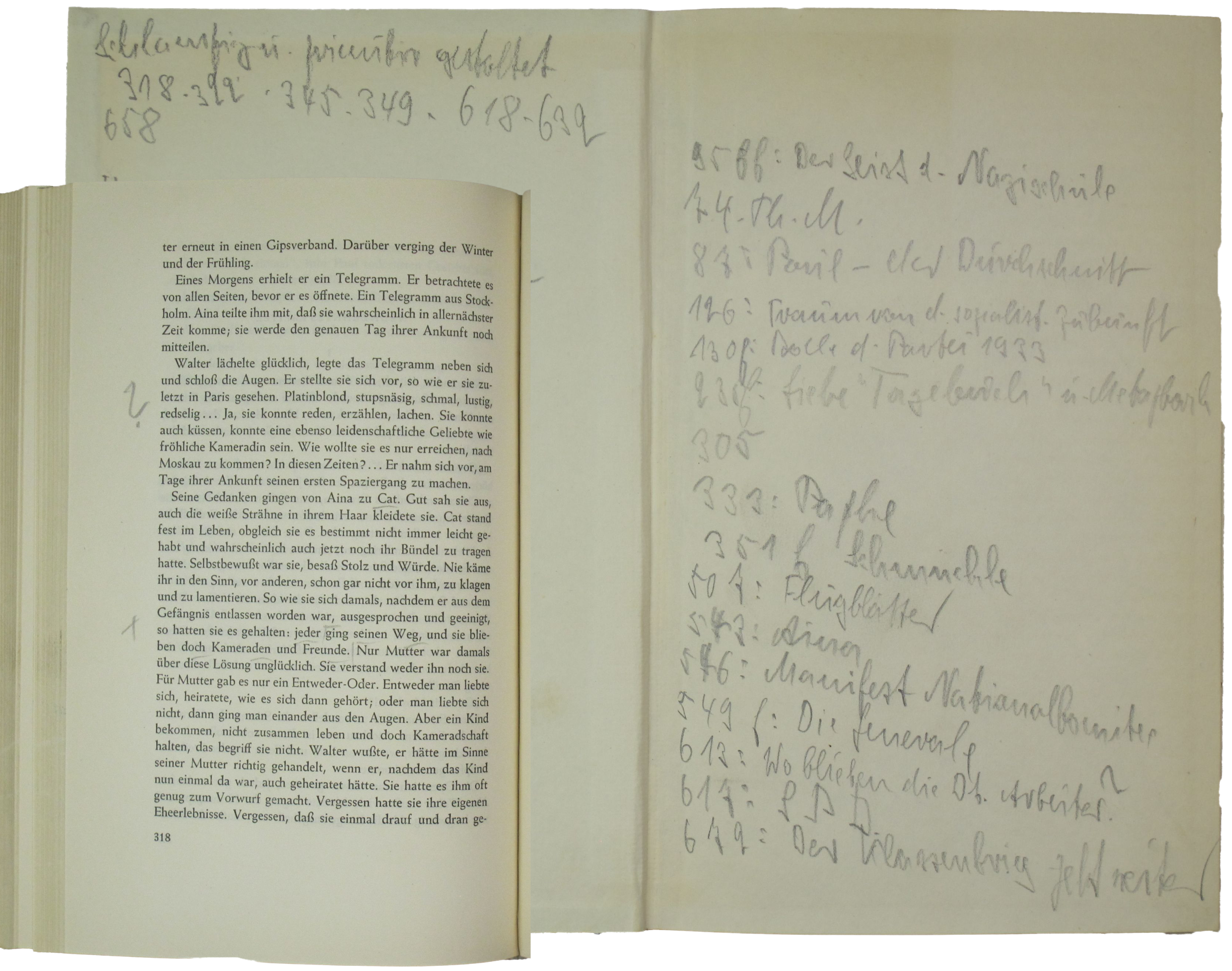
Traces of Work and Reading with Recognition Value
Alfred Kantorowicz was an avid reader and left expressive traces in his books. On the endpapers or other blank pages, Kantorowicz handwrote page numbers in pencil and occasionally added a few keywords. On the corresponding pages, he marked the passages of interest to him with underlining or marks in the margin.
In doing so, he also dealt with the works of German writers with whom he was personally acquainted and with whom he had often shared the fate of exile under the Nazi regime. He found Willi Bredel's work Die Enkel (The Grandchildren), for example, less than convincing. He described the third volume of the story of a Hamburg workers' family in the fight against fascism on the endpaper of his copy as "sloppily and primitively constructed" and also gave page numbers to support his opinion.
Alfred Kantorowicz's Notes and Marks on Willi Bredel's "Die Enkel" (The grandchildren)
Aus der Sammlung von
Wie darf ich das Objekt nutzen?
Quelle
Staatsbibliothek zu Berlin
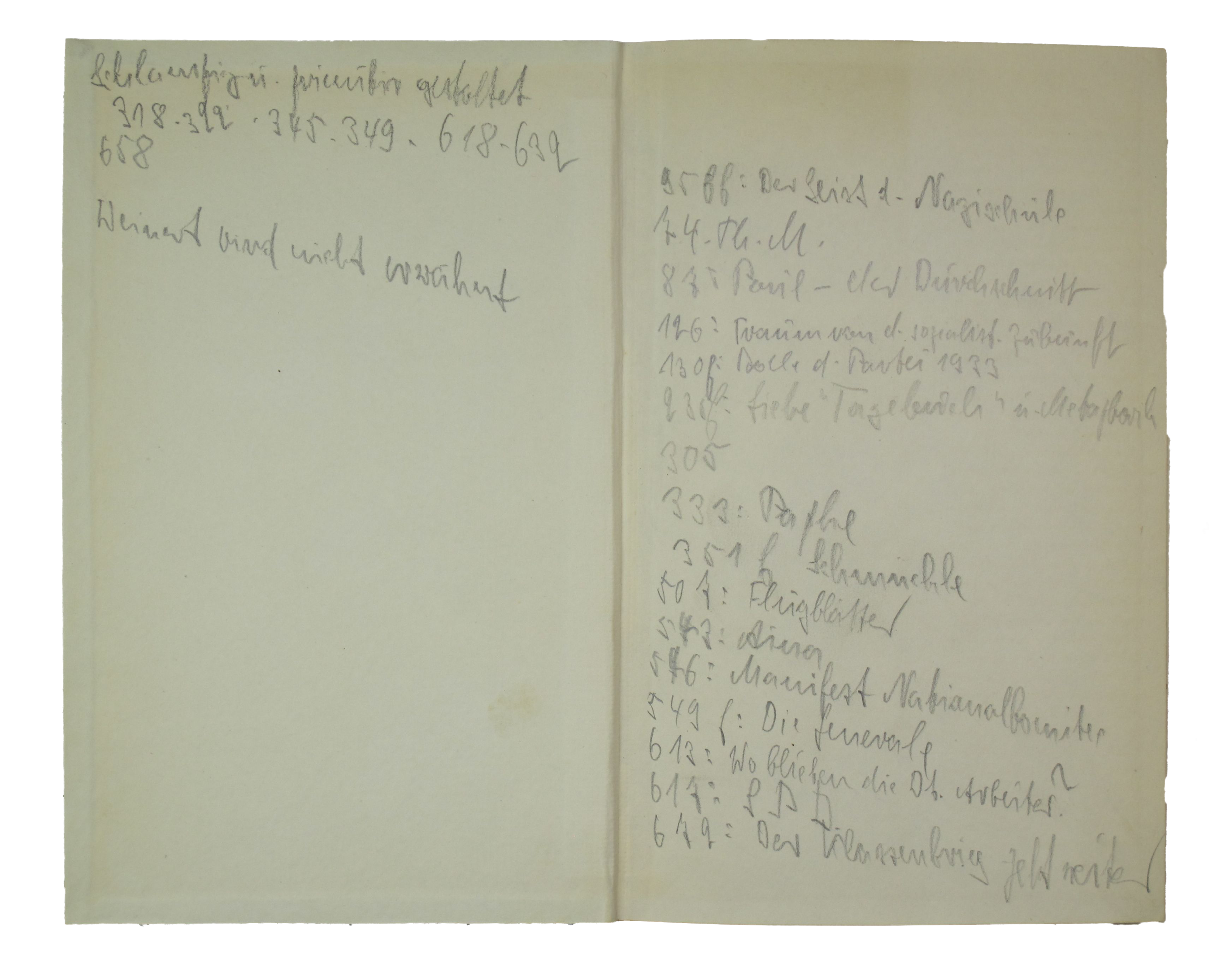
Alfred Kantorowicz
around 1937
Aus der Sammlung von
Wie darf ich das Objekt nutzen?
Quelle
bpk-Bildagentur/ Fred Stein
Kurzbeschreibung

Alfred Kantorowicz
Alfred Kantorowicz (1899-1979) was a literary scholar, writer, communist and Jewish. He studied law and German, then worked as a journalist in Berlin. In the early 1930s he became politically involved with the Kommunistische Partei Deutschlands (KPD). When the National Socialists came to power, he emigrated to Paris, where he campaigned for German writers in exile and joined the International Brigades during the Spanish Civil War. After the beginning of World War II, he barely managed to leave the country for the USA.
In 1946 he returned to Germany and continued his political commitment in East Berlin. He founded his own publishing house and edited the journal Ost und West (East and West). As a publisher, he advocated mediation between the capitalist and socialist-communist camps, but soon had to give up his activities. After the founding of the GDR, he accepted a professorship in literature at Berlin Humboldt Universität, but he had difficulty integrating into the political system under the SED regime. His political hopes were not fulfilled, so he decided to flee to the West Germany in 1957, where he lived in Munich and from 1962 in Hamburg.
Ernst Toller, Die Wandlung. Das Ringen eines Menschen, (=The transformation. The struggle of a man) Potsdam: Kiepenheuer, 1919
Aus der Sammlung von
Wie darf ich das Objekt nutzen?
Quelle
SBB
Alfred Kantorowicz annotated a book of the drama Die Wandlung (The Transformation) written by Ernst Toller. This theater-play about a young soldier in a fictitious war, processed Toller's own experiences of World War I.
It is possible that Kantorowicz's marks became relevant in the summer of 1952 during his preparations for a lecture at the Berlin Humboldt Universität on the upheavals in German drama after World War I.
Alfred Kantorowicz, Die Verbündeten (=The Allies), Berlin: Aufbau-Bühnen-Vertrieb, 1950
Aus der Sammlung von
Wie darf ich das Objekt nutzen?
Quelle
SBB
Kurzbeschreibung

Expropriation of the Berlin Library
When Alfred Kantorowicz fled to the FRG, he left behind his library of 4,000 volumes in his apartment in East Berlin. At the instigation of the Staatssekretariats für Hochschulwesen (State Secretariat for Higher Education) and with the participation of the Ministerium des Innern (Ministry of the Interior) of the GDR, it was confiscated and transferred to the Deutsche Staatsbibliothek (German State Library) in 1958, where the scholars' library initially remained unprocessed.
In the West, Alfred Kantorowicz began to build a new library after 1957.
The Berlin library of Alfred Kantorowicz remained unprocessed in the Staatsbibliothek zu Berlin until 2010, when the ownership situation was finally clarified. In the context of this, a merger of the Berlin library with the estate and the library bequeathed by Alfred Kantorowicz to the Staats- und Universitätsbibliothek (SUB) Hamburg in 1969 was examined. After the SUB Hamburg refused to take over the Berlin library for capacity reasons, the collection was cataloged and researched with all its provenance traces in the Department of Early Printed Books of the Staatsbibliothek zu Berlin by Michaela Scheibe and Jörg Kramer .
The author Friederike Willasch is a research assistant in the Abteilung Historische Drucke (Department of Early Printed Books) at the Staatsbibliothek zu Berlin.
Missal from 1651
Aus der Sammlung von
Museum Novgorod
Digitised: Staatsbiliothek zu Berlin
Wie darf ich das Objekt nutzen?
"Narrative about the Holy Book called Missal"
During the German occupation of Novgorod in World War II, a missal from 1651 was taken to Riga along with other Slavic-language volumes. They were to be integrated into the "Ostbibliothek" (Eastern Library) of the Einsatzstab Reichsleiter (Head task force) Rosenberg, which was under construction.
Not all books returned to Novgorod after the war. Individual copies reached Germany - among other places they came to the Staatsbibliothek in Berlin (East).
Missal from 1651
Aus der Sammlung von
Museum Novgorod
Digitised: Staatsbiliothek zu Berlin
Wie darf ich das Objekt nutzen?

Služebnik - Missal
The embossed leather cover of the missal is decorated with symbolic representations of animals. In the four corners you can see, among others, a lion and a unicorn. The center of the book cover depicts a pelican feeding its young above the silhouette of a city. In Christian iconography, this bird is used as an allegory for Jesus Christ: He feeds his young with the blood that flows from his torn open breast. This design is typical of the Moscow printing court in the 17th century.
The missal printed in Moscow is completely preserved. Numerous decorative woodcuts as well as the typeface and page design in red and black print make it interesting from an artistic point of view. In addition the digital copy, which was created before the book was returned to the museum in Novgorod, is an important object of research.
To the digital copy of the missal
First page of the Missal
1651
Aus der Sammlung von
Library of the Nowgorod Museum
Wie darf ich das Objekt nutzen?
Quelle
SBB

Without Title
A title or title pages, as we know them from Western European books of the time, did not exist in the Moscow prints of the 17th century. The missal begins quite typically with a detailed introduction that gives the year of publication and explains the reasons for printing the missal.
It is a narrative about the holy book, called the missal. It was printed by the order of Tsar and Grand Prince Alexei Mikhailovič (1629-1676) of all Russia, with the blessing of the Most Holy Patriarch Iosif († April 15, 1652) of Moscow and all Russia, as well as the whole holy council. From the first sentence of this introduction one derives the title of the book.
Skazanie o svjatěj knizě sej, glagoleměj služebnikě
Translated from Church Slavonic into English:
Narration about the holy book, called missal.
Entry book header Služebnik
Aus der Sammlung von
Wie darf ich das Objekt nutzen?
Quelle
SBB
In the missal (služebnik) there is a handwritten entry which assigns it to the library of the monastery "Anthony the Roman" in Novgorod.
On the basis of the note из нова города антониева монастыря римлянина the provenance of the služebnik was established. It states approximately:
"From the monastery of St. Anthony in the new city (=Novgorod)".
The work itself represents a precursor to the Služebnik of the Nikonian reforms of 1655. In the course of the reforms of Patriarch Nikon (1605-1681), the Služebnik was newly translated from Greek. The missal of 1651, on the other hand, had been corrected only very sporadically and cautiously in a few selected places.
How this magnificent edition came to Novgorod to St. Anthony's Monastery can most probably no longer be clarified.
Stamp Novgorod
Aus der Sammlung von
Novgorod Museum
Wie darf ich das Objekt nutzen?
Kurzbeschreibung
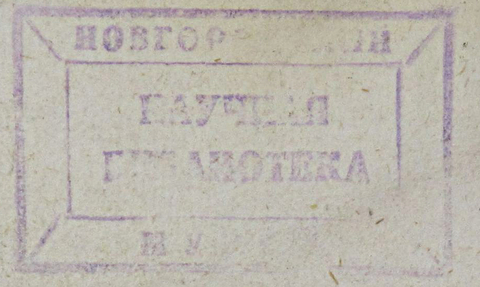
Property of the Novgorod Museum Library
Novgorod was occupied by German troops from 1941 to 1944. Among the cultural goods that the Germans removed were over 30,000 books.
Where the volumes went is known only in part. The Einsatzstab Reichsleiter Rosenberg planned to establish an "Ostbibliothek“ in Riga, presumably the missal was to be integrated there. How it finally reached the Deutsche Staatsbibliothek in Berlin (East) cannot be reconstructed today. During the systematic examinations of suspicious holdings, which the Staatsbibliothek zu Berlin has been carrying out for several years, the missal was identified by this pre-war stamp as Novgorod property.
Riga, Einsatzstab Reichsleiter Rosenberg (ERR) office, book depository
November 1943, Riga
Aus der Sammlung von
Wie darf ich das Objekt nutzen?
Quelle
Bundesarchiv
Kurzbeschreibung
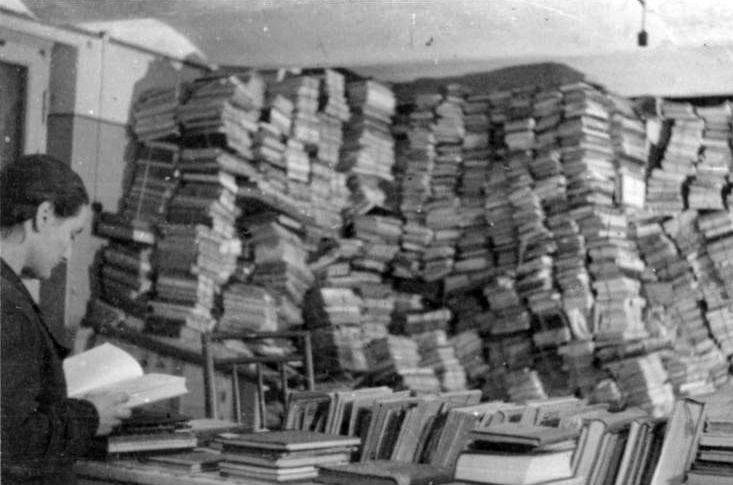
The Church of the Nativity with its necropolis, Novgorod
October 2014
Aus der Sammlung von
WIkicommons
Wie darf ich das Objekt nutzen?
Quelle
Sterndmitri
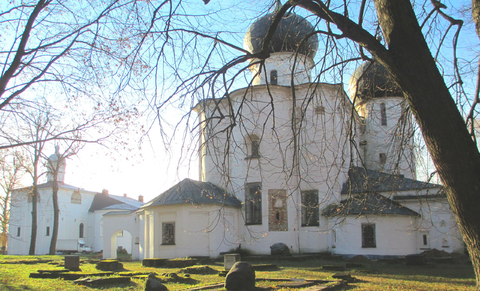
The Library of the Monastery of St. Anthony
Since the 19th century, the Church Slavonic missals from the 17th century were no longer used in Orthodox practice. It is all the more astonishing that the book, although it had religious value only for the Orthodox Old Believers (Raskolniki), was kept in St. Anthony's Monastery. The 1651 edition probably had more symbolic value within the library.
From the important library of this monastery, one of the oldest in northwestern Russia, only 15 books have survived today.
The missal was restituted to the Novgorod Museum in 2015. This return sent an important signal. As part of the Deutsch-Russischen Bibliotheksdialogs (German-Russian Library Dialogue), another book was restituted to the museum in Novgorod in 2018.
Prof. Dr. Hermann Parzinger, President of the Stiftung Preußischer Kulturbesitz:
...The restitution underscores the trusting and cooperative approach in German-Russian cultural relations. Even if the major political questions concerning the cultural assets transferred as a result of the war are still awaiting a solution, the German-Russian professional contacts continue to develop and are as intensive as rarely before...
The project coordinator for provenance research at the Stiftung Preußischer Kulturbesitz, Doris Antonides-Heidelmeyer, in cooperation with the provenance researcher of the Staatsbibliothek zu Berlin, Regine Dehnel, has prepared this contribution on the biography of the "Služebnik - Missal" in terms of content and visuals.
Rudolph Lepke's Kunst-Auctions-Haus (catalog no. 2082)
Aus der Sammlung von
Staatliche Museen zu Berlin – Kunstbibliothek
Wie darf ich das Objekt nutzen?
Quelle
Staatliche Museen zu Berlin – Kunstbibliothek
Kurzbeschreibung
Lot 721 - Flat black Lacquer Toiletry Box
In November 1934, Leopold Reidemeister (1900-1987), at that time the curator of the Ostasiatische Kunstsammlung (East Asian Art Collection), acquired a small Chinese lacquer box for 69.44 Reichsmark at an auction at Rudolph Lepke's Kunst-Auctions-Haus on Potsdamer Strasse in Berlin.
Lacquer Box from China
Aus der Sammlung von
Staatliche Museen zu Berlin – Museum für Asiatische Kunst
Wie darf ich das Objekt nutzen?
Quelle
©Staatliche Museen zu Berlin – Museum für Asiatische Kunst
Kurzbeschreibung
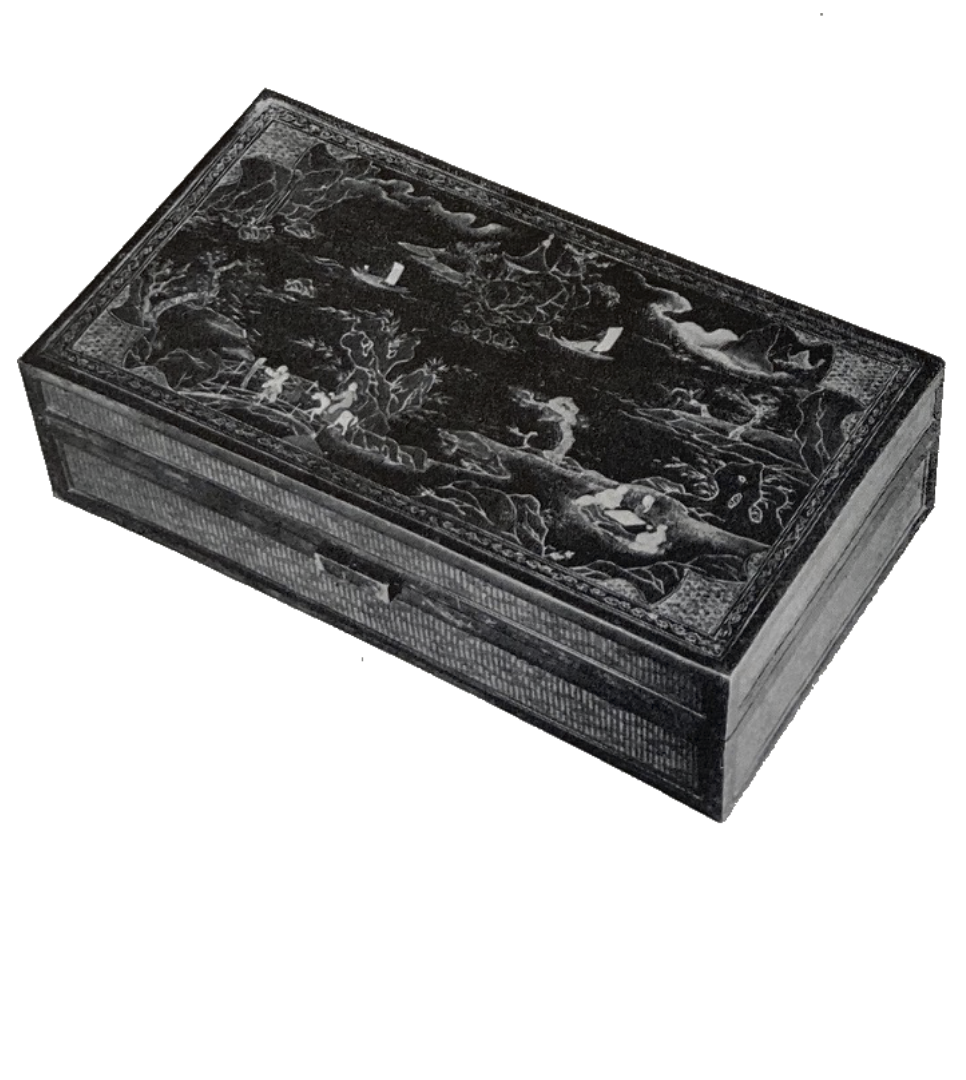
On the object card of the Museum für Ostasiatische Kunst (Museum of East Asian Art) the lacquer box is described as follows:
Rectangular box, wood, the edges bordered with metal rails, on the sides wickerwork with swastika pattern, painted black on the outside, red inside, on the lid inland lake landscape with sailing ships, bridge with rider and load carrier, on the right three go-players in green, red, white and gold lacquer painting . On the bottom inscription in red lacquer.
Letterhead of R. Wagner Kunst- und Verlags-Handlung
Aus der Sammlung von
Staatliche Museen zu Berlin – Zentralarchiv
Wie darf ich das Objekt nutzen?
Quelle
©Staatliche Museen zu Berlin – Zentralarchiv
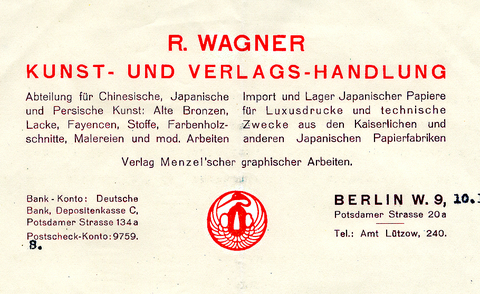
The lacquer box formerly was in the inventory of the Berlin East Asian art shop R. Wagner, which had been established in the 1880s and was one of the leading shops of its kind in Germany. Walter Elkan (1868-1963) became owner of the company in 1912. As a Jew, he was persecuted by the National Socialists from 1933 on.
In addition to the lacquer box, around 150 objects from the stock of this art dealer were auctioned off by Rudolph Lepke's Kunst-Auctions-Haus in November 1934.
Catalog, Auction House Lepke, lot 721
Aus der Sammlung von
Staatliche Museen zu Berlin – Kunstbibliothek
Wie darf ich das Objekt nutzen?
Quelle
©Staatliche Museen zu Berlin – Kunstbibliothek

Catalog No. 2082
The auction catalog from November 15 and 16, 1934 lists the lacquer box as lot 721 within the auction of decorative arts of the 16th to 19th centuries: furniture, Meissen, Sèvres and English porcelain, silver, miniatures and boxes, carpets, East Asian art.
Digital copy of the auction catalog
Invoice Auction House Lepke
Aus der Sammlung von
Staatliche Museen zu Berlin – Zentralarchiv
Wie darf ich das Objekt nutzen?
Quelle
©Staatliche Museen zu Berlin – Zentralarchiv
Invoice from "Rudolph Lepke's Kunst-Auctions-Haus" for the acquisition of the lacquer box by the Museum für Ostasiatische Kunst (Museum of East Asian Art).
(SMB-ZA, I/MfV, OAK 006, file 1260/34, sheet 239, recto)
The Chinese lacquer box is among the war losses of the World War II. It is possible that it reached the Soviet Union as trophy art after 1945.
The term "trophy art" refers to cultural objects that were taken away as a result of war, in the case described here, the objects that were taken to the Soviet Union by members of the Russian army after the end of World War II in 1945. After 1945, 90% of the former Ostasiatische Kunstsammlung (East Asian Art Collection) has been considered as war loss. The largest part of it, about 5,400 objects, was taken to the Soviet Union by the Red Army as trophy art.
Christine Howald is deputy director of the Zentralarchiv (Central Archive) at the Staatlichen Museen zu Berlin and is responsible for the provenance research on the collections of the Museum für Asiatische Kunst (Museum of Asian Art) and the Asian Collections of the Ethnologisches Museum. She discovered that from 1934 onwards the box was part of the collection of the former East Asian Art Collection.
Currently, Walter Elkan's heirs are researching the whereabouts of the lacquer box through the Lost Art Internet Database of the Deutsches Zentrum Kulturgutverluste (German Lost Art Foundation).
Search Notice: Flat black lacquer toilet box - single object
Die Lebensgeschichte des Denkens
Aus der Sammlung von
Staatsbibliothek zu Berlin (Restitution in preparation)
Wie darf ich das Objekt nutzen?
Quelle
©Staatsbibliothek zu Berlin / Photo: Thomas Rose
Kurzbeschreibung
~The Life Story of Thought : a commonly understood overview of the development of Western world views
From the preface of the book:
"Therefore it must be made possible that the widest possible circles of people get to know and enjoy the life story of thinking and its most beautiful fruits of knowledge. The present generally understandable overview serves this purpose. It can be understood by every person who develops the will to think. A philosophical background is not required, but should be conveyed in a genuine sense through this work."
A Chronicle of Thought
The German rabbi Leo Baeck (1873-1956) owned an extensive private library, which was located in his apartment in Berlin-Schöneberg until his deportation. Until today, little has been learned about the whereabouts of the many thousands of books from the confiscated library.
The Lebensgeschichte des Denkens (Cronicle of Thought) is one of the rare chance finds from Baeck's possession. How the book found its way into the holdings of the Staatsbibliothek zu Berlin could be reconstructed thanks to a clear dedication and various stamps.
Collage: Hans-Hasso von Veltheim-Ostrau reading/ Leo Baeck reading
Aus der Sammlung von
Veltheim Estate / Leo Baeck Institute
Wie darf ich das Objekt nutzen?
Quelle
©Familienarchiv von Veltheim mit freundlicher Genehmigung, Collage: Doris Antonides-Heidelmeyer/ Staatsbibliothek zu Berlin
Kurzbeschreibung
Hans-Hasso von Veltheim-Ostrau: Archive material of the von Veltheim family in the Saxony-Anhalt State Archives (LHASA) in Wernigerode
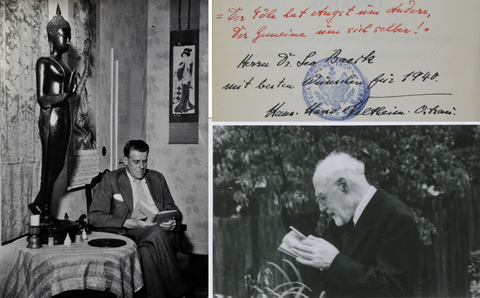
Leo Baeck and Hans-Hasso von Veltheim-Ostrau
This dedication is a testimony of a friendship between two bibliophiles and scholars that lasted for many years.
The writer, antiquarian, cosmopolitan and art dealer Hans-Hasso von Veltheim-Ostrau (1885-1956) and Leo Baeck met in 1921 in Darmstadt at Hermann Graf Keyserling's Schule der Weisheit (School of Wisdom). Veltheim was interested in questions that went beyond the self-understanding of individual religions and involved a spiritual sensitization. From then on, he maintained an exchange of ideas on the philosophy of religion with Leo Baeck. A lively correspondence, which has been preserved almost without gaps, testifies to this deep friendship, which lasted through the Nazi era and World War II until Veltheim's death in 1956.
Baeck and Veltheim met regularly in Munich and Berlin. However, only one visit in 1932 of Baeck to Ostrau Castle is confirmed. Veltheim had renovated and transformed his castle into a place of West-East encounters and invited Baeck more often.
Ostrava Castle - View of the Side Wing
July 2012
Aus der Sammlung von
Wikicommons
Wie darf ich das Objekt nutzen?
Quelle
©Concord

Animus imperat adsum amicis - Where the Spirit rules, I am among Friends
On the basis of the gift of the book, Veltheim-Ostrau's caring role within a network of scholars, with room for diverse world views, can be sketched. In the pre-war period, with its frightening portents, Leo Baeck followed the developments around Ostrau Castle and his friend Veltheim with great interest. In response to his friend's invitation to an event on September 18, 1931, Leo Baeck expressed:
Some things would be better if there were still some Ostraus in the country.
From 1929 until the war period, events such as lectures, poetry readings and concerts took place while the castle was still being renovated. Veltheim invited numerous German and foreign guests to his estate: Philosophers, poets, natural scientists, psychologists, musicians, visual artists and researchers in many fields. On March 3, 1934, the anthroposophist Sigismund von Gleich (1896-1953) spoke here. In Ostrau's guest book on March 6 he left this statement:
Every visit to Ostrau lets me recognize more clearly and with astonishment the wide-stretched essential network of destiny in which I may know myself to be interwoven here; I can sense - though still groping uncertainly - possible constellations of our future.
During the Nazi period Veltheim took care of Baeck, after the war this situation was reversed. In a letter to Baeck, Veltheim wrote on April 30, 1946:
Please see, venerable teacher and friend, that I have taken you and your exemplary life in bearing the blows of fate as my model, and that I am endeavoring, within the very small framework of possibilities still left to me, to emulate your great, comprehensive present work of reconciliation and love.
Acession journal of the Prussian State Library Dona Deutsch 1942-1947, accession no. D 1943.378
Aus der Sammlung von
Wie darf ich das Objekt nutzen?
Quelle
©Staatsbibliothek zu Berlin
Kurzbeschreibung

Lebensgeschichte des Denkens - The Copy's History
The book gift to Leo Baeck came from Hans-Hasso von Veltheim-Ostrau, to whom the author Sigismund von Gleich dedicated the manuscript in 1939.
The accession book of the Preußische Staatsbibliothek (Prussian State Library-PSB) records the receipt of the book on September 14, 1943, eight months after Baeck's deportation, as a "gift" from the Gestapo. Therefore, it is inventoried as a "donum" (D).
After the end of the war, when the state borders between Germany and Poland were redefined, the book, which had been removed to Silesia before 1945, arrived at the University Library in Warsaw with many others. In Berlin (East) it is recorded as a war loss. In 1965, however, it was returned to the German State Library as part of the "Rückführung von Beständen aus Polen (RüBePol)" (Repatriation of Holdings from Poland) campaign.
There, in the course of the systematic examination of holdings suspected of being looted, the book was clearly identified as belonging to Leo Baeck on the basis of the dedication.
The restitution to Leo Baeck's heirs is in preparation.
Link to the Catalog of the Staatsbibliothek zu Berlin (StabiKat)
Signature: Baeck
Aus der Sammlung von
Wie darf ich das Objekt nutzen?
Quelle
©Staatsbibliothek zu Berlin
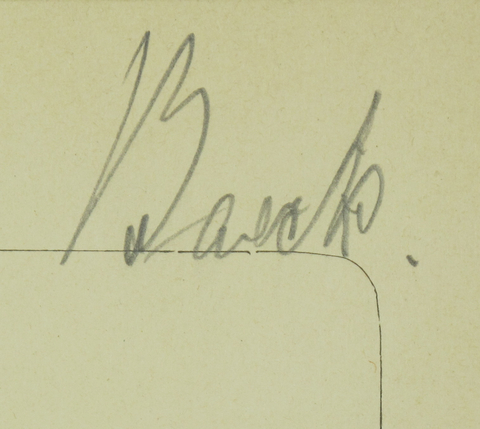
Leo Baeck's Library
Leo Baeck began to build up a library in 1897 with his first appointment as rabbi in the small Silesian town of Opole. After 40 years of collecting, it contained approximately 4,000 volumes.
On January 27, 1943, Leo Baeck was deported to Theresienstadt. Four weeks later, his private library was packed into sacks by the Gestapo and transported away.
After his liberation from the concentration camp, which he had survived as a prominent prisoner with special rights, Baeck tried to recover his library. For this purpose, he drew up from memory several lists of the more valuable books that were important to him.
Thirty-seven of his books were identified in the holdings of the "Offenbach Archival Depot" (OAD) established by the Western Allied forces and handed over to Baeck's lawyer in May 1951. The OAD primarily collected archival materials and books previously looted by the Nazis and prepared them for restitution.
The rest of Baeck's books went very different ways, the majority is considered lost to this day.
based on a graphic by Bettina Farack
Master Thesis, 2018, Berlin
Aus der Sammlung von
Humboldt Universität zu Berlin
Wie darf ich das Objekt nutzen?
Quelle
Bettina Farack
Kurzbeschreibung

Books from the Library of Leo Baeck
Aus der Sammlung von
Formerly Staatsbibliothek zu Berlin, restituted 2006
Wie darf ich das Objekt nutzen?
Quelle
©Staatsbibliothek zu Berlin
Kurzbeschreibung

Dispersal of the Leo Baeck Library
In 1944, holdings of the Preußische Staatsbibliothek were also moved to Hesse to protect them from war damage. From here, after three decades in Marburg, many books were transferred to the Staatsbibliothek zu Berlin (West) in the 1970s. In the early 2000s, books from the Leo Baeck Library were also discovered in this largely unprocessed old collection.
The clear provenance marks in Baeck's copy of the Lebensgeschichte des Denkens von Sigismund von Gleich, however, point to the route via the East, which many books also took.
A total of 23 books gradually came to light. In 2006, in the first restitution, 17 volumes, which were certainly books from Baeck's fragmented library, were returned to his granddaughter in New York.
Attempts to find further volumes via the reconstruction of the catalog of his library mainly document what was lost. For only 27 titles can it be stated today where they are or which paths they have taken.
It cannot be ruled out that further books by Leo Baeck were integrated into the holdings of the Staatsbibliothek, possibly only provenance marks are missing to correctly assign them.
Hans-Hasso Veltheim-Ostrau in the Castle Library
Aus der Sammlung von
Archivmaterial der Familie von Veltheim im Landesarchiv Sachsen-Anhalt (LHASA) in Wernigerode
Wie darf ich das Objekt nutzen?
Quelle
©Courtesy Family Archives von Veltheim
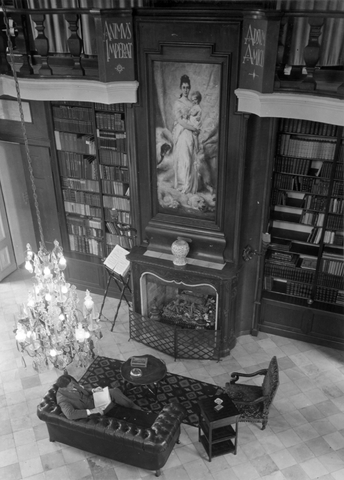
Ostrau Castle Library
Baeck's friend Veltheim lost his castle library, in which about 20,000 volumes had been placed until 1945, only after the end of the war. He fled the Soviet occupation zone across the inner-German border on October 12, 1945. As a large landowner he had shortly before been informed, of the complete expropriation of his property. Immediately after Veltheim's escape, looting and vandalism occurred. Eyewitnesses reported that books from the library were discarded at the garbage dump. It can be assumed that in the following period many cultural objects stored in Ostrau were taken to the Soviet Union together with objects from Veltheim's property.
In 1949, the books, archives, furniture, and art objects still remaining in the castle were transported away as part of the "Kulturgutsicherstellung“ (Safeguarding of Cultural Goods) program organized centrally in Saxony-Anhalt. Veltheim's books, like the additions from other castles and manor houses in Saxony-Anhalt, were integrated into the holdings of the Halle University Library. Several thousand volumes of Hans-Hassos von Veltheim-Ostrau's library were thus "saved" and are now on deposit in the Universitäts- und Landesbibliothek Sachsen-Anhalt (ULB). They are placed together with Veltheim's handwritten materials in the Historical Collections.
Some of the volumes handed over by the ULB Halle came to the Staatsbibliothek zu Berlin via the Zentralstelle für wissenschaftliche Altbestände (Central Exchange Office for Academic and Research Libraries).
The project coordinator for provenance research at the Stiftung Preußischer Kulturbesitz, Doris Antonides-Heidelmeyer, in collaboration with Heike Pudler, head of the section for provenance indexing at the Department of Early Printed Books at the Staatsbibliothek zu Berlin, has prepared this article on the book "Die Lebensgeschichte des Denkens" and on the fate of the private libraries of Leo Baeck as well as of Hans-Hasso von Veltheim-Ostrau in terms of content and visuals.
Drottningholm Palace Library, Library of Luise Ulrike of Prussia, Queen of Sweden (1720-1782)
Aus der Sammlung von
Wie darf ich das Objekt nutzen?
Quelle
Holger Ellgaard
What did high-noble Ladies read - And what didn't they Read?
A single book can tell a lot about the reading habits of its owner. Entire collections can tell a lot more, but even the libraries of princesses have rarely been preserved. Traces of the book collectors close to the Prussian court are found repeatedly by the provenance researchers of the Staatsbibliothek zu Berlin. In 2017, provenances of high-ranking Prussians were one of the reasons for the acquisition of the "Prinzessinnenbibliothek“ (Princess Library), the preserved private library of Princess Sofia Albertina of Sweden (1753-1829), a niece of Frederick the Great.
Spine of books from the "Princess Library"
Aus der Sammlung von
Wie darf ich das Objekt nutzen?
Quelle
©Staatsbibliothek zu Berlin
Kurzbeschreibung

Luise Ulrike's own handwritten note about a gift of a book to her daughter
Aus der Sammlung von
Wie darf ich das Objekt nutzen?
Quelle
Staatsbibliothek zu Berlin
Kurzbeschreibung
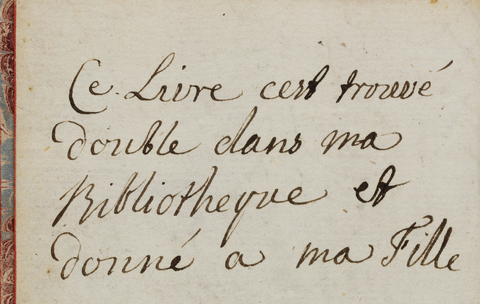
Sofia Albertina built up her library through her own acquisitions, but also integrated books from her grandmother, the Prussian Queen Sophie Dorothea, who was a member of the House of Hanover, and her mother, the sister of Frederick the Great and Swedish Queen Luise Ulrike. The result is a testimony, developed over three generations, to the reading habits of women from the European high nobility of the 18th and early 19th centuries.
Luise Ulrike married the Swedish crown prince Adolf Friedrich in 1744, who was elected Swedish king in 1751. As Swedish queen, the intellectual and art-loving Luise Ulrike maintained a brilliant court in her castle at Drottningholm, which clearly followed the French model. The relationship with her brother Frederick was close, as correspondence shows. While the official collections at Drottningholm Castle were confiscated by Adolf Friedrich's successor Gustaf III after his death in 1777 and are therefore now in state ownership, Luise Ulrike was apparently able to continue to make her own decisions about her private book collection.
Sofia Albertina of Sweden
Aus der Sammlung von
Wikipedia / Swedish National Museum
Wie darf ich das Objekt nutzen?
Quelle
Wikipedia
Kurzbeschreibung
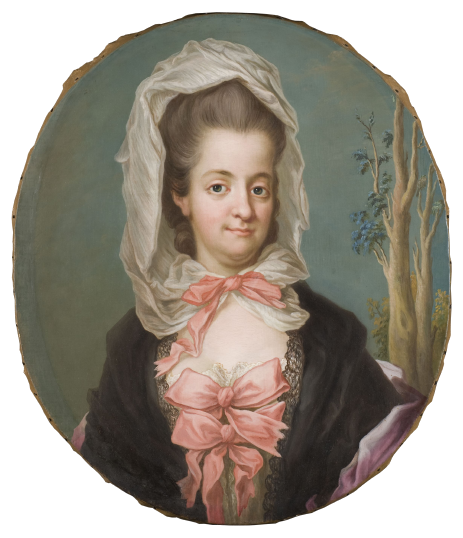
In 1767, after various failed marriage plans, Luise Ulrike's only daughter, the Swedish princess Sofia Albertina was elected coadjutor of the Protestant Imperial Abbey of Quedlinburg. Twenty years later she succeeded her aunt, Frederick the Great's youngest sister Anna Amalie, who had died in 1787, as abbess. She used her new position to initiate not only social projects but also a small court theatre, the first Quedlinburg theatre. As early as 1790, Sofia Albertina again spent most of her time in Sweden, and in 1803 she returned there for good after the abolition of the monastery by the "Reichsdeputationshauptschluss" (Imperial Recess of 1803). As the "last of the House of Wasa," she maintained a friendly relationship with the new Swedish royal dynasty of Bernadotte, which had been the designated successor by adoption since 1810.
Princess Sofia Albertina of Sweden died on March 17, 1829, unmarried and childless. In her will, she named her Lord Chamberlain Countess Lolotte Stenbock - presumably the natural daughter of King Adolf Friedrich and thus her half-sister - and her only son Magnus Stenbock as universal heirs. Her library was inherited as a whole in the male line of the Stenbocks, as stipulated in the will, until the death of the last male descendant in 1988.
Les amans (The Lovers), passage from the melodrama "Le Brigand De Venise" by Matthew G. Lewis
Aus der Sammlung von
Wie darf ich das Objekt nutzen?
Quelle
©Staatsbibliothek zu Berlin
Kurzbeschreibung
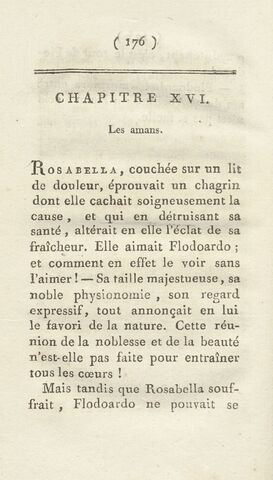
Sofia Albertina invested considerable sums in new acquisitions for her library. Several times a year she received book shipments worth 400 to 600 Reichstaler from Paris. Book purchases are also documented during her stay in Quedlinburg, as well as during her trip to Italy in 1792/1793. The 4,500 volumes in the collection reflect the scope of female education in the European aristocracy: almost exclusively French-language titles from the 17th to 19th centuries, primarily fiction, but also the works of Frederick the Great, historical treatises, aristocratic calendars, biographies, travel literature and illustrated works, engraving portfolios, and finally individual manuscripts.
Some remained unread: In addition to volumes that appear hot off the press and barely opened, there are books with uncut quires, which consequently cannot have been read at all. In the case of some volumes, the owner may not have had time to read them, but there are also historical works that published several years before her death, such as the military writer Mathieu Dumas' account of the Napoleonic wars.
In addition, the "Princess Library" contains books that the noble ladies obviously enjoyed reading: Alongside classics of literature by Goethe, Schiller and Shakespeare are collections of letters and memoirs, mainly of a gallant nature, as well as many adventure novels up to Robinson Crusoe, even the Leatherstocking Tales - all preferably in French translation.
Fashion plate from "Journal des Dames et des Modes", Paris 1801-1822
Aus der Sammlung von
Wie darf ich das Objekt nutzen?
Quelle
Staatsbibliothek zu Berlin

Fashion Victim - Even Back Then?
Sofia Albertina subscribed to at least three fashion and women's magazines, two of them from Paris. In addition to the latest fashions presented in hand-colored plates, they included theater reviews, reading tips, and song supplements. In contrast, the German "Journal für Fabrik, Manufaktur, Handlung, Kunst und Mode" (Journal of Factory, Manufacture, Trade, Art, and Fashion) , which was also in her library, appears much more sober: trade and customs modalities, commodities, prices and novelties, but including many fabrics with detailed descriptions of the weaving processes, patterns and pasted fabric samples.
Dedication to the Emperor and bookplate of the Empress in the travelogue "Zum Schneedom des Kilimandscharo" by Hans Meyer, 1888
Aus der Sammlung von
Wie darf ich das Objekt nutzen?
Quelle
Staatsbibliothek zu Berlin / Photos: Thomas Rose / Image editing: Doris Antonides-Heidelmeyer
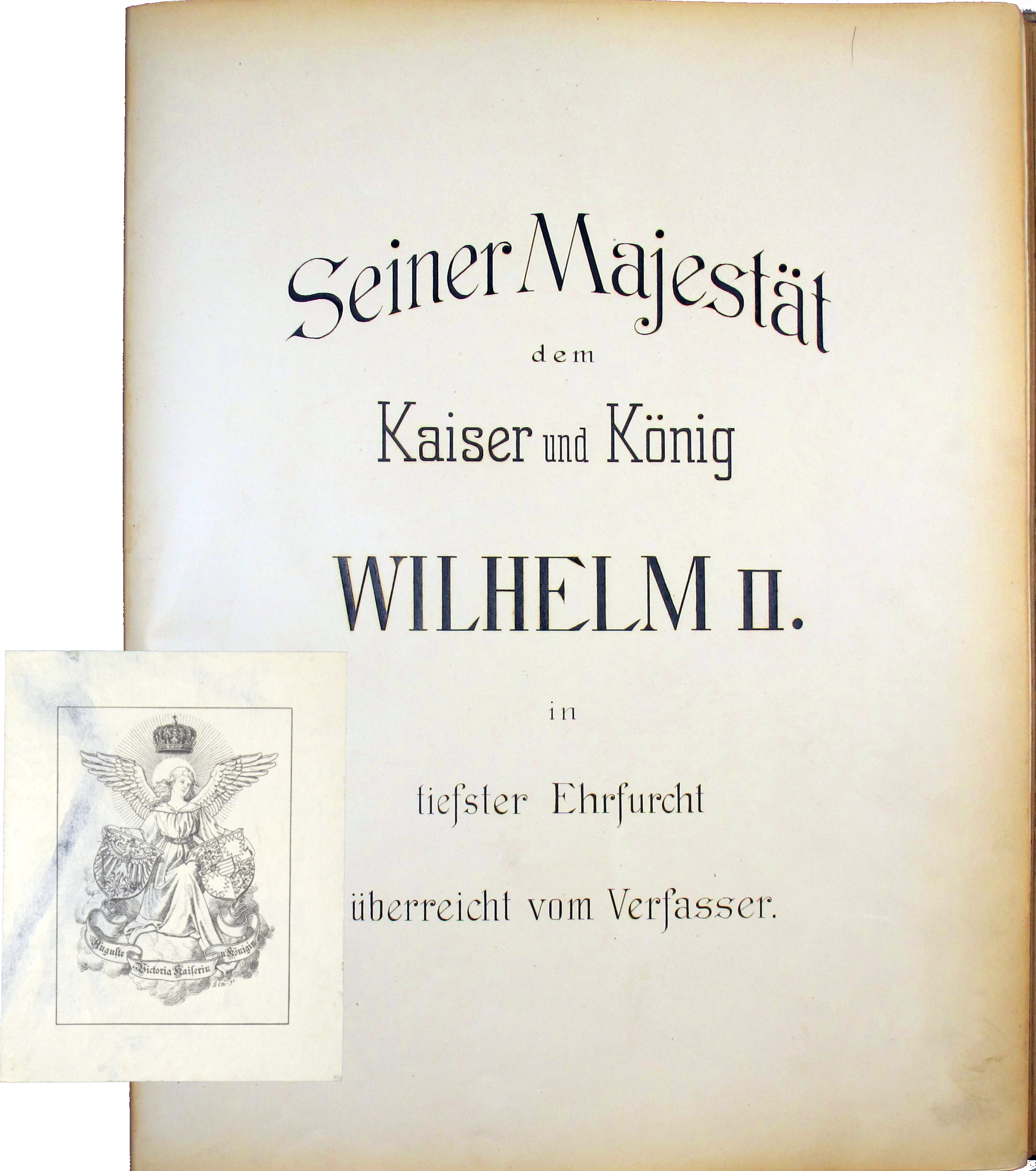
Single copies with provenance traces of German empresses from the late 19th century discovered in the holdings of the Staatsbibliothek tell further interesting stories.
Hans Meyer (1858-1929), geographer and scion of the Leipzig publishing family known for Meyer's Konversations-Lexikon, undertook numerous research trips around the world. Hans Meyer published a report of his second trip to Africa entitled "Zum Schneedom des Kilimandscharo" (To the Snowy Dome of Kilimanjaro), illustrated with photographs and maps and with an eye-catching publisher's binding. Kilimanjaro belonged to the colony of German East Africa of the German Empire from 1885 to 1918. It was through such works that the far-flung colony entered public lending libraries as well as German homes and classrooms.
A unique copy of the Kilimanjaro Book of 1888 preserved in the Staatsbibliothek has a printed dedication page, with which the author dedicated this work to the newly crowned German Emperor Wilhelm II. The bookplate inside identifies this very book as part of the library of his wife, the Empress Auguste Viktoria. Since 1893, she used the motif of an angel bearing a coat of arms, created by Georg Otto, on her bookplate. Whether the actual recipient of the dedication, Emperor Wilhelm II, already owned the book and passed it on, whether it accidentally ended up in his wife's library, or whether Auguste Viktoria wanted this work at all costs, must remain a matter of speculation.
Link to the digital copy of the Staatsbibliothek zu Berlin
Handwritten dedication of the empress "Kaiserin Friedrich"
Aus der Sammlung von
Wie darf ich das Objekt nutzen?
Quelle
Staatsbibliothek zu Berlin / Photo: Thomas Rose
Kurzbeschreibung

Beyond cultivating their own private libraries, the high noble ladies in Prussia were definitely also active as authors and - one need only think of Anna Amalie, Sofia Albertina's predecessor as Quedlinburg abbess - composers.
In 1888 a freshly widowed Empress Victoria, Auguste Victoria's mother-in-law and daughter of the English queen, wrote an introduction to the biography of her husband, who had died after only 99 days as emperor. It was written by the English diplomat Rennell Rodd and published in several editions in the so-called "Three Emperors Year". The German edition was published under the title "Friedrich III. als Kronprinz und Kaiser" (Frederick III as Crown Prince and Emperor).
The holdings of the Staatsbibliothek include a copy of the 6th edition, which bears a handwritten dedication by Victoria, the "Empress Frederick." Her note tells us that the empress donated and signed this copy in 1890 for sale at the bazaar for the benefit of the Stettin Poverty Relief. At this time, the charitable gift may already have come from the distant Taunus region, where Victoria had been living at "Schloss Friedrichshof" in Kronberg since 1889. She decorated her widow's residence with, among other things, her extensive private library - today part of a noble castle restaurant.
The outstanding acquisition of the "Princess Library" by the Staatsbibliothek zu Berlin and the Stiftung Preußische Schlösser und Gärten Berlin-Brandenburg succeeded in October 2016 thanks to the support of numerous sponsors. In the meantime, the approximately 4,500 volumes of the collection have been fully indexed, including all traces of the female owners, by the Department of Early Printed Books in the Staatsbibliothek zu Berlin.
Already in the article on the mangi Marealle of Marangu, the book "Zum Schneedom des Kilimandscharo" is mentioned in this virtual exhibition. There it served as a source especially for the photographs, which can give information about the origin of the ear peg in the collections of the Ethnologisches Museum zu Berlin.
The story of the dedication copy, which was actually intended for Wilhelm II and ended up in Auguste Victoria's private library, triggered this article by Michaela Scheibe and Doris Antonides-Heidelmeyer.
04
Annex
Provenance Researchers at the Stiftung Preußischer Kulturbesitz
Aus der Sammlung von
Stiftung Preußischer Kulturbesitz
Wie darf ich das Objekt nutzen?
Quelle
Bildbearbeitung Doris Antonides-Heidelmeyer (SBB)

Doris Antonides-Heidelmeyer, project coordinator for provenance research at the SPK "Royal Prussian Legation in Constantinople"
- together with Dr. Regine Dehnel, Provenance Researcher at the Staatsbibliothek zu Berlin, Department of Historical Prints "Narrative about the Holy Book, called Missal" , "Paris - Square de l'Avenue Foch"
- together with Heike Pudler, Head of the Restitution Department at the Staatsbibliothek zu Berlin, Department of Historical Prints "The Life Story of Thought
- together with Michaela Scheibe, Deputy Acting Head of the Department of Historical Prints, Staatsbibliothek zu Berlin "What did high noble ladies read - and what didn't they read?"
-----------------
Dr. Julia Binter, Provenance Researcher at the Central Archive of the National Museums in Berlin - Ethnological Museum.
"Queen Olugondo of Ondonga."
-----------------
Dr. Sven Haase, provenance researcher for fine arts at the Central Archive of the National Museums in Berlin
"Alfred Flechtheim and Paul Klee's Gingerbread Picture"
----------------
Dr. Christine Howald, provenance researcher for the Museum of Asian Art and the Asian Collections of the Ethnological Museum and Deputy Director of the Zentralarchiv der Staatlichen Museen zu Berlin
"Lot 721 - Flat Black Lacquer Toilet Box."
-----------------
Ilja Labischinski, provenance researcher at the Central Archive of the National Museums in Berlin - Ethnological Museum
"Francis la Flesche" and "Chenega Island: Traveled on behalf of the Royal Museum of Ethnology"
-----------------
Dr. Laura Puritani, Provenance Researcher at the Central Archive of the National Museums in Berlin - Archaeology.
"A Hunting Lodge in the Schorfheide"
-----------------
Michaela Scheibe, Deputy Acting Head of the Department of Historical Prints, Berlin State Library.
"How did Goethe's garden house become looted property?" , "With Knife and Fork - Reading Books in a Different Way," and "What Did High Noble Ladies Read - and What Did They Not?"
-----------------
Dr. Hanna Strzoda, provenance researcher for fine arts at the Central Archive of the National Museums in Berlin.
"Who was Douwe Remmersen?", "A barter deal 1:222 with the German Reich" and "Dresdner Bank - Headquarters Berlin"
----------------
Kristin Weber-Sinn, Provenance Researcher at the Central Archive of the National Museums in Berlin - Ethnological Museum
"Mangi Marella of Marangu"
----------------
Dr. Friederike Willasch, Research Assistant in the Department of Historical Prints, Staatsbibliothek zu Berlin
"Bruno Kaiser and the Socialistica from the Institute for Social Research" and "Notes with a System - The Berlin Library of Alfred Kantorowicz"
-----------------
Dr. Petra Winter, Director of the Central Archive and Head of Provenance Research at the National Museums in Berlin
"Palais Mosse - Leipziger Platz 15 / Voßstraße 22"
Eine virtuelle Ausstellung von
Diese Ausstellung wurde am 12.11.2021 veröffentlicht.
Impressum
Die virtuelle Ausstellung Spotlight on the Object wird veröffentlicht von:
Die virtuelle Ausstellung Spotlight on the Object wird veröffentlicht von:
Stiftung Preußischer Kulturbesitz
- Abteilung Historische Drucke der Staatsbibliothek zu Berlin
- Zentralarchiv der Staatlichen Museen zu Berlin
Stiftung Preußischer Kulturbesitz
Von-der-Heydt-Str. 16-18
10785 Berlin
gesetzlich vertreten durch
Die Stiftung Preußischer Kulturbesitz wird gesetzlich vertreten durch ihren Präsidenten, Herrn Prof. Dr. Dr. hc. mult. Hermann Parzinger.
Telefon:
Telefon: +49 (0)30 266 412889
Fax:
Fax: +49 (0)30 266 412821
E-Mail:
E-Mail: info@hv.spk-berlin.de
Inhaltlich verantwortlich:
Michaela Scheibe
Dr. Petra Winter
Kurator*innen:
Doris Antonides-Heidelmeyer
Julia Binter
Regine Dehnel
Sven Haase
Christine Howald
Ilja Labischinski
Heike Pudler
Laura Puritani
Michaela Scheibe
Hanna Strzoda
Kristin Weber-Sinn
Friederike Willasch
Petra Winter
Rechtliche Hinweise:
Die Deutsche Digitale Bibliothek verlinkt die virtuelle Ausstellung auf ihrer Internetseite https://www.deutsche-digitale-bibliothek.de/content/virtuelle-ausstellungen. Dabei wurde auf die Vertrauenswürdigkeit der Institution, welche die Ausstellung veröffentlich hat sowie die Fehlerfreiheit und Rechtmäßigkeit der virtuellen Ausstellung besonders geachtet. Der auf dieser Internetseite vorhandene Link vermittelt lediglich den Zugang zur virtuellen Ausstellung. Die Deutsche Digitale Bibliothek übernimmt keine Verantwortung für die Inhalte der virtuellen Ausstellung und distanziert sich ausdrücklich von allen Inhalten der virtuellen Ausstellung, die möglicherweise straf- oder haftungsrechtlich relevant sind oder gegen die guten Sitten verstoßen.
DDBstudio wird angeboten von:
Stiftung Preußischer Kulturbesitz, gesetzlich vertreten durch ihren Präsidenten,
handelnd für das durch Verwaltungs- und Finanzabkommen zwischen Bund und Ländern errichtete Kompetenznetzwerk
Deutsche Digitale Bibliothek
c/o Stiftung Preußischer Kulturbesitz
Von-der-Heydt-Straße 16-18
10785 Berlin
Telefon: +49 (0)30 266-41 1432, Fax: +49 (0) 30 266-31 1432,
E-Mail: geschaeftsstelle@deutsche-digitale-bibliothek.de
Umsatzsteueridentifikationsnummer:
DE 13 66 30 206
Inhaltlich verantwortlich:
Dr. Julia Spohr
Leiterin der Geschäftsstelle
Finanzen, Recht, Kommunikation, Marketing
Deutsche Digitale Bibliothek
c/o Stiftung Preußischer Kulturbesitz
Von-der-Heydt-Straße 16-18
10785 Berlin
Konzeption:
Nicole Lücking, Deutsche Digitale Bibliothek
Stephan Bartholmei, Deutsche Digitale Bibliothek
Dr. Michael Müller, Culture to Go GbR
Design:
Andrea Mikuljan, FIZ Karlsruhe - Leibniz Institut für Informationsinfrastruktur GmbH
Technische Umsetzung:
Culture to Go GbR mit Grandgeorg Websolutions
Hosting und Betrieb:
FIZ Karlsruhe - Leibniz Institut für Informationsinfrastruktur GmbH



